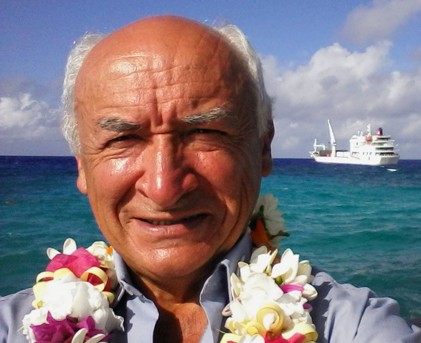
Co u mnie słychać?
| News for my friends worldwide... | Wiadomości dla moich przyjaciół... |
| What's new ? |
|
Co u mnie słychać? |
|
On July 22nd, 2025, my friends and I celebrated the 40th anniversary of Wojtkówka. There were numerous toasts, good music, delicious cakes prepared by the ladies, reminiscing videos from similar gatherings years ago, and, to conclude, a video report from my last expedition to Antarctica, "In Search of Emperor Penguins." |
22 lipca 2025 razem z moimi przyjaciółmi celebrowaliśmy 40-lecie Wojtkówki. Były liczne toasty, dobra muzyka, znakomite ciasta przygotowane przez panie, wspomnieniowe filmy z podobnych spotkań przed laty, a na zakończenie - filmowa relacja z mojej ostatniej ekspedycji na Antarktydę "W poszukiwaniu cesarskich pingwinów" |
|
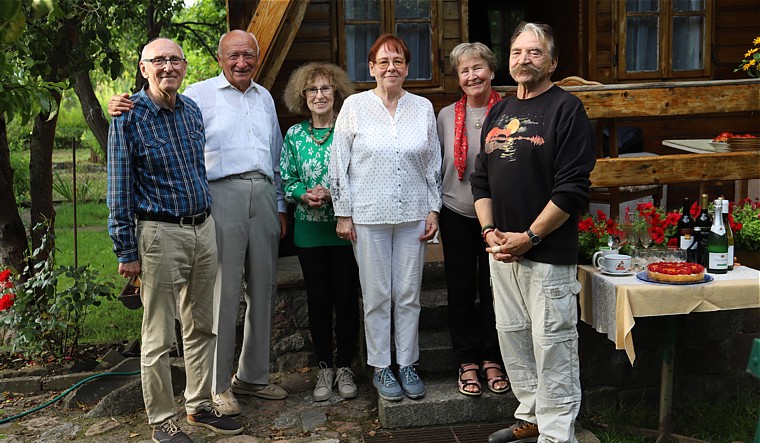 |
||
|
fAt similar gatherings five and ten years ago, there were more of us. Unfortunately, several people couldn't make it this time, and others simply passed away. We drank to their health and reminisced about old times. Everyone considered the gathering among the Wojtkówka flowers a great success! |
Na podobnych spotkaniach 5 i 10 lat temu było nas więcej. Niestety kilka osób nie mogło tym razem przybyć, a inni po prostu w międzyczasie od nas odeszli. Piliśmy ich zdrowie wspominając dawne czasy i wydarzenia. które towarzyszyły budowie mojej daczy. Wszyscy uznali spotkanie wśród kwiatów Wojtkówki za bardzo udane! |
|
|
|
|
|
|
In July, like last year, I invited my grandson Kuba on a short trip to countries he hadn't seen before: Latvia and Estonia. We were lucky with the weather – the sun was shining where we were, even though it was raining a hundred kilometers away. The trip began with a budget flight to Riga, the capital of Latvia: |
W lipcu, wzorem ubiegłego roku zaprosiłem mojego wnuka Kubę na krótki wspólny wyjazd do nieznanych mu krajów: Łotwy i Estonii. Mieliśmy szczęście do pogody - tam gdzie akurat przebywaliśmy świeciło słońce, choć sto kilometrów dalej padał deszcz. Wyprawa rozpoczęła się od lotu tanią linią do Rygi - stolicy Łotwy: |
|
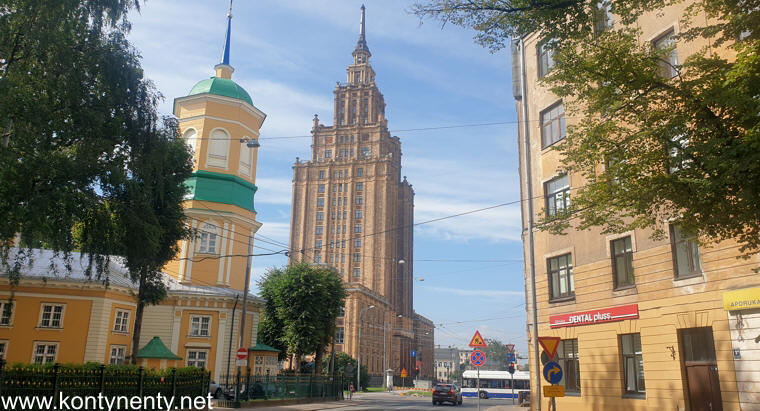 |
||
|
From the airport, we took bus number 22 to the city center for €1.50. The last stop on this line is at the so-called Moskovsky Suburb. Because we didn't get off at the train station but rode to the end of the line, I was able to see a building once donated to Latvians by Soviet comrades. We have a similar, only larger, building in Warsaw... |
Z lotniska autobusem 22 za 1,50 euro przyjechaliśmy do centrum. Ostatni przystanek tej linii znajduje się na tzw. Moskiewskim Przedmieściu. Dzięki temu, że nie wysiedliśmy przy dworcu tylko pojechaliśmy do końca linii mogłem zobaczyć budynek podarowany kiedyś Łotyszom przez radzieckich towarzyszy. Mamy podobny, tylko większy w Warszawie... |
|
 |
||
|
The symbol of this city, situated on the Daugava River, is the tall tower of St. Peter's Church, standing in the center of the old town. It can be seen in the photo above. The old town, listed as a UNESCO World Heritage Site, has been beautifully restored (with significant involvement of Polish specialists). Its most beautiful landmark is the former headquarters of the Brotherhood of Blackheads: |
Symbolem tego miasta, położonego nad rzeką Dźwiną (po łotewsku Daugava) jest wysoka wieża kościoła Świętego Piotra, stojącego w centrum starego miasta. Widać ją na zdjęciu powyżej. Stare miasto, które wymienione jest na liście World Heritage UNESCO zostało pięknie odrestaurowane (z dużym udziałem polskich specjalistów). Najpiękniejszym jego obiektem jest dawna siedziba Bractwa Czarnogłowych: |
|
|
|
||
|
This magnificently decorated building stands in the old market square, separated from the river by a modern, black museum building. It doesn't quite fit in with the square's older buildings, including the town hall with its white tower (photo below). |
Ten wspaniale zdobiony budynek stoi przy starym rynku, odgrodzonym od rzeki nowoczesnym, czarnym budynkiem muzeum. Niezbyt pasuje on do starej zabudowy placu. W tym do ratusza z białą wieżą (zdjęcie poniżej). Na pierwszym planie widać pomnik łotewskich strzelców: |
|
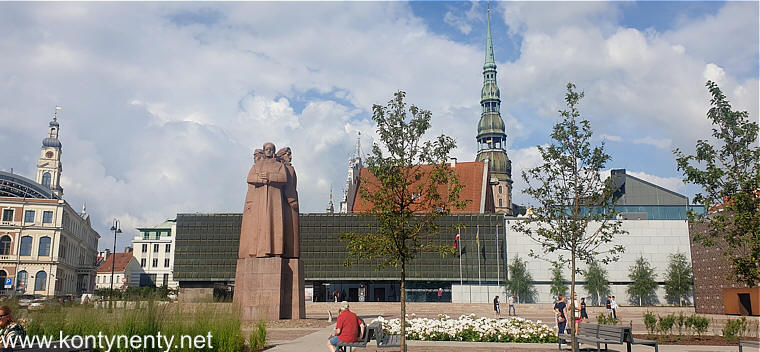 |
||
|
m On the outskirts of the old town, on the riverside, stands the Teutonic Castle. Its construction began in the 14th century. Currently, the castle is the residence of the President of Latvia: |
Na obrzeżu starego miasta od strony rzeki stoi zamek krzyżacki. Jego budowę rozpoczęto w XIV wieku. W chwili obecnej zamek jest rezydencją prezydenta Łotwy: |
|
|
|
||
|
On the opposite side of the old town, near the city canal that cuts through beautiful parks, we found the impressive opera house with a beautiful fountain, where tourists take photos: |
Po przeciwnej stronie starego miasta, w pobliżu miejskiego kanału przecinającego ładne parki znaleźliśmy okazały budynek opery, z ładną fontanną, przy której fotografują się turyści: |
|
|
|
||
|
Across the city canal, the tall column of the Freedom Monument (photo below) catches your eye. A little further on, nestled in an avenue of neatly trimmed trees, you'll find the Orthodox Cathedral of the Nativity of Christ – a beautiful church built between 1876 and 1883. During the communist era, it housed a café and a planetarium (photo on the right column)... |
Po drugiej stronie miejskiego kanału zwraca uwagę wysoka kolumna Pomnika Wolności (zdjęcie po lewej). Nieco dalej, w alei ładnie przystrzyżonych drzew znajdziecie prawosławny Sobór Narodzenia Pańskiego - piękną świątynię zbudowaną w latach 1876-83. W latach komunizmu wewnątrz była kawiarnia i planetarium... |
|
|
|
|
|
|
We were lucky—the cathedral was open that day, and a service was being held inside. For the first time in his life, my grandson was able to see the interior of an active Orthodox church, listen to religious chants, and admire the Byzantine-style mosaics on the walls: |
Mieliśmy szczęście - tego dnia sobór był otwarty i wewnątrz odprawiano nabożeństwo. Mój wnuk po raz pierwszy w życiu mógł zobaczyć wnętrze czynnej prawosławnej świątyni, posłuchać religijnych śpiewów i przyjrzeć się mozaikom w stylu bizantyjskim umieszczonym na ścianach: |
|
|
|
||
|
Photography is not permitted inside the cathedral, but if you're discreet (like me), you can take this interesting photo with your phone. From the cathedral, we returned to the river. On the other side, the modern structure of the National Library, resembling an iceberg, catches your eye: |
Wewnątrz soboru nie wolno fotografować, ale jeśli ktoś jest dyskretny (jak ja) to można telefonem zrobić takie ciekawe zdjęcie. Z soboru wróciliśmy nad rzekę. Po jej drugiej stronie zwraca uwagę nowoczesna bryła Biblioteki Narodowej, przypominająca górę lodową: |
|
|
|
||
|
Just a souvenir photo of the two travelers—the grandson and grandfather—in front of the "RIGA" sign on the market square, and we were off to the bus station. We bought our FlixBus tickets to Tallinn in advance online. They cost 50 złoty each way. After a 4.5-hour journey, we disembarked at the Tallinn bus station (picture on the right column) |
Jeszcze tylko pamiątkowe zdjęcie dwóch podróżników - wnuka i dziadka przed napisem "RIGA" na rynku i już musieliśmy iść na dworzec autobusowy. Bilety na FlixBus do Tallina kupiliśmy z wyprzedzeniem w internecie. Kosztowały po 50 złotych na osobę w każdą stronę. Po 4,5 godzinach jazdy wysiedliśmy na dworcu autobusowym w Tallinie: |
|
|
|
|
|
|
This was my third visit to Tallinn, and I must admit I was pleasantly surprised by the number of modern buildings that have recently been constructed there. It was a completely new Tallinn: |
To była moja trzecia wizyta w Tallinie i muszę przyznać, że byłem pozytywnie zaskoczony ilością nowoczesnych budynków, które tam ostatnio wzniesiono. To był zupełnie nowy Tallin: |
|
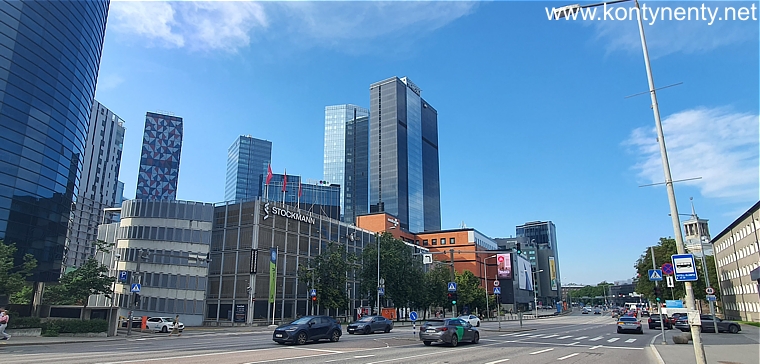 |
||
|
But travelers come here primarily to admire the atmospheric Old Town, which UNESCO has designated a World Heritage Site. So, after leaving our luggage at our accommodation, we began our tour of the Estonian capital from the flower-filled Old Town Square: |
Ale podróżnicy przyjeżdżają tu, aby oglądać przede wszystkim nastrojowe Stare Miasto, które UNESCO umieściło na liście World Heritage. Pozostawiwszy zatem bagaż na naszej kwaterze zaczęliśmy zwiedzanie stolicy Estonii od ukwieconego Staromiejskiego Rynku: |
|
|
|
||
|
Tallinn's Old Town is surrounded by a ring of defensive walls with several sturdy gates. The photo below shows at the end of the street entrance gate from the port side. We first went to this one: |
Stare Miasto w Tallinie otoczone jest pierścieniem murów obronnych z kilkoma solidnymi bramami. Na zdjęciu poniżej w perspektywie ulicy widać bramę wprowadzającą do miasta od strony portu. Do niej na początku poszliśmy: |
|
|
|
||
|
Inside this gate is a plaque commemorating the daring escape of the Polish submarine "Orzeł" from Tallinn port. This occurred in September 1939 – in the early days of World War II. For every Polish patriot, this is a very significant place: |
Wewnątrz tej bramy umieszczona jest tablica upamiętniająca brawurową ucieczkę z portu w Tallinie polskiego okrętu podwodnego "Orzeł". Było to we wrześniu 1939 roku - w pierwszych dniach drugiej wojny światowej. Dla każdego polskiego patrioty jest to bardzo znaczące miejsce: |
|
|
|
|
|
|
From the port gate we continued through the labyrinthine streets of the old town towards the castle hill of Toompea, where we found the so-called Steinbock House - the historic seat of the Estonian government. |
Od portowej bramy poszliśmy dalej przez labirynt uliczek starego miasta w kierunku zamkowego wzgórza Toompea, gdzie znaleźliśmy tzw. Dom Steinbocka - zabytkową siedzibę rządu Estonii. |
|
 |
||
|
But the most eye-catching attraction on Castle Hill is the Orthodox Alexander Nevsky Cathedral. It was built in the late 19th century, when Estonia was a governorate of the Russian Empire. Unfortunately, we found this cathedral closed. It is smaller than the one in Riga: |
Ale na zamkowym wzgórzu najbardziej przyciąga uwagę prawosławny Sobór Aleksandra Newskiego. Zbudowano go pod koniec XIX wieku, w czasach, gdy Estonia była gubernia Cesarstwa Rosyjskiego. Niestety zastaliśmy tę świątynię zamkniętą. Jest on mniejsza od tej w Rydze: |
|
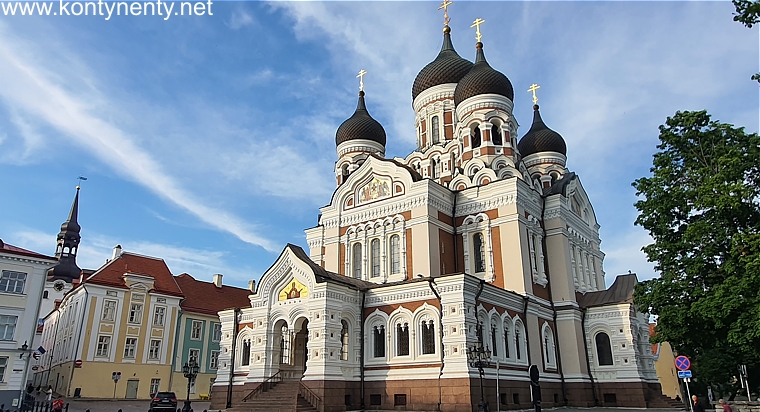 |
||
|
After spending the night in Tallinn, we took a bus back to Riga for our evening flight to Gdansk. It was a very successful trip! |
Po nocy spędzonej w Tallinie autobusem wróciliśmy do Rygi, aby wieczorem odlecieć do Gdańska. To była bardzo udana podróż! |
|
|
My friend from Gdańsk—an experienced traveler, mountaineer, and sailor named Michał Kochańczyk—celebrated his 75th birthday this spring. A number of events marked the occasion. On July 6th, I was invited to a sailing festival in Chałupy on the Hel Peninsula: |
Mój przyjaciel z Gdańska - znamienity podróżnik, alpinista i żeglarz Michał Kochańczyk celebrował tej wiosny swoje okrągłe 75-te urodziny. Z tej okazji odbyło się szereg imprez. 6 lipca byłem zaproszony na festyn żeglarski w Chałupach na Półwyspie Helskim: |
|
|
|
|
|
|
The festival featured many attractions. A large group of sailors arrived in historical costumes on their bay boats, the pomerankas, bringing the royal yacht mail. At the end, the birthday boy gave an interesting lecture about his journey through the Northeast Passage. Taking advantage of the opportunity, the festival participants repeatedly asked me for photos together. Happy birthday, Michał! |
Na festynie mieliśmy wiele atrakcji. Spora grupa żeglarzy przybyła w historycznych strojach na swoich zatokowych łodziach - pomerankach, przywieźli królewską pocztę jachtową, a na zakończenie jubilat wygłosił ciekawą prelekcję o swojej podróży przez Northeast Passage. Korzystając z okazji uczestnicy festynu wielokrotnie prosili mnie o wspólne fotografie. Happy Birthday Michale! |
|
 |
||
|
Meanwhile, I spend all the sunny days, as every year, in my Wojtkówka, working, eating fresh vegetables and feasting my eyes on the flowers that bloom one by one: |
Ja tymczasem wszystkie pogodne dni spędzam jak co roku w mojej Wojtkówce, pracując, objadając się świeżymi warzywami i ciesząc oczy rozkwitającymi kolejno kwiatami: |
|
|
|
||
|
The irises and peonies bloomed exceptionally beautifully this year, and now the first roses are blooming. In the evenings, while listening to good music, I prepare illustrated travel reports. And I've accumulated a lot, as I've already made five trips since the beginning of 2025! I'd like to keep the records on my website up to date. |
Wyjątkowo pięknie kwitły w tym roku irysy i piwonie, teraz zakwitają pierwsze róże. Wieczorami, po pracy w ogrodzie, słuchając dobrej muzyki przygotowuję ilustrowane raporty z podróży. A uzbierało się tego sporo, bo od początku 2025 roku odbyłem już 5 podróży! Chciałbym, aby zapisy w moim serwisie internetowym były aktualne. |
|
 |
||
|
|
Na początku czerwca przebywał tranzytem w Gdańsku Jorge Sanchez - jeden z najwybitniejszych podróżników Hiszpanii. Ucieszyłem się, że mogłem choć przez chwilę być razem z moim starym przyjacielem i poznać przy okazji jego żonę i syna. Do zobaczenia jeszcze w tym roku, Jorge!
At the beginning of June, Jorge Sanchez, one of Spain's most distinguished travelers, was transiting through Gdansk. I was delighted to be able to spend some time with my old friend and meet his wife and son. See you later this year, Jorge! |
|
|
This past May, an old friend who lives in Florida visited me in Wojtkówka. The lovely guest enjoyed my chokeberry homemade liqueur! :) Janusz has seen many regions of the world. COVID once prevented us from traveling together from Japan to the Pacific. Now, for the fall of 2026, we're planning a joint trip to the South Pacific! |
W maju tego roku odwiedził mnie w Wojtkówce stary przyjaciel mieszkający na stałe na Florydzie. Miłemu gościowi smakowała moja nalewka z aronii! :) Janusz widział wiele regionów świata. Kiedyś COVID uniemożliwił nam wspólny wyjazd. Teraz na jesień roku 2026 planujemy wspólną podróż na Południowy Pacyfik! |
|
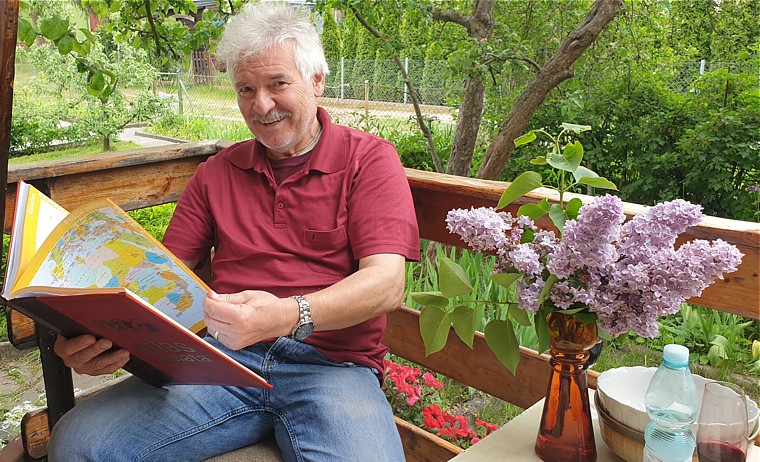 |
||
|
Costa shipping line offered me a chance to participate in a club cruise, organized on an unusual route only once a year. This year it was beginning of May They promised numerous attractions and privileges... And so I sailed, to see also the ports I haven't seen before. The voyage started with the low-cost flight from Gdansk to Barcelona. |
Linia żeglugowa Costa zaproponowała mi uczestnictwo w klubowym rejsie, organizowanym na nietypowej trasie tylko raz na rok. Tym razem na początku maja. Obiecywali mi liczne atrakcje i przywileje... No i popłynąłem, by przy okazji odwiedzić także nieznane mi dotąd porty. Podróż rozpoczęła się od lotu tanią linią z Gdańska do Barcelony. |
|
|
|
||
|
After landing in Barcelona, I set off to the port by the old, cheapest way: first by city bus 46 from the airport to Plaza Espanya. Then on foot past the Columbus Column and through Puente Europa to the ship. Unfortunately, it was raining lightly and I arrived at my destination slightly soaked. Fortunately, boarding went smoothly. It was my old friend: the "Costa Fascinosa" |
Po wylądowaniu w Barcelonie starym, najtańszym szlakiem wyruszyłem do portu: najpierw miejskim autobusem 46 z lotniska na Plaza Espanya. a dalej pieszo obok Kolumny Kolumba i przez Puente Europa do statku. Niestety padał drobny deszcz i do celu dotarłem lekko przemoczony. Zaokrętowanie na szczęście poszło sprawnie. To była moja stara znajoma: "Costa Fascinosa" |
|
|
|
||
|
The ship set sail that same day. The first port of call was supposed to be Marseille, but at the last minute it was changed to Toulon in France. Shipping lines sometimes play such tricks! In the morning we docked in a French port. But it wasn’t Toulon at all, but a poor quay on the other side of the bay, in the little town of Seyne: |
Statek wyruszył w rejs jeszcze tego samego dnia. Pierwszym portem na trasie miała być Marsylia, ale w ostatniej chwili zamieniono ją na francuski Toulon. Linie żeglugowe czasem płatają takie figle! Rano zacumowaliśmy we francuskim porcie. Ale nie był to wcale Toulon, ale skromne nabrzeże po drugiej stronie zatoki, w miasteczku Seyne: |
|
|
|
||
|
The cheapest way to get to Toulon is by public waterbus, which stops behind an old, abandoned shipyard. It takes about 20 minutes to walk from the ship to the stop. The conductor sells tickets for 2 euros... A faster alternative is the shuttle boat from our pier, but they charge 19 euros for a return ticket! |
Najtańszym sposobem na dostanie się do Tulonu jest publiczny tramwaj wodny, mający przystanek za starą, opuszczoną stocznią. Od statku do przystanku idzie się jakieś 20 minut. Konduktor sprzedaje bilety po 2 euro... Szybszą alternatywą jest shuttle boat z naszego nabrzeża, ale u nich za powrotny bilet żądają 19 euro! |
|
|
|
||
|
Toulon is the base of the French Navy. A waterbus sails past the grey-painted vessels. The French Mediterranean fleet is not very impressive today, but the opportunity to see it is certainly an additional attraction of this short cruise: |
W Tulonie jest baza francuskiej marynarki wojennej. Tramwaj wodny przepływa obok malowanych na szary kolor jednostek. Francuska flota Morza Śródziemnego nie jest dziś zbyt imponująca, ale możliwość jej oglądania jest na pewno dodatkową atrakcją tego krótkiego rejsu: |
|
|
|
||
|
When our waterbus reached its final stop at Toulon's seaside promenade, the sun shone for a moment and I was able to take colourful photos of the yachts moored right by the promenade, the palm trees on the square and finally the Maritime Alps, which provided a picturesque background for Toulon's architecture: |
Rejs trwał jakieś 25 minut. Gdy nasz tramwaj wodny dotarł do końcowego przystanku przy nadmorskiej promenadzie Tulonu na moment zaświeciło słońce i mogłem sfotografować w kolorach jachty zacumowane wprost przy promenadzie, palmy na skwerze i wreszcie Alpy Nadmorskie, będące malowniczym tłem dla architektury Tulonu: |
|
|
|
||
|
On the seaside promenade of Toulon (photo below) you will find many cafes and shops - this is the city's display window. The building with the French flag above the entrance is the mayor's office, or city hall. Despite the drizzle, a large group of people was waiting in front of the entrance for the newlyweds to leave: |
Na nadmorskiej promenadzie Tulonu (zdjęcie poniżej) znajdziecie wiele kawiarń i sklepów - to otwarte w kierunku morza okno wystawowe miasta. Budynek z francuską flagą nad wejściem to merostwo czyli ratusz. Mimo kropiącego deszczu przed wejściem czekała spora grupa osób czekających na wyjście nowożeńców: |
|
|
|
||
|
Several cross streets are filled with pretty, Art Nouveau tenement houses that have been transformed into pedestrian promenades. The local Notre Dame Cathedral is squeezed into the line of such buildings. It is worth taking a look inside its dark interior, if only for the pretty stained glass windows. And what else is worth seeing in Toulon? The Maritime Museum, located in the historic gate of the former arsenal. Admission costs 8 euros (6 euroa for cruise ship's passengers). |
Kilka poprzecznych ulic wypełnionych jest ładnymi, secesyjnymi kamienicami zamieniono na piesze deptaki. W linię takiej zabudowy wciśnięta jest tutejsza katedra Notre Dame. Warto zajrzeć do jej mrocznego wnętrza choćby dla ładnych witraży. I co jeszcze warto w Tulonie zobaczyć? Muzeum morskie, umieszczone w historycznej bramie dawnego arsenału. Wstęp kosztuje 8 euro, o dziwo pasażerowie statków wycieczkowych mają tutaj 2 euro zniżki :) |
|
|
|
||
|
Our farewell to Toulon was very spectacular. In full sunlight, the panorama of the bay and the city looked very impressive. Weather in the afternoon improowed. The morning clouds had completely disappeared. Such a postcard view can only be seen from the stern of a ship leaving the bay. In its strategic points on the shore, small defensive forts are visible. The old part of the city is visible on the left side of the photo - next to the yellow ferry: |
Bardzo spektakularne było nasze pożegnanie z Tulonem. W pełnym słońcu panorama zatoki i miasta prezentowała się bardzo efektownie. Poranne chmury całkowicie znikły. Taki pocztówkowy widok można zobaczyć tylko z rufy statku opuszczającego zatokę. W jej strategicznych punktach na brzegu widoczne są nie wielkie obronne forty. Stara część miasta widoczna jest po lewej stronie zdjęcia - obok żółtego promu: |
|
|
|
||
|
We picked up the Italian passengers the next day at the port of Savona. Unfortunately, the clouds had returned. Usually, I was only in transit in Savona, getting on or off a ship, because Savona is the main port of the Costa fleet. This time I had more time to walk around the city. The city's icon is the old defensive tower standing on the shore opposite the port: |
Włoskich pasażerów zabieraliśmy następnego dnia w porcie Savona. Niestety chmury wróciły. Zwykle w Savonie byłem tylko tranzytem, wsiadając na statek lub z niego wysiadając, bo Savona jest głównym portem floty Costy. Tym razem miałem więcej czasu na spacer po mieście. Ikoną miasta jest stara wieża obronna stojąca na brzegu naprzeciwko portu: |
|
|
|
||
|
Despite the light rain, I decided to go for a walk around the city. Savona may be appealing: along the main street, there are high arcades with shops and restaurants, like in Milan: |
Mimo drobnego deszczu zdecydowałem się wyjść na spacer po mieście. Savona może się podobać: wzdłuż głównej ulicy ciągną się, jak w Mediolanie wysokie podcienia ze sklepami i restauracjami: |
|
|
|
||
|
Savona also has its Old Town - a quarter of narrow streets arranged around the cathedral and the town hall. Those tourists who hurry straight to the ship do not know this side of the city. Maybe it is a good thing, because there are no crowds of tourists pushing through these atmospheric streets - like in Rome or Naples: |
Savona ma także swoje Stare Miasto - kwartał wąskich uliczek rozłożonych wokół katedry i ratusza. Ci turyści, którzy spieszą prosto na statek nie znają tej twarzy miasta. Może to i dobrze, bo nie przepychają się tymi nastrojowymi uliczkami tłumy turystów - jak w Rzymie czy Neapolu. Można w spokoju kontemplować urok starej architektury: |
|
|
|
||
|
I was surprised to find that in this district of Savona you can find tiny restaurants - family trattorias. They have their local regulars. And if a tourist comes here, he has the opportunity to feel like a family and will not pay an exorbitant price for a tasty Italian meal: |
Ze zdumieniem stwierdziłem, że w tej dzielnicy Savony znaleźć można maleńkie restauracyjki - rodzinne trattorie. Mają one swoich miejscowych bywalców. A jeśli trafi tu turysta, to ma okazję poczuć się jak w rodzinie i nie zapłaci wygórowanej ceny za smaczny włoski posiłek: |
|
|
|
||
|
It is worth visiting the beautiful cathedral, where the white marble sculptures attract attention (photo below). In the adjacent chapel there are wonderful frescoes, but you have to pay to enter the chapel. |
Warto zajrzeć do ładnej katedry, w której przyciągają uwagę rzeźby z białego marmuru (zdjęcie poniżej). W sąsiedniej kaplicy są wspaniałe freski, ale za wstęp do kaplicy trzeba już płacić. |
|
|
|
||
|
From Savona we sailed to the port of Civitavecchia, which offers the best and cheapest option for a full day trip to Rome. For those passengers who (in order to avoid expensive excursions from the ship) organize their own sightseeing, the port of Civitavecchia has one drawback: the passenger terminals are built at the end of a long promontory. The road to the city is long. You can walk it. Or you can use the free shuttle bus offered by the port. But first of all you have to wait for it, and secondly it goes not to the station or the center, but to a peripheral parking lot where taxi drivers are lurking :) |
Z Savony popłynęliśmy do portu Civitavecchia, który oferuje najlepszą i najtańszą możliwość całodziennej wycieczki do Rzymu. Dla tych pasażerów, którzy (aby uniknąć drogich wycieczek ze statku) organizują zwiedzanie na własną rękę port w Civitavecchia ma jedną wadę: pasażerskie terminale zbudowano na końcu długiego cypla. Droga do miasta jest długa. Można ją przejść. Albo skorzystać z darmowego shuttle-busu oferowanego przez port. Ale po pierwsze trzeba na niego czekać, a po drugie jedzie on nie na stację czy do centrum, ale na peryferyjny parking gdzie czyhają taksówkarze :) |
|
|
|
||
|
The road on the causeway can be seen in the photo above. It ends at the solid fortification of Forte Michelangelo. This fort once defended the entrance to the old port. It used to be open to visitors, but recently I found the gate closed. Maybe they are changing the exhibition? |
Drogę na cyplu widać na zdjęciu powyżej. kończy się ona koło solidnej fortyfikacji Forte Michelangelo. Ta forteczka broniła kiedyś wejścia do starego portu. Kiedyś można było ją zwiedzać, ale ostatnio zastałem bramę zamkniętą. Może zmieniają ekspozycję? |
|
|
|
||
|
Tourists usually turn right after the fort - onto the nice waterfront promenade. But the representative street of Civitavecchia is Largo Plebiscito (pictured below) where you will find many garden restaurants and cafes and a small theater. |
Turyści zazwyczaj skręcają za fortem w prawo - na ładną nadbrzeżną promenadę. Ale reprezentacyjną ulicą CIvitavecchia jest Largo Plebiscito (na zdjęciu poniżej) gdzie znajdziecie ogródkowe restauracje i kawiarnie oraz niewielki teatr. |
|
|
|
||
|
Not far from the largo there is a classicist cathedral, and in front of it a monument to Pope John Paul II, who was close to the Pole's heart: |
Niedaleko od largo stoi klasycystyczna katedra, a przed nią pomnik bliskiego sercu Polaka papieża Jana Pawła II: |
|
 |
||
|
For those cruise passengers who enjoy bazaars, Savona has a covered municipal market with a large selection of hats, T-shirts and other souvenirs offered at prices much lower than in the souvenir shops... |
Dla tych pasażerów, którzy lubią bazary, Savona ma zadaszone miejskie targowisko z dużym wyborem czapek, koszulek i innych pamiątek oferowanych po cenach znacznie niższych niż w sklepach z pamiątkami... |
|
|
|
||
|
Back on the ship, we finally had a full complement of passengers to embark on a this special club cruise to Istanbul and back. We were invited to meet the captain. On the open deck, hundreds of filled glasses were waiting to toast the arrival. The band was plaing, everybody was waiting for the captain. It was time to explain that these colorful liquids were soft drinks. The only wine offered was an Italian champagne officially called Pro-Seco: |
Po powrocie na statek mieliśmy nareszcie komplet pasażerów wyruszających wspólnie w klubowy rejs do Stambułu i z powrotem. Zaproszono nas na spotkanie z kapitanem. Na otwartym pokładzie czekały setki napełnionych kieliszków, którymi mieliśmy wznieść powitalny toast. Pora wyjaśnić, że te kolorowe płyny to napoje bezalkoholowe. Jedynym oferowanym winem był włoski szampan nazywany oficjalnie Pro-Seco: |
|
|
|
||
|
The captain - an Italian welcomed the passengers in several languages (mostly reading from a piece of paper). He also introduced "the second after God" on passenger ships - the director of the hotel section (in the photo below he is standing behind him). You have to report any problems to this guy! We made a toast and the band played for dancing. The captain disappeared. This is the standard course of such events: |
Pan kapitan - Włoch powitał pasażerów w kilku językach (przeważnie czytając z kartki) Przedstawił też "drugiego po Bogu" na pasażerskich statkach - dyrektora części hotelowej (na zdjęciu poniżej stoi on za nim). Do tego gościa trzeba zgłaszać wszelkie wasze problemy! Wznieśliśmy toast i zespół muzyczny zagrał do tańca. Kapitan znikł. To standardowy przebieg podobnych imprez: |
|
|
|
||
|
I was happy because the next day I was finally going to see the first unknown port of our route. It was the historic Siracusa, located in the south of Sicily. Shortly after crossing the picturesque Strait of Messina I saw a city whose old part is located on a peninsula (or rather island) jutting out into the sea - this is Ortigia. At the end of the peninsula stands Castello Maniace - a large fort guarding the entrance to the port: |
Cieszyłem się, bo następnego dnia miałem nareszcie zobaczyć pierwszy nieznany mi port naszej trasy. Była to historyczna Siracusa, położona na południu Sycylii. Wkrótce po przejściu przez Cieśninę Messyńską zobaczyłem miasto, którego stara część położona jest na wysuniętym w morze półwyspie - to Ortigia. Na końcu półwyspu (czy raczej wyspy) stoi Castello Maniace - duży fort strzegący wejścia do portu: |
|
|
|
||
|
Siracusa has only one pier for large ships. You go down from it directly to the new part of the city - it was there that we carefully docked. Here you don't need any shuttle bus to go sightseeing: |
Siracusa ma tylko jedno nabrzeże dla dużych statków. Schodzi się z niego wprost do nowej części miasta - przy nim właśnie ostrożnie zacumowaliśmy. Tu nie trzeba żadnego shuttle-busa aby wyruszyć na zwiedzanie: |
|
|
|
||
|
I quickly left the ship, curious about this new city for me. The architecture of the center of Syracuse is typical of the towns of the Italian south: two-story tenement houses with blinds on the windows predominate, which protect against the intense effects of the sun on hot days: |
Szybko opuściłem statek, ciekaw tego nowego dla mnie miasta. Architektura centrum Syrakuz typowa jest dla miasteczek włoskiego południa: przeważają dwupiętrowe kamienice z żaluzjami na oknach, które w upalne dni chronią przed intensywnym działaniem słońca: |
|
|
|
||
|
The old, historic city of Syracuse - Ortigia is connected by three bridges to the mainland of Sicily, which makes purists think that Ortigia is an island. Let it be! It took me fifteen minutes to reach the central bridge. On the other side of the sea channel I found myself in a maze of narrow streets: |
Stara, historyczna dziennica Syrakuz - Ortigia połączona jest trzema mostami ze stałym lądem Sycylii, co sprawia, że puryści uważają, że Ortigia jest wyspą. Niech będzie! Dojście do środkowego mostu zabrało mi kwadrans. Po drugiej stronie morskiego kanału znalazłem sie w labiryncie wąskich uliczek: |
|
|
|
||
|
From the narrow streets I emerged into a small square with the fenced ruins of the Temple of Apollo (Apollin) - the Greek patron of art and beauty. Its origins date back to the 6th century BC. It was built in the Doric style. In modern times, the temple housed a Christian church (Bizantine than Catolic), a mosque, and even the barracks: |
Z wąskich uliczek wyszedłem na niewielki plac z ogrodzonymi ruinami Świątyni Apolla (Apollina) - greckiego opiekuna sztuki i piękna. Jej początki sięgają VI wieku pne. Wzniesiono ja w stylu doryckim. W czasach nowożytnych w świątyni mieścił się kościół chrześcijański, meczet, a nawet koszary: |
|
|
|
||
|
Old Syracuse has its own atmosphere. Although the houses in the narrow streets have been rebuilt and beautified many times, you can still find some that are several thousand years old. The streets have a hard time accommodating the stream of tourists and the café tables: |
Stare Syrakuzy mają swój nastrój. Wprawdzie domy w wąskich uliczkach były wielokrotnie przebudowywane i upiększane, ale wciąż można tu znaleźć te, które mają kilka tysięcy lat. W uliczkach z trudnością mieści się strumień turystów i kawiarniane stoliki: |
|
|
|
||
|
A little more space can be found in the cathedral square - Piazza Duomo. The Catholic cathedral with a two-story colonnade on the façade is adjacent to the city government seat on this elongated square. Entrance to the cathedral costs 2 euros: |
Nieco więcej przestrzeni znaleźć można na placu katedralnym - Piazza Duomo. Katedra katolicka z piętrową kolumnadą na fasadzie sąsiaduje na tym wydłużonym placu z siedzibą miejskich władz. Za wstęp do katedry trzeba zapłacić 2 euro: |
|
|
|
||
|
Continuing towards the castello, I went out to the shore of the bay and discovered another interesting place: the Arethusa Spring. It is a small pool fed by a freshwater spring, in the middle of which grows a clump of papyrus (photo below). The poetic name of this nook comes from the mythical nymph Arethusa, who was chased by the river god Alpheus. Arethusa supposedly fled to Ortigia and turned into a spring. |
Podążając dalej w kierunku castello wyszedłem na brzeg zatoki i odkryłem kolejne ciekawe miejsce: Źródło Aretuzy. To niewielki basen zasilany ze słodkowodnego źródła, na środku którego rośnie kępa papirusów (zdjęcie poniżej). Poetyczna nazwa tego zakątka bierze się od mitycznej nimfy Aretuzy, która ścigana przez boga rzek Alfeusza. Aretuza ponoć uciekła na Ortigię i zamieniła się w źródło. |
|
|
|
||
|
The waterfront promenade (Italians call something like this lungomare) led me to the small castle, Castello Maniace, which I had previously seen from a ship. The castle is open to the public for a fee of 6 euros. There are no discounts! After asking the opinions of people who were leaving the building, I limited myself to photos of the courtyard taken from the gate. The moat and the main gate were the most picturesque: |
Nadbrzeżna promenada (Włosi nazywają coś takiego lungomare) doprowadziła mnie do zameczku Castello Maniace, który wcześniej oglądałem ze statku. Zamek udostępniony jest do zwiedzania za opłatą 6 euro. Zniżek nie ma! Po zasięgnięciu opinii ludzi, którzy wychodzili z obiektu poprzestałem na zdjęciach dziedzińca zrobionych z bramy. Najciekawiej prezentowała się fosa i główna brama: |
|
|
|
||
|
I returned to the bridges leading to Ortigia by a lungomare built on the other side of the island. On the shore, you can find small bastions and sections of defensive walls. Metal steps lead from these walls down to miniature beaches, where you can swim in clear water. Historic Syracuse unfortunately does not have wide, sandy beaches: |
Do mostów wprowadzających na Ortigię wracałem lungomare zbudowanym po drugiej stronie wyspy. Na brzegu znaleźć tu można małe bastiony i odcinki murów obronnych. Metalowe schodki prowadza z tych murów w dół - na miniaturowe plaże, gdzie można się kąpać w przejrzystej wodzie. Zabytkowe Syrakuzy nie mają niestety szerokich, piaszczystych plaż: |
|
|
|
||
|
As our ship approached the port, I noticed a structure jutting out from the new city, resembling a giant Christmas tree. Now I could go to the new part of the city to see this oddity up close. It turned out to be a church – the Sanctuary of Our Lady of Tears, opened in 1994. The reinforced concrete temple is 103 meters high: |
Gdy nasz statek zbliżał się do portu dostrzegłem wystającą ponad zabudowę nowego miasta budowlę kształtem przypominającą gigantyczną choinkę. Teraz mogłem pójść do nowej części miasta obejrzeć z bliska ten dziwoląg. Okazało się, że to kościół - otwarte w 1994 roku Sanktuarium Matki Bożej Płaczącej. Wykonana z żelbetonu świątynia ma 103 metrów wysokości: |
|
|
|
||
|
The austere interior of the church (pictured below) has two levels: a sanctuary and a crypt, and is designed on a circular plan with a diameter of 71 meters. It has been calculated that it can accommodate 6,000 worshippers sitting in pews and 11,000 standing. The name of the temple comes from the miraculous bas-relief of the Mother of God, on which tears appeared repeatedly in 1953. |
Surowe wnętrze kościoła (na zdjęciu poniżej) ma dwa poziomy: sanktuarium i kryptę i zaprojektowane jest na planie koła o średnicy 71 metrów. Obliczono. że może pomieścić 6000 wiernych siedzących w ławkach i 11000 stojących. nazwa świątyni bierze się od cudownej płaskorzeźby Matki Bożej na której w 1953 roku wielokrotnie pojawiały się łzy. |
|
|
|
||
|
On the outskirts of the city there is an ancient amphitheater and a necropolis, where tombs were carved in the rock. The complex contains the tomb of Archimedes, who lived in Syracuse. I wanted to see it. When I got there, it turned out that the entrance fee to the complex was 17 euros. In return, you don't get much, because the theater is covered with a roof for the time of conservation, and the tomb is not accessible. However, it turned out that by going right along the fence, you can reach a place where the tomb is visible through the pickets of the fence and take a picture through the fence. For free! |
Na peryferiach miasta jest starożytny amfiteatr oraz nekropolia, na terenie której grobowce wykuwane były w skale. w kompleksie jest grobowiec Archimedesa, który mieszkał w Syrakuzach. Chciałem go zobaczyć. Na miejscu okazało się, że za wstęp do kompleksu trzeba zapłacić 17 euro. W zamian otrzymuje się niewiele, bo teatr na czas konserwacji nakryty jest dachem, a grobowiec Archimedesa nie jest dostępny. Okazało się jednak, że idąc od wejścia w prawo wzdłuż płotu można dojść do miejsca, gdzie grób jest widoczny przez sztachety płotu i zrobić zdjęcie przez płot. Za darmo! :) |
|
|
|
||
|
In the evening, after leaving Syracuse, we were treated to a performance by an authentic string quartet at the theater. Against a beautiful backdrop (several hundred electronic candles and a nighttime view of the bay), these four ladies played beautifully. My only regret was that it wasn't classical music, but adaptations of contemporary pop hits. I hope to hear these talented artists again on another ship. |
Wieczorem, po wyjściu z Syrazuz w teatrze mogliśmy posłuchać występu autentycznego smyczkowego kwartetu, W pięknej scenografii (kilkaset elektronicznych świec i nocny widok na zatokę) te cztery panie grały bardzo pięknie. Żałowałem tylko, że nie była to muzyka klasyczna, ale adaptacje współczesnych przebojów muzyki pop. Mam nadzieję, że usłyszę te uzdolnione artystki ponownie na innym statku. |
|
|
|
||
|
The next day I woke up in Greece, in the port of Nafplio. I was here for the first time about 50 years ago, but I came by bus. There is no pier for large ships in this small port. As you can see in the photo below, a cruise ship anchors in the bay, and passengers are brought to the small port by tenders. In the morning you have to pick up tender ticket on the ship and wait for the call. |
Kolejnego dnia obudziłem się w Grecji, w porcie Nauplion. Byłem tu jakieś 50 lat temu, ale przyjechałem wtedy autobusem. W tym małym porcie nie ma nabrzeża dla dużych statków. Jak widać na zdjęciu poniżej statek wycieczkowy kotwiczy w zatoce, a pasażerowie dowożeni sa do małej przystani tenderami. |
|
|
|
||
|
On a high mountain above Nafplio, you can see the walls of the Venetian fortress, the city's biggest tourist attraction. I had climbed this fortress 50 years earlier. But now, the view from the ship gave a completely different, more interesting perspective: |
Na wysokiej górze ponad Nauplionem widać mury weneckiej twierdzy, która jest największą atrakcją turystyczną miasta. Wdrapywałem się do tej twierdzy 50 lat wcześniej. ale teraz spojrzenie ze statku dawało zupełnie inną, ciekawszą perspektywę: |
|
|
|
||
|
On a small island at the entrance to the port, in the old days, the Venetians built a small but picturesque castle, Burdzi. It defended the entrance to the old port, which is now a yacht marina. In this marina, they disembark us from the tenders. I got out. And soon I found myself on a beautiful promenade along the shore. |
Na małej wysepce u wejścia do portu w dawnych czasach Wenecjanie zbudowali niewielki, ale malowniczy zamek Burdzi. Bronił on wejścia do starego portu, w którym mieści się obecnie jachtowa marina. W tej marinie wysadzają nas z tenderów. Wysiadłem. I wkrótce znalazłem się na pięknej promenadzie biegnącej wzdłuż brzegu. |
|
|
|
||
|
This promenade, lined with carefully trimmed palm trees, runs to the base of the breakwater. There is a small bastion with a few old cannons there. But for me, the most important thing was the view that opens up from the bastion. Isn't it true that many people would like to receive such a beautiful postcard from Greece? So please print it out and send it: |
Ta promenada, wysadzona starannie przystrzyżonymi palmami biegnie do nasady falochronu. stoi tam niewielki bastion z kilkoma starymi armatami. Ale dla mnie liczył się przede wszystkim widok, który otwiera się z bastionu. Prawda, że wielu by chciało otrzymać taką piękną pocztówkę z Grecji? No to proszę sobie wydrukować i wysłać: |
|
|
|
||
|
Then I started climbing the narrow streets that run along the slope. Neighboring streets are connected by lanes of steps. In the dead-end alleys there are small, closed churches (St. Sofia in the photo below). This part of Nafplio has its own unique atmosphere. |
Potem zacząłem się wspinać wąskimi uliczkami, które biegną po zboczu. Sąsiadujące uliczki połączone są pasmami schodków. W zaułkach bez wyjścia usadowiły się małe, zamknięte cerkiewki (na zdjęciu poniżej Św. Sofia). Ten fragment Nauplionu ma swoją niepowtarzalną atmosferę. |
|
|
|
|
|
|
From these hillside streets, there is a great view of the red roofs of old Nafplio and the last part of the bay, where large and luxurious motor yachts are moored: |
Z tych uliczek na zboczu otwiera się widok na czerwone dachy starego Nauplionu i na końcowy fragment zatoki, w którym cumują duże i luksusowe motorowe jachty: |
|
|
|
||
|
From the narrow streets, through a stone gate, you enter the trail leading to the Acronauplia Castle (pictured below). This is the oldest fortified structure in Nafplio, built on the local acropolis. Apart from the walls and the tower built by the Crusaders, there is not much to see here, so it is not surprising that admission is free: |
Z wąskich uliczek przez kamienną bramę wchodzi się na szlak prowadzący do zamku Acronauplia (na zdjęciu poniżej). To najstarsza warowna budowla w Nauplionie, wzniesiona na miejscowym akropolu. Poza murami, wieżą zbudowaną przez Krzyżowców niewiele jest tu do zobaczenia, nie dziwi zatem fakt, że wstęp jest bezpłatny: |
|
|
|
||
|
The Acronauplion is located at the end of a promontory jutting out into the sea, as can be seen in the photo below, behind the empty skeleton of an abandoned hotel. In the lower part of the photo, you can see bastions decorated with slabs depicting the lion of St. Mark - this was the emblem of the Venetian Republic, which ruled here for some time: |
Acronauplion położony jest na krańcu cypla wysuniętego w morze, widać to na zdjęciu poniżej, za pustym szkieletem opuszczonego hotelu. W dolnej części zdjęcia widać bastiony ozdobione płytami z wizerunkiem lwa Św. Marka - to było godło Republiki Weneckiej, która przez pewien czas i tutaj panowała: |
|
|
|
||
|
The main fortress of Palamidi is located on the top of the neighboring hill, 216 meters above sea level. You have to practically go down to the town and start the arduous climb all over again. There are two routes to choose from. On the right side of the hill is the steep "path of 1000 steps" and on the left - the road that taxis and minibuses use to get there. I chose the steep path because it opens up more beautiful views: |
Główna twierdza Palamidi znajduje się na szczycie sąsiedniego wzgórza, 216 metrów nad poziomem morza. Trzeba praktycznie zejść do miasteczka i rozpocząć mozolną wspinaczkę od początku. Do wyboru są dwie trasy. Po po prawej stronie wzgórza stroma "ścieżka 1000 stopni" a po lewej - droga, którą wjeżdżają taksówki i mikrobusy. Ja wybrałem stromą ścieżkę, bo otwiera piękniejsze widoki: |
|
|
|
||
|
At the beginning of the stairs, it is written on a board that the entrance ticket to the fortress costs 20 euros. But you buy it only at the ticket office at the top. So if someone has a really modest budget, they can climb up to the gate and take the same photos from there as from the walls and then go down without any costs. Climbing zigzag up the steep slope is exhausting, especially in the heat. Take a sufficient supply of water! The steps are secured: |
Na początku schodów pisze na tablicy, że bilet wstępu do twierdzy kosztuje 20 euro. Ale kupuje się go dopiero w kasie na górze. Więc jeśli ktoś ma naprawdę skromny budżet to może wspiąć się do bramy i zrobić stamtąd takie same zdjęcia jak z murów a potem zejść w dół bez kosztów. Wspinaczka zygzakiem po stromym zboczu jest wyczerpująca, szczególnie w upale. Zabierzcie odpowiedni zapas wody! Schodki są zabezpieczone: |
|
|
|
||
|
Upstairs at the cash register it turned out that senior citizens from EU countries have a 50 percent discount, so I paid and was able to enter the fortress through the stone gate. The view from the terrace was amazing! The photo below shows, among other things, the path that you can take to get around the headland: |
Na górze przy kasie okazało się, że seniorzy z krajów UE mają tu 50 procent zniżki, więc zapłaciłem i mogłem przez kamienną bramę wejść do twierdzy. Widok z tarasu był rewelacyjny! na zdjęciu poniżej widać m.in. ścieżkę, którą cypel można obejść dookoła: |
|
|
|
||
|
On the fortress terrace, among other things, there's a deep well. And next to it, a flagpole, which I couldn't resist photographing. Somewhere in the distance, our ship can be seen anchored in the bay: |
Na tarasie twierdzy jest między innymi głęboka studnia. A obok niej - maszt flagowy przy którym nie omieszkałem się sfotografować. Gdzieś tam daleko widać nasz statek, kotwiczący w zatoce: |
|
|
|
||
|
On the terrace I met a group of Greek youth. They asked me with curiosity about my travels. They didn't want to believe that I had visited every country in the world. But you could check it immediately by calling up my website! We took a souvenir photo as we said goodbye: |
Na tarasie spotkałem grupkę greckiej młodzieży. Z ciekawością wypytywali mnie o moje podróże. Nie chcieli wierzyć, że odwiedziłem wszystkie kraje świata. Ale można to było natychmiast sprawdzić wywołując moja stronę internetową! Na pożegnanie zrobiliśmy sobie pamiątkowe zdjęcie: |
|
|
|
||
|
At the top of the fortress built by the Venetians there are several bastions. The one in which a Greek patriot was imprisoned is on display. Unfortunately, I did not have enough time to go around all the buildings, especially since I still had to go down a thousand steps to the town. It was a tough test for my knees! |
Na szczycie twierdzy zbudowanej przez Wenecjan jest kilka bastionów. Eksponowany jest ten, w którym więziono jakiegoś greckiego patriotę. Nie miałem niestety dość czasu, aby obejść wszystkie budowle, tym bardziej, że czekało mnie jeszcze zejście tysiącem schodów w dól - do miasteczka. Była to trudna próba dla moich kolan! |
|
|
|
||
|
We said goodbye to Nafplion at sunset. The evening promised to be warm. I waited on board for a spectacular show. It was worth it - it turned out to be the most beautiful sunset on this trip: |
Nauplion żegnaliśmy o zachodzie słońca. Wieczór zapowiadał się ciepły. Czekałem na pokładzie na spektakularne widowisko. Warto było - okazało się że był to najpiękniejszy zachód słońca w tej podróży: |
|
|
|
||
|
When I went on deck the next morning I saw that we were sailing in the middle of a narrow bay - like a fjord with mountainous, green shores. The shores of the bay were densely built up, among the white houses there were even groups of skyscrapers. These were already the suburbs of Izmir - the third largest city in Turkey, with almost 3 million inhabitants: |
Gdy następnego poranka wyszedłem na pokład zobaczyłem , że płyniemy środkiem wąskiej zatoki - jakby fiordu o górzystych, zielonych brzegach. Brzegi zatoki były gęsto zabudowane, wśród białych domów zdarzały się nawet grupy wieżowców. To były już przedmieścia Izmiru - trzeciego co do wielkości miasta Turcji, mającego prawie 3 miliony mieszkańców: |
|
|
|
||
|
I was in Izmir half a century ago, but I arrived there by bus. Now I could look at the city from the sea. Our ship docked at the edge of the commercial port. To the left we had an uninteresting industrial landscape. To the right - a view of a group of nice skyscrapers (photo below). An elegant and well-developed promenade began at the bay leading to the center of the old city: |
W Izmirze byłem pół wieku temu, ale przyjechałem tam autobusem. Teraz mogłem popatrzeć na miasto od strony morza. Nasz statek zacumował na skraju portu handlowego. W lewo mieliśmy nieciekawy krajobraz przemysłowy. Natomiast w prawo - widok na grupę ładnych wieżowców (zdjęcie poniżej). Przy niej rozpoczynała się elegancka i dobrze zagospodarowane promenada prowadząca wzdłuż brzegu zatoki do centrum starego miasta: |
|
|
|
||
|
The passenger terminal was small and filled with shops. There was no Wi-Fi! But there was an information office where you could get a city map. I turned left from the promenade, into the city promenade with tables of cafes and small restaurants: |
Terminal pasażerski był mały i wypełniony sklepikami. Nie było sieci wi-fi!. Ale było biuro informacji, gdzie można było dostać plan miasta. Skręciłem z promenady w lewo, w miejski deptak z wystawionymi stolikami kawiarń i małych restauracji: |
|
|
|
||
|
I decided to go to the large Kultur Park marked on the map. Its most interesting part is a pool surrounded by flower beds and sculptures. Fountains gush from the middle of the pool. The rest of the park is made up of playing fields and picnic areas - they don't make much of an impression: |
Postanowiłem dotrzeć do zaznaczonego na mapie dużego Kultur Park. Jego najciekawszym fragmentem jest basen otoczony kwiatowymi rabatami i rzeźbami. Ze środku basenu tryskają fontanny. Reszta parku to boiska i tereny piknikowe - nie robią one dużego wrażenia: |
|
|
|
||
|
After leaving the park, I spent a long time looking for the Catholic Cathedral of St. John. I finally found it behind a large school: closed, separated from the street by a high metal fence with barbed wire on top. The church is only open for a few hours a day. Apparently, the temple is heavily guarded. About a hundred meters away is the main intersection of the modern city: |
Po wyjściu z parku długo szukałem katolickiej katedry Św. Jana. Znalazłem ją w końcu za dużą szkołą: zamkniętą, odseparowaną od ulicy wysokim płotem z blachy z zasiekami na górze. Kościół otwierają tylko na kilka godzin dziennie. Najwyraźniej świątynia jest silnie chroniona. Jakieś sto metrów dalej jest główne skrzyżowanie nowoczesnego miasta: |
|
|
|
||
|
Izmir is the ancient Smyrna. The name Izmir was introduced only in 1930. Smyrna was founded by the Greeks in the 11th century BC. In Izmir you can see the remains of ancient buildings. The most famous is the agora located in the center of today's city. Entrance to the excavation complex costs 6 euros (payable in local currency - Turkish lira) |
Izmir to starożytna Smyrna. Nazwę Izmir wprowadzono dopiero w 1930 roku. Smyrnę założyli Grecy w XI wieku przed naszą erą. Można w Izmirze oglądać pozostałości starożytnych budowli. Najbardziej znana jest agora położona w centrum dzisiejszego miasta. Wstęp do kompleksu wykopalisk kosztuje 6 euro (płatne w miejscowej walucie - lirach tureckich) |
|
|
|
||
|
After leaving the agora, you just have to cross the busy street to find yourself at the entrance to an old, colorful bazaar. Everything is sold here: from gold products to plastic junk: |
Po wyjściu z agory wystarczy przejść na drugą stronę ruchliwej ulicy aby znaleźć się u wejścia do starego, barwnego bazaru. Handluje się tu wszystkim: od wyrobów ze złota do plastykowej tandety: |
|
|
|
||
|
There are probably four mosques hidden in the labyrinth of bazaar streets. I wanted to find the most important one - Hissar Mosque. It wasn't that easy, but by asking the locals I finally found myself in front of the entrance decorated with Turkish flags, and at the time of noon prayer. Men were washing their feet before entering. I left my shoes and went inside. Being discreet, I was even able to take a few photos of the temple's beautiful interior: |
W labiryncie bazarowych uliczek ukryte są chyba ze cztery meczety. Chciałem odnaleźć ten najważniejszy - Hissar Mosque. Nie było to takie proste, ale pytając miejscowych w końcu znalazłem się przed udekorowanym tureckimi flagami wejściem i to w porze południowej modlitwy. Mężczyźni myli nogi przed wejściem. Zostawiłem buty i wszedłem do środka. Zachowując się dyskretnie mogłem zrobić nawet kilka zdjęć ładnego wnętrza świątyni: |
|
|
|
||
|
It turned out that from the mosque it was close to Konak Square - the main square of the old city, and from there - to Konak Pier, where the former port warehouses were rebuilt into a cinema and shopping center. From there I walked along the waterfront promenade, passing hotels and palm-fringed squares. On one of them stands an equestrian statue of Ataturk - the Father of the Turks, who is considered a national hero in this country: |
Okazało się, że z meczetu już blisko to placu Konak - głównego placu starego miasta, a od niego - do przystani Konak Pier, gdzie dawne magazyny portowe przebudowano na kino i centrum sklepowe. Stąd poszedłem już nadbrzeżną promenadą mijając hotele i obramowane palmami place. Na jednym z nich stoi konny pomnik Ataturka - Ojca Turków, który w tym kraju uważany jest za narodowego bohatera: |
|
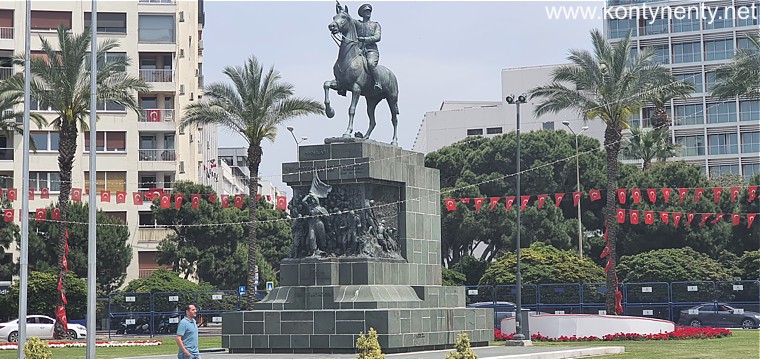 |
||
|
From Konak Square to the ship, it's a 4-kilometer walk along this beautiful seaside boulevard (picture below) On the way, in one of the many cafes, the waiter gave me the password to their network and I could send messages to my friends. I'm on the ship at "all aboard" time... It was an interesting day! |
Z placu Konak do statku są do przejścia 4 kilometry takim oto pięknym, nadmorskim bulwarem (zdjęcie poniżej). Po drodze w jednej z licznych kawiarń kelner dał mi hasło do ich sieci i mogłem wysłać wiadomości do przyjaciół. Na statku jestem o czasie "all aboard"... To był ciekawy dzień! |
|
|
|
||
|
In the evening we had a show in the theater by some dark-skinned star. The youth were delighted, but the seniors looked with amazement at the enthusiasm of the younger generation. In the morning we saw the misty Sea of Marmara. At 1 p.m. we docked at Galata Port - the passenger port of Istanbul. It was raining. It was my first time coming to Istanbul by ship. Despite the awful weather, I decided to go ashore. And from the beginning I was impressed - right after going down the gangway, you went underground. In Istanbul they built the first underground cruise terminal in the world!: |
Wieczorem mieliśmy w teatrze show jakiejś ciemnoskórej gwiazdy. Młodzież była zachwycona, ale seniorzy ze zdumieniem patrzyli na entuzjazm młodej generacji. Rano zobaczyliśmy zamglone Morze Marmara. O 13.00 zacumowaliśmy w Galata Port - pasażerskim porcie Istambułu. Padał deszcz. Pierwszy raz przybywałem do Stambułu statkiem. Mimo paskudnej pogody zdecydowałem się zejść na ląd. I od początku byłem pod wrażeniem - tuż po zejściu w trapu schodziło się tu do podziemia. W Stambule zbudowali pierwszy w świecie podziemny cruise terminal!: |
|
|
|
||
|
Fortunately, the sun shone in Istanbul that morning, and I was able to set off on foot to explore the city, starting by following the waterfront promenade towards the Golden Horn. Unfortunately, at the end of the promenade, the elegant Peninsula Hotel blocks my path, so I had to walk around it. |
Na szczęście rano w Stambule zaświeciło słońce i mogłem czym prędzej ruszyć ruszyć pieszo na zwiedzanie miasta - na początek nadbrzeżną promenadą w kierunku Złotego Rogu. Niestety przy końcu promenady drogę zagradza elegancki hotel Peninsula - trzeba go obejść dookoła. |
|
|
|
||
|
The Golden Horn is a small but very busy bay separating the old part of Istanbul from Galata. The photo below shows the beginning of the Golden Horn, with numerous mosques on the other side of the Golden Horn: |
Złoty Róg to niewielka, ale bardzo ruchliwa zatoka oddzielająca starą część Stambułu od Galaty. Na zdjęciu poniżej widać początek Złotego Rogu, z licznymi meczetami po drugiej stronie Złotego Rogu: |
|
|
|
||
|
On the first bridge over the Golden Horn, it's hard to find a free spot at the railing – so many anglers is fishing here every day! The bridge has a lower level, occupied by various restaurants and shops: |
Na pierwszym moście nad Złotym Rogiem trudno znaleźć wolne miejsce przy balustradzie - tyle tu wędkarzy każdego dnia! Most ma niższą kondygnację, zajętą przez różnego rodzaju restauracyjki i sklepiki: |
|
|
|
||
|
On the other side of the bridge, floating restaurants aboard small boats are a striking sight. During my first visit to Istanbul in 1975, this spot on the waterfront was selling fresh fish from fishing boats. On the hill above, the Suleiman the Great Mosque is awe-inspiring: |
Po drugiej stronie mostu zwracają uwagę pływające restauracje umieszczone na niewielkich statkach. Podczas mojej pierwszej wizyty w Stambule w 1975 roku w tym miejscu na nabrzeżu sprzedawano z rybackich łodzi świeże ryby... Na wzgórzu powyżej zachwyca Meczet Sulejmana Wspaniałego: |
|
|
|
||
|
If you look back, you can see the heavy traffic of ferries and pleasure boats at the entrance to the Golden Horn. In the background, you can see the high bridge connecting Europe and Asia. Once a day, you can take this inexpensive boat to the exit of the strait into the Black Sea. I booked a cruise like this during my previous visit: |
Jeśli obejrzeć się w tył, to widać, jak wielki ruch promów i spacerowych stateczków panuje u wejścia do Złotego Rogu. W tle widać wysoki most łączący Europę i Azję. Raz dziennie takim tanim stateczkiem można popłynąć aż do wyjścia z cieśniny na Morze Czarne. Wykupiłem taki rejs turystyczny podczas mojej poprzedniej wizyty: |
|
|
|
||
|
I followed the familiar path from the bridge along the tram line, soon ascending to the park beneath Topkapi Palace. The fresh greenery and fountains are delightful. But there's one problem: if you want to use the self-service toilet, you need a 5 lira coin, or the turnstile won't let you in. Credit cards are useless! The situation is repeated in many places in Istanbul. They should take into account that the one-day tourists, don't change money!: |
Znanym szlakiem pomaszerowałem od mostu wzdłuż linii tramwajowej, by wspiąć się wkrótce do parku pod pałacem Topkapi. Zachwyca tu świeża zieleń i fontanny. Ale jest jeden problem: jeśli chcesz skorzystać z samoobsługowej toalety, to musisz mieć monetę 5 lira, inaczej bramka cię nie wpuści. Karta kredytowa jest bezużyteczna! Sytuacja powtarza się w wielu punktach Stambułu: |
|
|
|
||
|
XXAbove the park, you'll find the walls of the Aya Sophia, a Byzantine temple converted into a mosque. The Aya Sophia is surrounded by scaffolding, but you can visit the interior after purchasing a ticket (it's best to book in advance online, as lines can be long). Ladies must cover their heads before entering! The fourth minaret, not pictured, is currently under renovation (the brick structure is being replaced with concrete): |
Powyżej parku wychodzi się pod mury Aya Sofia - bizantyjskiej świątyni przebudowanej na meczet. Aya obstawiona jest rusztowaniami, ale wnętrze można zwiedzać po zakupieniu biletu (najlepiej z wyprzedzeniem przez internet, bo kolejki są długie). Panie przed wejściem muszą nakryć głowy! Czwarty, niewidoczny na zdjęciu minaret jest aktualnie w remoncie (konstrukcję ceglaną zamienia się na betonową): |
|
|
|
||
|
Near Aya Sophia stands the famous Blue Mosque, which boasts six minarets. For a good view of both structures, you'll need to find the small, new Seven Hills Hotel. The hotel has a restaurant downstairs, and a small terrace on the top floor, accessible by free elevator. This terrace offers such views. Fortunately, there were no crowds—few people know about this place. |
W pobliżu Aya Sofia stoi słynny Błękitny Meczet, który ma aż 6 minaretów: Dla dobrego spojrzenia na oba obiekty trzeba odszukać mały, nowy hotelik Seven Hills. Hotel na dole ma restaurację, a na najwyższej kondygnacji ma mały taras, na który można bezpłatnie wjechać windą. To z niego otwierają się takie widoki. Tłumu na szczęście nie było - mało kto wie o tym miejscu: |
|
|
|
||
|
The Blue Mosque's vast courtyard is free to enter, and well worth it. But you can only enter the interior during prayer times. I don't know if they check if you're a follower of Allah :) |
Na rozległy dziedziniec Błękitnego Meczetu można i warto wejść bezpłatnie. Ale do wnętrza to tylko w porach modlitwy. Nie wiem, czy sprawdzają, czy jest się wyznawcą Allacha :) |
|
|
|
||
|
A large fountain has been built between Aya Sophia and the Blue Mosque, a popular spot for tourists to take photos. Sometimes you have to wait several minutes for the perfect photo opportunity. When I first visited Istanbul, on an overland trip to the Middle East in 1973, this fountain wasn't there yet: |
Pomiędzy Aya Sofia i Błękitnym Meczetem zbudowano wielką fontannę, przy której chętnie fotografują się turyści. Czasem na najlepszą pozycję do zdjęcia trzeba poczekać kilka minut. Gdy byłem w Stambule po raz pierwszy, jadąc overland na Bliski Wschód w 1973 roku tej fontanny jeszcze nie było: |
|
|
|
||
|
XXNext on my Istanbul itinerary was the old covered bazaar, Kapali Carsi. However, I hadn't anticipated one thing: it was Sunday, and the bazaar gates were closed for the holiday. But there was still trading in all the streets surrounding the bazaar: |
Dalej na moim szlaku wędrówki przez Stambuł był stary kryty bazar Kapali Carsi. Nie przewidziałem jednak jednego: była niedziela, a na świąteczny dzień bramy bazaru zamykają. Ale handlowano we wszystkich uliczkach otaczających bazar: |
|
|
|
||
|
I left the stalls behind and climbed the hill again – to the Suleymaniye Mosque, which I had admired that morning from the bridge over the Golden Horn. It was built in the 16th century, during the Sultan's reign, on one of Istanbul's seven hills. The mosque can accommodate 5,000 people. Its impressive dome measures 27.5 meters in diameter: |
Zostawiłem za sobą kramy i ponownie wspiąłem się na wzgórze - do meczetu Sulejmana Wspaniałego, który rano podziwiałem już z mostu na Złotym Rogu. Został zbudowany w XVI wieku, w czasach panowania tego sułtana na jednym z siedmiu wzgórz Stambułu. Świątynia może pomieścić 5000 ludzi. Jego imponująca kopuła ma 27.5 metra średnicy: |
|
|
|
||
|
Admission to the mosque is free, except for the removal of shoes. To preserve the mosque's religious functions, its interior is divided in half by a low barrier. You can see it on the picture below. The part of the interior adjacent to the mihrab — the alcove traditionally facing Mecca — is reserved for Muslims, who enter through a separate entrance: |
Wstęp do meczetu jest bezpłatny, trzeba jedynie zdjąć buty. Dla zachowania religijnych funkcji meczetu jego wnętrze podzielono niską barierką na połowę. Ta część wnętrza, która przylega do mihrabu - wnęki tradycyjnie skierowanej do Mekki jest przeznaczona dla wyznawców islamu, którzy wchodzą osobnym wejściem: |
|
|
|
||
|
The mosque's interior is very interesting, but an equally great advantage of this place is the view of Galata and the Bosphorus, which opens up from the garden surrounding the mosque. Tired tourists from the climb up the hill rest here on stone benches and have a picnic when they've had enough of admiring the views: |
Wnętrze meczetu jest bardzo ciekawe, ale równie wielką zaletą tego miejsca jest widok na Galatę i Bosfor, który otwiera się z ogrodu otaczającego meczet. Zmęczeni wspinaczką na wzgórze turyści odpoczywają tu na kamiennych ławach i piknikują, gdy mają już dość podziwiania widoków. W ogrodzie jest także grób sułtana i jego żony: |
|
|
|
||
|
Unfortunately, the foreground of this panorama has recently been spoiled by the placement of restaurant terraces on the roofs of houses built years ago on the hillside. Business has won here, and restaurant patrons have an even better view: |
Niestety pierwszy plan tej panoramy został ostatnio zepsuty przez umieszczenie tarasów restauracyjnych na dachach domów zbudowanych już przed laty na zboczu wzgórza. Biznes tu wygrał - klienci restauracji mają jeszcze lepszy widok: |
|
|
|
||
| It was a wonderful day, full of color, sunshine, and memories. I walked back to the ship, and after a spectacular departure from port, I had the opportunity to meet my captain at a reception. Italian Fabio Bramato, my 47th captain, turned out to be a very nice man. He introduced his officers. But Costa's cocktails are getting worse and worse! :) |
To był wspaniały dzień, pełen kolorów, słońca i wspomnień. Na statek wróciłem pieszo, a po spektakularnym wyjściu z portu miałem okazję poznać na przyjęciu mojego kapitana. Włoch Fabio Bramato - mój 47-my kapitan okazał się bardzo miłym człowiekiem. Przedstawił swoich oficerów. Ale cocktaile kompania Costa serwuje coraz gorsze! :) |
|
|
Dowiedziałem się, że w tym rejsie jest na pokładzie jeszcze jakaś para z Polski. Zgodnie z zasadami za pośrednictwem recepcji przesłałem im zaproszenie na spotkanie, ale nie odpowiedzieli. No cóż, nie wszyscy polscy imigranci przyznają się do polskiego obywatelstwa. Wolą pozostać anonimowi i tylko statkowa recepcja wie jakie mają paszporty... |
|
|
|
Our cruise was coming to an end. After a quite relaxind day at sea, we reached the picturesque Greek island of Zakynthos (the Poles write "Zakintos") The island is small, but famous for its unique landscape. I'd never been there before, and I had high hopes for this visit: |
Po dniu spędzonym w morzu dotarliśmy do malowniczej greckiej wyspy Zakhyntos (polska pisownia Zakintos). Wyspa jest niewielka, ale słynna jest ze względu na wyjątkowy krajobraz. Nigdy tu jeszcze nie byłem i wiele sobie po tej wizycie obiecywałem: |
|
|
|
||
|
The only port on Zakynthos doesn't accommodate large ships, only small ferries. Therefore, they transport us from the ship to the island free of charge in so-called tenders—large, covered motorboats that can accommodate up to 60 passengers. While this is an inconvenience, as you have to wait for your turn, you can still snap some great photos along the way: |
Jedyny port na Zakynthos nie mieści dużych statków, a jedynie niewielkie promy. Dlatego ze statku na wyspę wożą nas bezpłatnie tzw. tenderami - dużymi, krytymi motorówkami, mieszczącymi nawet 60 pasażerów. Choć to niedogodność, bo trzeba czekać na swoją kolejkę, to po drodze można zrobić kilka dobrych zdjęć: |
|
|
|
||
|
From the small port where we land amidst yachts and cruise ships, it's just a short walk to the town's central square, where you'll find a museum. Also worth visiting in town is the small but beautifully furnished Orthodox church: |
Z małego porciku, gdzie lądujemy wśród jachtów i statków wycieczkowych są tylko dwa kroki do centralnego placu miasteczka, gdzie znajdziecie muzeum. W miasteczku warto także odwiedzić małą, ale ładnie wyposażoną cerkiew: |
|
|
|
||
|
Zakhyntos is famous for its beautiful cliffs and sea caves, but above all for Shipwreck Bay and the hidden Navagio Beach, accessible only from the sea. To see this wonder, tourists rent a car and drive to a viewpoint on a high cliff. I couldn't find anyone willing to split the cost, so I opted for a two-hour boat trip, which had the advantage of allowing me to see the caves along the way, which are only visible from the sea. The ticket cost 50 euros, and there are no discounts. We were rocked hard by the high waves. The cliffs only began to form beyond the northeastern cape: |
Zakhyntos słynie ze swoich pięknych klifów, morskich grot, ale przede wszystkim z Zatoki Wraku i ukrytej w niej, dostępnej tylko od strony morza Plaży Nawajo. Aby zobaczyć to cudo turyści wynajmują samochód i jadą do punktu widokowego na wysokim klifie. Nie znalazłem chętnych do podzielenia kosztu i zdecydowałem się na 2-godzinny rejs stateczkiem, który miał tę przewagę, że pozwalał dodatkowo po drodze zobaczyć groty, dostrzegalne tylko od strony morza. Bilet kosztował 50 euro, zniżek nie ma! Na wysokiej fali solidnie nami bujało. Klify zaczęły się dopiero za płn-wsch. przylądkiem: |
|
|
|
||
|
The cliffs on this side of the island are high, wild, and barren. We struggled to take photos from the rocking boat. Everyone was captivated by the unique, almost dreamlike color of the water in the shallows: |
Klify po tej stronie wyspy są wysokie, dzikie i puste. Trudno nam było robić zdjęcia z rozkołysanej łodzi. Wszyscy byli zachwyceni wyjątkowym, bajecznym wręcz kolorem wody na płyciznach: |
|
|
|
||
|
We finally reached the famously picturesque Shipwreck Bay. In the bay, on a beach called Navajo Beach, the rusty wreck of a small cargo ship actually rests. The beach can only be reached from the sea, by small rubber boat or even kayak. The view was spectacular, but the sun's reflections spoiled my photos a bit: |
Dotarliśmy w końcu do słynnej z malowniczości Zatoki Wraku. Na plaży nazywanej Navajo spoczywa tu rzeczywiście zardzewiały wrak niewielkiego towarowego statku. Na plażę można dotrzeć tylko od strony morza, docierając tu niewielką łodzią gumową czy nawet kajakiem. Widok był rewelacyjny, tylko refleksy słoneczne zepsuły mi nieco moje zdjęcia: |
|
|
|
||
|
On the way back, we cruised close to land and explored one by one the beautiful coastal caves. At one point, there's a small beach by the pier where a boat docks for fifteen minutes, allowing you to take a short swim to one of these caves – there were even a few people who volunteered to bring swimsuits and towels from the hotel! |
W drodze powrotnej płynęliśmy blisko lądu i oglądaliśmy kolejno ładne nadbrzeżne groty. Koloryt wody też był niezwykły! W pewnym miejscu jest tu niewielka plaża przy molo, gdzie stateczek cumuje na kwadrans i można popłynąć na krótko do takiej groty - znalazło się nawet kilku chętnych, którzy zabrali z hotelu stroje i ręczniki! |
|
|
|
||
|
It was a very busy day. When we left Zakynthos in the evening, after dinner, we were invited to a farewell performance at the ship's theater. It was a superbly prepared musical, "Leonardo de Genius," with ballet and gymnastics elements. The performers received a well-deserved standing ovation from the audience: |
Był to bardzo pracowity dzień. Gdy wieczorem opuściliśmy Zakhyntos po kolacji zaproszono nas na pożegnalne przedstawienie w statkowym teatrze. Był to świetnie przygotowany spektakl muzyczny "Leonardo de genius" ze wstawkami baletowymi i gimnastycznymi. Wykonawcy zebrali zasłużone brawa stojącej publiczności: |
|
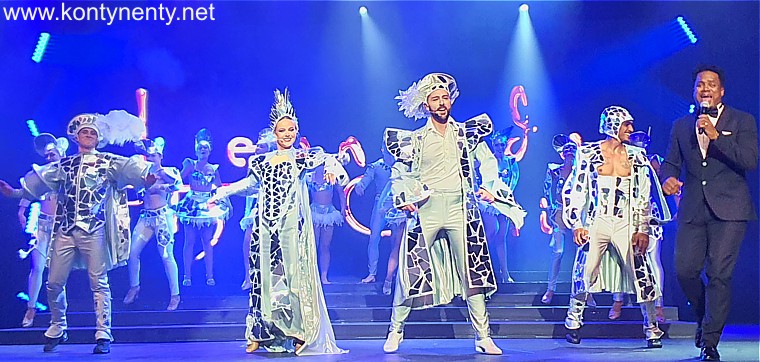 |
||
|
Two days later, I bid farewell to this charming ship in Barcelona, returning via Copenhagen to Gdańsk. Yet another successful trip! And the fact that I organized my own port visits significantly reduced the costs: |
Dwa dni później pożegnałem ten sympatyczny statek w Barcelonie, by przez Kopenhagę wrócić do Gdańska. Jeszcze jedna podróż zakończyła się pełnym sukcesem! A fakt, że organizowałem sobie zwiedzanie portów na własną rękę pozwolił znacznie obniżyć koszty: |
|
|
|
||
|
As always, you will find the "hot" news from the route of this trip in English in my travel log. |
Zapisane "na gorąco" wiadomości z trasy tej podróży znajdziecie jak zawsze w moim dzienniku podróży. |
|
|
At the end of April between my voyages I had only five days to enjoy the beauty of spring flowers in my Wojtkówka. The tulips were blooming exceptionally spectacularly this year: |
W końcu kwietnia między podróżami miałem zaledwie pięć dni, aby nacieszyć się pięknem wiosennych kwiatów w mojej Wojtkówce. Wyjątkowo efektownie kwitły w tym roku tulipany: |
|
|
|
||
|
As is the case in spring, there was a lot of work to be done in the garden. I work there every day, but I finished a lot of work only after returns from Costa cruise... :) |
Jak to wiosną bywa, w ogrodzie było wiele prac do wykonania. Pomocników niestety brak. Pracuję tam codziennie, ale sporo prac zakończyłem dopiero po powrocie z rejsu Costy... :) |
|
|
|
|
|
|
On April 25th, I completed another transatlantic journey in Gdansk! Instead of sitting at home in the cold of March and April, I flew again to the warm and exotic Brazil. I spent there a week enjoying the sun and Brazilian national drink - strong cachaca on the Atlantic coast, then boarded a ship that visited five Brazilian ports and then sailed to Europe, stopping for one day on the Cape Verde Islands. The great journey began with a low-cost flight from Gdansk to Alicante and then on Air Europa via Madrid to Sao Paulo. I managed to do it in just one day! |
25 kwietnia zakończyłem w Gdańsku kolejną transatlantycką podróż! Zamiast siedzieć w rodzinnym domu w marcowych i kwietniowych chłodach ponownie poleciałem do ciepłej i egzotycznej Brazylii. Spędziłem tam tydzień na atlantyckim wybrzeżu, a potem wsiadłem na statek, który odwiedził pięć brazylijskich portów, a potem popłynął do Europy, zatrzymując się dodatkowo po drodze na jeden dzień na Wyspach Zielonego Przylądka. Wielka podróż rozpoczęła się od lotu tanią linią do Alicante i potem Air Europa przez Madryt do Sao Paulo. |
|
|
|
Jak nigdy dotąd, na lotnisku Sao Paulo czekał na mnie brazylijski przyjaciel Roberto ze swoim kolegą. Poznałem go i jego sympatyczną rodzinę na statku płynącym do Europy. Słysząc, że po raz kolejny wybieram się do jego kraju spontanicznie zaoferował pomoc. Jakże miło było ponownie się spotkać! Polubiłem Brazylijczyków! As never before, at the Sao Paulo airport, my Brazilian friend Roberto and his colleague were waiting for me. I had met him and his nice family on a ship heading to Europe. Hearing that I was going to his country again, he spontaneously offered to help. How nice it was to meet again! |
|
|
In Roberto's car, telling of travels I drove as far as Santos on the Atlantic coast. Thank you, my friend and see you in Poland! |
Samochodem Roberto, opowiadając o podróżach dojechałem aż do Santos na wybrzeżu Atlantyku. Dziękuję przyjacielu i do zobaczenia w Polsce! |
|
|
|
||
|
I found well in advance an apartment in the suburb of Embare, two blocks from the not-so-clean beach. It was a nice place but without a/c and a seaview. Seaview costs much more! I did not complain enjoying such a view from the window: |
Znalazłem z dużym wyprzedzeniem na booking.com ładny apartament na przedmieściu Embare, dnie przecznice od plaży. To było ładne miejsce ale bez klimatyzacji i bez widoku na morze. Z widokiem na morze kosztuje więcej! Nie narzekałem, mając taki widok z okna: |
|
|
|
||
|
I didn’t miss the opportunity to remind myself of what the old part of Santos looks like. It’s the city of Brazilian coffee. I happened to come across it on a day when admission to the coffee museum, located in the ornate building of the former coffee exchange, was free: |
Nie omieszkałem wykorzystać okazji i przypomnieć sobie, jak wygląda stara część miasta Santos. To miasto brazylijskiej kawy. Trafiłem przypadkowo na na dzień, gdy był wolny wstęp do muzeum kawy zlokalizowanego w ozdobnym gmachu dawnej giełdy kawy: |
|
|
|
||
|
Small, primitive ferries (pictured below) take people free of charge to the other side of the estuary - to the holiday town of Guaraja. On the other side of the water, local buses wait to take those willing to the beaches (for a fee of about 5 reais): |
Małe, prymitywne promy (na zdjęciu poniżej) przewożą bezpłatnie ludzi na drugą stronę estuarium - do wczasowego miasteczka Guaraja [Guaradża]. po drugiej stronie wody czekają lokalne autobusy, zabierające chętnych na plaże (za opłatą około 5 reais): |
|
|
|
||
|
To start with, I chose Guaiba Beach, hidden in a deep bay framed by granite rocks. The sand here is cleaner than on the city beaches of Santos. Brazilians do not lie on the beach on blankets or mattresses. On every public beach, they rent tables and chairs and umbrellas. And they eat and drink at them... There are vendors of food and drinks... |
Na początek wybrałem plażę Guaiba, schowaną w głębokiej zatoce obramowanej granitowymi skałami, Piasek jest tu bardziej czysty, niż na plażach Santos. Brazylijczycy nie układają się na plaży na kocach czy materacach. Na każdej publicznej plaży wynajmują stoliki i krzesełka oraz parasole. I przy nich jedzą i piją... |
|
|
|
||
|
I walked around the green Pinto mountain visible in the photo below and walked along the wonderful Tombo beach. At its opposite end on the hill is the Galhetas viewpoint. It offers a wonderful view not only of the beach but of the entire area: |
Ja pieszo okrążyłem widoczną na zdjęciu poniżej zieloną górę Pinto i maszerowałem wzdłuż wspaniałej plaży Tombo. Na jej przeciwnym krańcu na wzgórzu jest punkt widokowy Galhetas. Otwiera się z niego wspaniały widok nie tylko na plażę, ale na całą okolicę: |
|
|
|
||
|
Another beach - Asturias was crowded and closed off by a concrete wall of tall apartment buildings. I escaped from this concrete resort to Santos, and already the next day I took a long-distance bus for 6 hours along the coastal road to Ubatuba. Interesting name, isn't it? Such a funny names fascinate me. In the past, I sometimes went off the trail to see what Langa-Langa or Tumbarumba looked like... Ubatuba turned out to be a charming seaside town with cobblestone streets: |
Kolejna plaża - Asturias była zatłoczona i zamknięta betonową ścianą wysokich apartamentowców. Uciekłem z tej betonowego wczasowiska do Santos, a następnego dnia dalekobieżnym autobusem jechałem 6 godzin nadmorską szosą Ubatuba. Ciekawa nazwa prawda? W przeszłości czasem specjalnie zjeżdżałem ze szlaku by zobaczyć jak wygląda Langa-Langa albo Tumbarumba... Ubatuba okazała się uroczym nadmorskim miasteczkiem o brukowanych uliczkach: |
|
|
|
||
|
Picturesque, mountainous coasts and numerous islands mean that many tourists set off on motorboat trips from here. For me, Ubatuba was also important for another reason. Namely, the Tropic of Capricorn runs through this town, and I, a Capricorn, wanted to take a picture of myself on it. I have taken pictures of myself on this Tropic in various places around the world - this was another opportunity: |
Malownicze, górzyste wybrzeża i liczne wysepki sprawiają, że wielu turystów wyrusza stąd na wycieczki motorowymi łodziami. Dla mnie Ubatuba ważna była również z innego powodu. Otóż przez to miasteczko przebiega Zwrotnik Koziorożca, na którym ja, koziorożec chciałem się sfotografować. Fotografowałem się na tym zwrotniku w różnych miejscach globu - to była jeszcze jedna okazja: |
|
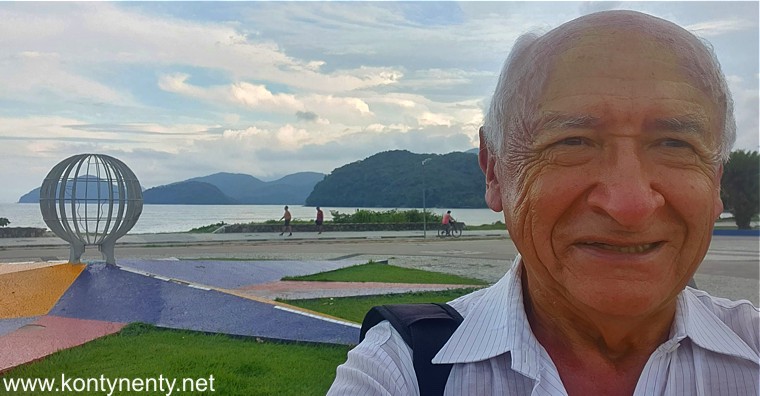 |
||
|
Along the route to Ubatuba there are many wild, narrow but beautiful beaches. You can stop here for a few hours, fish, swim and sunbathe to your heart's content. Only the infrastructure in such places is lacking: |
Wzdłuż trasy do Ubatuba jest wiele dzikich, wąskich ale pięknych plaż. Można tu się zatrzymać na kilka godzin, łowić ryby, pływać i opalać się do woli. Tylko infrastruktury w takich miejscach brak: |
|
|
|
||
|
I stopped along the way in yet another town with the strange name Caraguatatuba. Here, the several-kilometer-long beach was almost empty. It's a shame, because the scenery is fantastic: the landscape is closed by green mountains, and the color of the water is fantastic. The only inconvenience is the scorching Brazilian sun - you'll quickly learn that it's better to camp in the shade: |
Zatrzymałem się po drodze w jeszcze innym miasteczku o dziwnej nazwie Caraguatatuba. Tutaj kilkukilometrowa plaża była niemal pusta. Szkoda, bo sceneria jest fantastyczna: krajobraz zamykają ciekawie ukształtowane zielone góry, a koloryt wody jest fantastyczny. Jedyną niedogodnością jest to piekące brazylijskie słońce - szybko się przekonacie, że lepiej biwakować na piasku, ale w cieniu drzew: |
|
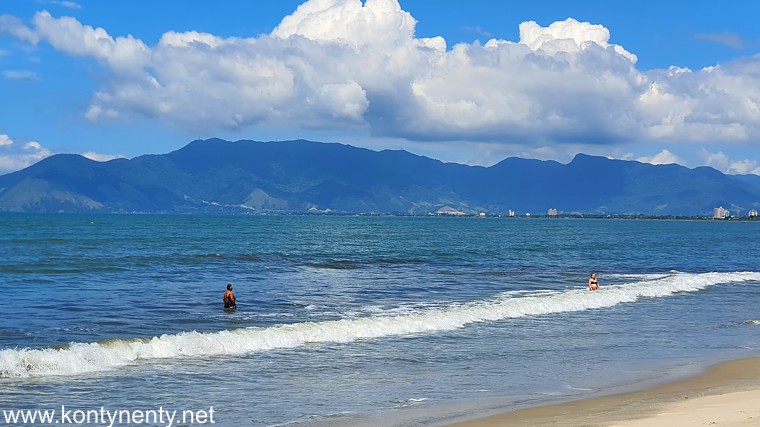 |
||
|
The traveler is enchanted at every step by the magnificent Brazilian nature: everywhere there is lush greenery and saturated colors of tropical flowers that are unknown on our continent: |
Wędrowca na każdym kroku zachwyca wspaniała brazylijska przyroda: wszędzie soczysta zieleń i nasycone kolory tropikalnych kwiatów, których na naszym kontynencie nie znamy: |
|
|
|
||
|
Along the Atlantic coast, smaller and larger islands are scattered, offering beaches, mountain trails and waterfalls. For us, this coast is little known... Returning from Ubatuba, I noticed a white spot of a passenger ship off the coast. It was an interesting coincidence, because the next day I was supposed to board this ship in Santos port: |
Wzdłuż atlantyckiego wybrzeża rozrzucone są mniejsze i większe wyspy oferujące plaże, górskie szlaki i wodospady. Dla nas to wybrzeże jest mało znane... Wracając z Ubatuba zauważyłem u brzegów takiej wyspy białą plamkę pasażerskiego statku. To był ciekawy zbieg okoliczności, bo już następnego dnia miałem wsiąść na ten statek w porcie Santos: |
|
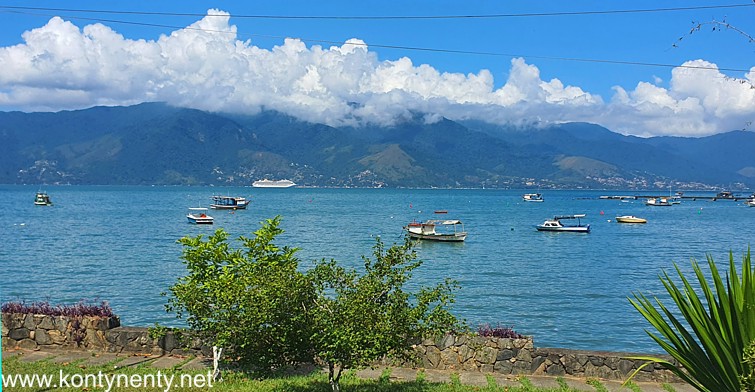 |
||
|
Our ship left the port of Santos only at dusk. Passengers were already pouring out onto the deck. I also had the opportunity to view the elegant waterfront promenade from a different perspective: |
Nasz statek opuszczał port w Santos dopiero o zmierzchu. Pasażerowie wylegli na pokład. Ja też miałem możliwość oglądania eleganckiej nadbrzeżnej promenady z innej perspektywy: |
|
|
|
||
|
The next day we were to dock in Rio de Janeiro. I got up before dawn because I knew that on the way to the terminal the ship would parade along all the famous beaches of Rio and Sugarloaf. -The only important thing is that the weather is good! It was good! |
Następnego dnia mieliśmy zawinąć do Rio de Janeiro. Wstałem przed świtem, bo wiedziałem, że w drodze do terminalu statek będzie defilował wzdłuż wszystkich słynnych plaż Rio i Głowy Cukru. -Ważne tylko, aby była pogoda! Była! |
|
|
|
||
|
Only the top of Corcovado with the statue of Christ standing there was covered in clouds. Even before we docked, I wondered how to spend a day in Rio. I had been to this city many times and it was hard to find a new destination. But I found one! I would take the metro to Sao Conrado - the first beach on the ocean side (on the left in the photo below). I had not been there yet and I did not know anyone who could say anything about this district. I set off on foot to the nearest metro station - Uruguaiana. |
Tylko szczyt Corcovado z ustawioną tam figurą Chrystusa otulony był obłokami. Jeszcze zanim zacumowaliśmy zastanawiałem się jak wykorzystać dzień w Rio. Byłem w tym mieście wielokrotnie i trudno było znaleźć sobie jakiś nowy cel. Ale znalazłem! Pojadę metrem do Sao Conrado - na pierwszą plażę od strony oceanu (z lewej strony na zdjęciu poniżej). Tam jeszcze nie byłem i nie znałem nikogo, kto mógłby o tej dzielnicy coś powiedzieć. Ruszyłem pieszo do najbliższej stacji metra - Uruguaiana. |
|
|
|
||
|
I bought a metro ticket for 7.50 reals. Only later will it turn out that seniors over 65 have free travel here, just show your ID. You will know that! :) When I leave Sao Conrado, a densely built-up district appears at the foot of steep, green mountains. Favelas squeeze high into the valleys between the slopes. I have only a 15-minute walk to the beach. The Sao Conrado's beach is beautiful and almost empty: |
Kupiłem bilet na metro za 7,50 reala. Dopiero potem okazało się, że seniorzy w wieku powyżej 65 lat mają tu bezpłatne przejazdy, wystarczy pokazać dokument. Wy już będziecie to wiedzieć! :) Gdy w Sao Conrado wyjeżdżam na powierzchnię ukazuje się gęsto zabudowana dzielnica u stóp stromych, zielonych gór. Favele wciskają się wysoko w doliny między zboczami. Do plaży mam zaledwie 15 minut marszu. Jest piękna i prawie pusta: |
|
|
|
||
|
Red flags stuck in the sand forbid swimming. Today the sun is shining brightly, but the waves are exceptionally high. The palm-lined promenade, like on Ipanema, is closed to the east by a massive granite massif of a mountain whose peak touches the clouds: |
Zatknięte w piasku czerwone flagi zabraniają jednak kąpieli. Króluje dziś wspaniałe słońce, ale fale są wyjątkowo wysokie. Wysadzana palmami jak na Ipanemie nadbrzeżna promenada zamknięta jest od wschodu potężnym masywem granitowym góry, której wierzchołek dotyka chmur: |
|
|
|
||
|
On the way back I stopped at Ipanema. The famous beach was crowded, the waves were equally high and there was a beautiful view of the rocky islands opposite the beach. I found out that it has become very fashionable for local women to show their whole buttocks on the beach... |
W drodze powrotnej zrobiłem sobie stopover na Ipanemie. Na słynnej plaży był tłok, fale równie wysokie i piękny widok na skaliste wysepki naprzeciw plaży. Przekonałem się, że wśród miejscowych pań bardzo modne stało się odsłanianie na plaży całych pośladków... |
|
|
|
|
|
|
|
||
|
At the end of the beach, Carlos Jobin is walking along the sidewalk - the creator of the popular song "Girl from Ipanema". Everyone can take a picture with him! :) I also found a girl from Ipanema, or even two. However, they did not want to have a picture with me: |
Przy końcu plaży idzie sobie chodnikiem Carlos Jobin - twórca popularnej piosenki "Girl from Ipanema" (Zdjęcie na lewej kolumnie). Każdy może się z nim sfotografować! :) Znalazłem też dziewczynę z Ipanemy, a nawet dwie. Te jednak nie chciały mieć ze mną zdjęcia: |
|
|
|
|
|
|
It was a very successful day for me. I discovered new wonderful place in Rio! We said goodbye to Rio that evening with music on board, but also with a great revue performance in the ship's theater. Every evening there were some shows, but this one was particularly good: |
To był dla mnie bardzo udany dzień. Rio żegnaliśmy tego wieczoru muzyką na pokładzie, ale także znakomitym przedstawieniem rewiowym w statkowym teatrze. Każdego wieczoru oferowano tam jakieś występy, ale ten był wyjątkowo udany: |
|
|
|
||
|
The next day we had a so-called day at sea - we could rest from the emotions and sort out our affairs (I did the laundry!) The next morning we reached Salvador in the state of Bahia. This is the most important center of Afro-Brazilian culture, placed on the UNESCO World Heritage list. I have been to Salvador many times, but it was impossible to resist a walk through the colorful streets of the old city. The locals welcomed us with music and dance on the pier: |
Następnego dnia mieliśmy tzw. dzień w morzu - można było odpocząć od emocji i uporządkować swoje sprawy (ja zrobiłem pranie!) Zaś kolejnego poranka dotarliśmy do Salvadoru w stanie Bahia. To najważniejszy ośrodek kultury Afro-Brazylijskiej, umieszczony przez UNESCO na liście World Heritage. Byłem w Salvadorze wielokrotne, ale nie sposób było sobie odmówić spaceru kolorowymi uliczkami starego miasta. Miejscowi witali nas muzyką i tańcem już na nabrzeżu: |
|
|
|
||
|
The security situation in Salvador has improved. Police with long guns are still present at critical points, but tourists are being allowed into areas of the old city that were previously closed. In the past, there was always a police car with a yellow sign (pictured below) and tourists were still not allowed in. Now it is different. |
Stan bezpieczeństwa w Salvadorze się poprawił. Policja z długą bronią wciąż jest obecna w newralgicznych punktach, ale wpuszcza się turystów do rejonów starego miasta, które przedtem były zamknięte. Dawniej pod biało- żółtym szyldem (na zdjęciu poniżej) stał zawsze policyjny samochód i turystów dalej nie wpuszczano. Teraz jest inaczej: |
|
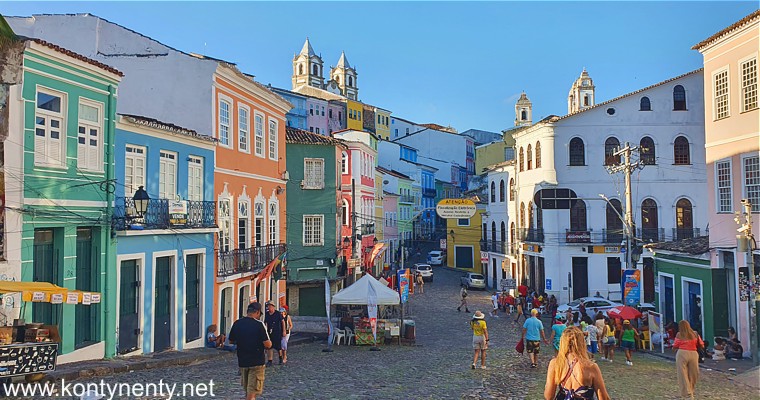 |
||
|
A few years ago, I bought a souvenir for friends in a small shop in the old town. I chatted with the owner, a nice retired sailor who had visited Poland before. When I looked into his shop now, he recognized me and greeted me warmly. What a memory! It was a very nice meeting after so many years: |
Kilka lat temu w małym sklepiku na starym mieście kupiłem pamiątkę dla przyjaciół. Pogadałem przy okazji z właścicielem - sympatycznym emerytowanym marynarzem, który odwiedził kiedyś Polskę. Gdy zajrzałem teraz do jego sklepiku rozpoznał mnie i serdecznie powitał. Co za pamięć! To było bardzo miłe spotkanie po latach: |
|
|
|
||
|
Soon I met my 46th captain - Italian master Stefano Boccaccio. He was surprised by my travel achievements. I can say that almost on all ships I am easily recognizable among thousands of passengers and liked by the crew. Maybe because I do not treat them as servants, but as sisters and brothers being someone who is curious about their private lives, and with each one, without exception, I can talk about his/her country: |
Wkrótce poznałem mojego 46-go kapitana - Stefano Boccaccio. Był zaskoczony moim podróżniczym dorobkiem. Mogę powiedzieć, że na wszystkich statkach jestem łatwo rozpoznawalny wśród tysięcy pasażerów i lubiany przez załogę. Być może dlatego, ze nie traktuję ich jak służbę, ale jako kogoś, kto ciekaw jest ich prywatnego życia, a z każdym bez wyjątku może rozmawiać o jego kraju... |
|
|
|
|
|
|
We sailed along the coast of the continent to the north. The next port on our Brazilian route was the port of Maceio. Unfortunately, the police behind the port gate politely but firmly turned back tourists heading to the city: -You'd better go to our beautiful beach! It's in the opposite direction! Maceio is already poor and not very safe Brazilian Nordeste. They do have a nice beach with sailboats waiting for tourists: |
Płynęliśmy wzdłuż brzegów kontynentu na północ. Następnym portem na naszym brazylijskim szlaku był port Maceio. Tu niestety policja za portową bramą grzecznie, ale stanowczo zawracała turystów kierujących się do miasta: - Idź lepiej na naszą piękną plażę! To w przeciwnym kierunku! Maceio to już biedne i niezbyt bezpieczne brazylijskie Nordeste. Plażę rzeczywiście mają ładną, z żaglówkami czekającymi na turystów: |
|
|
|
||
|
White tourists are rarely seen on this beach. Brazilian vacationers dominate. It is for them that the carts with drinks, traditional dishes and beachwear circulate here. And for them this water in the ocean - warm as the proverbial soup :) |
Białych turystów na tej plaży widzi się rzadko. Dominują brazylijscy urlopowicze. To dla nich krążą tu wózki z drinkami, tradycyjnymi potrawami i strojami plażowymi. I dla nich ta woda w oceanie - ciepła jak przysłowiowa zupa :) |
|
|
|
||
|
We were getting closer to the equator. The next day in Recife, the capital of the state of Pernambuco, we were greeted by colorfully dressed dancers and a band playing brass instruments. |
Byliśmy coraz bliżej równika. Już w dzień później w Recife - stolicy stanu Pernambuco witali nas kolorowo ubrani tancerze i zespół grający na instrumentach dętych. |
|
|
|
|
|
|
Hot Recife has a rich colonial past and many monuments. During my visits to the city, I observe how the old buildings are being restored one by one. Thanks to its many canals and rivers, the city is called the Venice of Brazil. It is pleasant to walk in such a landscape. |
Gorące Recife ma bogatą kolonialną przeszłość i wiele zabytków. Podczas kolejnych pobytów w tym mieście obserwuję, jak leciwe budowle są po kolei restaurowane. Dzięki licznym kanałom i rzekom miasto nazywane jest Wenecją Brazylii. Przyjemnie jest spacerować w takim krajobrazie. |
|
|
|
||
|
The rich furnishings of the renovated churches contrast with the colorful poverty of the bazaar streets, which I walked through literally a step away from the old part of the city. It seems to be peaceful and safe here, but a passenger from our ship had a gold chain torn from her neck in the street. The thief rode away on a motorcycle. XX |
Z bogatym wyposażeniem odnowionych kościołów kontrastuje tu kolorowa bieda bazarowych uliczek, które przemierzałem dosłownie o krok od starej części miasta. Na pozór jest tu spokojnie i bezpiecznie, ale pasażerce z naszego statku zerwano z szyi na ulicy złoty łańcuszek. Złodziej odjechał na motocyklu. |
|
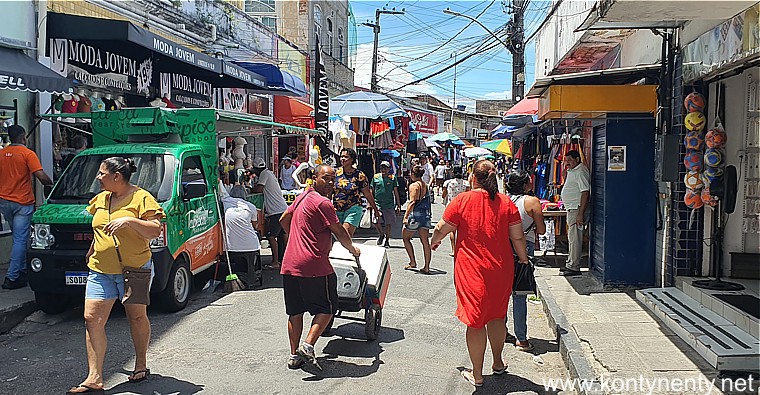 |
||
|
Hairy Neptune and Proserpina diplomatically poured ladles over the offenders. But Neptune's assistants poured a champagne bucket's full of water over the heads of the young officers, so that they would remember the event until the end of their service. A team of Brazilian entertainers sailed with us. Among them were beautiful dancers, with whom I danced on the dance floor in the evenings (picture on right column): |
Następnego dnia po wyjściu z Recife przekraczaliśmy równik i z tej okazji na pokładzie odbył się morski chrzest dla nowicjuszy. (Zdjęcie na lewej kolumnie)Kudłaty Neptun i Prozerpina dyplomatycznie polewali delikwentów chochlami. Ale młodym oficerom pomocnicy Neptuna wylewali na głowę po wiaderku od szampana, aby pamiętali wydarzenie do końca służby. Płynęła z nami ekipa brazylijskich animatorów. Wśród nich były piękne tancerki, z którymi tańczyłem wieczorami na parkiecie: |
|
|
Każdemu pasażerowi dostarczono do kabiny certyfikat przekroczenia równika podpisany przez kapitana Stefano. Tymczasem na pokładzie trwały tańce i wielkie żarcie... Each passenger was delivered to their cabin a certificate of crossing the equator signed by Captain Stefano. Meanwhile, on board, there was dancing and great food consumption... |
|
|
|
After four days of sailing across the Atlantic, we reached the Cape Verde Islands, or more precisely, the capital of this island nation, the port of Praia. It was a pleasant break in the long journey across the ocean. But the landscape of the windy and dry country was completely different: |
Po czterech dniach żeglugi przez Atlantyk zawinęliśmy na Wyspy Zielonego Przylądka, a dokładniej - do stolicy tego wyspiarskiego kraju - portu Praia. Był to miłe przerywnik w długiej podróży przez ocean. Ale krajobraz wietrznego i suchego kraju był zupełnie inny: |
|
|
|
||
|
Our ship docked at the commercial port, and I set off on foot into the city, ignoring the expensive excursions and shuttle buses. I was last there in 2002. The ship offers a shuttle bus to the city for 12 euros, but I will of course walk, looking at the improvised fish market just outside the port gate. The budget traveler should rely on his feet! |
Nasz statek zacumował w porcie handlowym, a ja nie oglądając się na drogie wycieczki i shuttle-busy wyruszyłem pieszo na miasto. Byłem w nim ostatnio w 2002 roku. Statek oferuje za 12 euro shuttle-bus do miasta, ale ja oczywiście poszedłem pieszo, oglądając tuż za portową bramą zaimprowizowany rybny targ. Budżetowy podróżnik powinien polegać na swoich nogach! |
|
|
|
||
|
The most interesting place in Praia seems to be the market hall or mercado. It was built in 1924 on the main street of the city - it is easy to find. How many exotic vegetables and fruits and how many interesting faces! You can take interesting photos from the first floor: |
Najciekawszym miejscem w Praia zdaje się być hala targowa czyli mercado. Zbudowano je w 1924 roku przy głównej ulicy miasta - łatwo to miejsce odnaleźć. Ile tu egzotycznych warzyw i owoców i ile ciekawych twarzy! Z piętra można robić nietuzinkowe zdjęcia: |
|
|
|
||
|
The most representative building in the city is the Presidential Palace surrounded by a well-kept garden. From the escarpment behind the palace, there is a beautiful view of the port and the bay. There is also a monument to Diogo Gomes - the Portuguese sailor who discovered this archipelago. |
Najbardziej reprezentacyjną budowlą miasta jest otoczony zadbanym ogrodem Pałac Prezydencki. Ze skarpy za pałacem otwiera się piękny widok na port i zatokę. Stoi tam także pomnik Diogo Gomesa - portugalskiego żeglarza, który odkrył ten archipelag. |
|
|
|
||
|
I went down from the palace to the beach. I passed a small palm house and started climbing wide stairs to the next densely built-up elevation. A few more streets and... I saw a monument of our pope, surrounded by palm trees. John Paul II - the pope-traveler was here in May 2007. In the place on the seaside escarpment where he celebrated mass, this monument was later erected. It is a very nice sight for every Pole: |
Zszedłem od pałacu w dół, do plaży. Przeszedłem obok niewielkiej palmiarni i zacząłem wspinać się szerokimi schodami na następne, gęsto zabudowane wzniesienie. Jeszcze kilka ulic i... zobaczyłem pomnik naszego papieża, otoczony palmami. Jan Paweł II - papież-podróżnik był tu w maju 2007 roku. W miejscu na nadmorskiej skarpie, gdzie odprawił mszę postawiono potem ten pomnik. To bardzo miły widok dla każdego Polaka: |
|
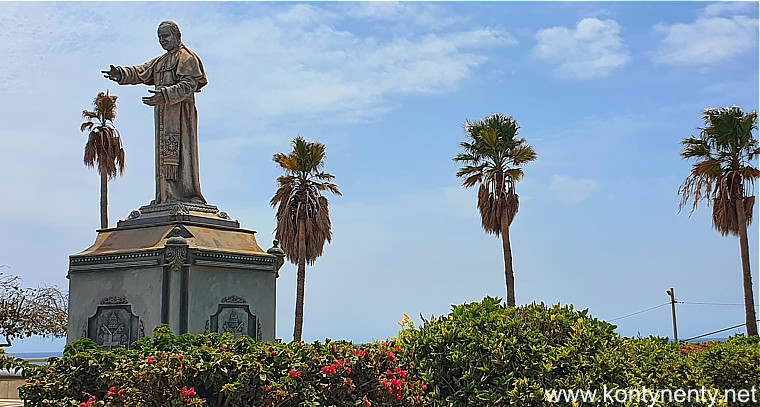 |
||
|
The following days at sea were filled with dance lessons, competitions, entertainment and performances. In the evening, gymnasts, dancers and singers showed off in the theater: |
Kolejne dni w morzu wypełnione były nauką tańców, konkursami, rozrywkami i przedstawieniami. Wieczorem w teatrze popisywali się gimnastycy, tancerze i piosenkarze: |
|
|
|
|
|
|
Finally, Tenerife appeared on the horizon before the bow. I call this island the lighthouse of Europe, because it signals its proximity. I spent a day there, walking around the city and using the free internet access in the public library, because after days at sea my mailbox was full :) This is the black building on the left side of the photo: |
W końcu na horyzoncie przed dziobem pojawiła się Teneryfa. Nazywam tę wyspę latarnią morską Europy, bo sygnalizuje jej bliskość. Spędziłem tam dzień spacerując po mieście i korzystając w publicznej bibliotece z bezpłatnego dostępu do internetu, bo po dniach w morzu moja skrzynka pocztowa była pełna :) To ten czarny budynek po lewej stronie zdjęcia: |
|
 |
||
|
From Tenerife we sailed Atlantic Ocean to Lisbon, where the cruise ship terminal is conveniently built on the Tagus River, at the foot of the old part of the city. Sailing along the river to the terminal, you can see from a new perspective the historic Belem Tower, built in the early 16th century to commemorate Portugal's great geographical discoveries. UNESCO has included the tower on its World Heritage list: |
Z Teneryfy popłynęliśmy do Lizbony, gdzie terminal dla statków pasażerskich zbudowany jest nad rzeką Tag, u stóp starej części miasta. Płynąc rzeką do terminalu z nowej perspektywy można spojrzeć na historyczną Wieżę Belem, zbudowaną na początku XVI wieku dla upamiętnienia wielkich odkryć geograficznych Portugalii. UNESCO umieściło wieżę na swojej liście World Heritage: |
|
|
|
||
|
Just behind the Belem Tower, every ship heading to the port of Lisbon passes under a high bridge connecting the banks of the Tagus, which is very wide at this point. It is a very spectacular sight. Unfortunately, the sun was covered by clouds in the morning when we got there: |
Zaraz za Wieżą Belem każdy statek zmierzający do portu w Lizbonie przepływa pod wysokim mostem łączącym brzegi bardzo szerokiego w tym miejscu Tagu. To bardzo spektakularny widok. Niestety rankiem, gdy się tam znaleźliśmy słońce zakrywały chmury: |
|
|
|
||
|
The pier and the terminal for passenger ships in Lisbon are located at the foot of Alfama - the old part of the city. You don't have to get off the ship to look from the height of the twelfth deck, or the twelfth floor, at the labyrinth of narrow streets covering the hillside, at the red roofs of old houses and the towers of churches: |
Nabrzeże i terminal dla statków pasażerskich w Lizbonie zlokalizowane są u stóp Alfamy - starej części miasta. Nie trzeba wcale schodzić ze statku, aby z wysokości dwunastego pokładu czyli dwunastego piętra popatrzeć na labirynt wąskich uliczek pokrywających zbocze wzgórza, na czerwone dachy starych domów i wieże kościołów: |
|
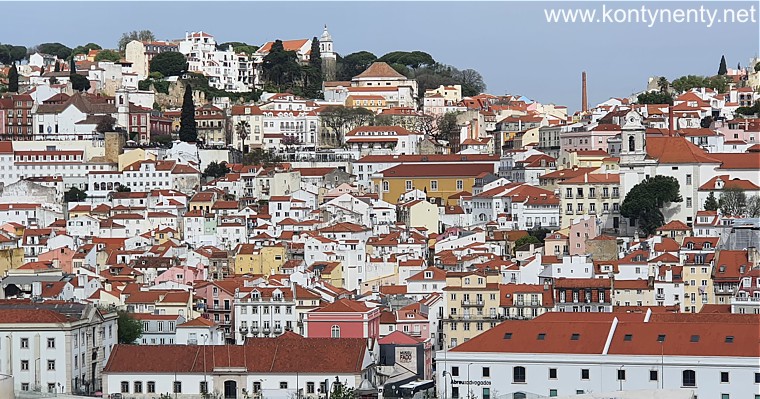 |
||
|
In front of the terminal, taxi and rickshaw owners are waiting for passengers, offering paid city tours, but in my opinion it is better to explore the city on foot, because the biggest attractions are not far at all. After 15 minutes of walking along the Tagus, I found myself in the central square of Lisbon - Praça do Comércio: |
Przed terminalem czekają na pasażerów właściciele taksówek i riksz, proponując odpłatne zwiedzanie miasta, ale moim zdaniem lepiej jest zwiedzać je pieszo, do największych atrakcji nie jest wcale daleko. Po 15 minutach marszu wzdłuż Tagu znalazłem się na centralnym placu Lizbony - Praça do Comércio: |
|
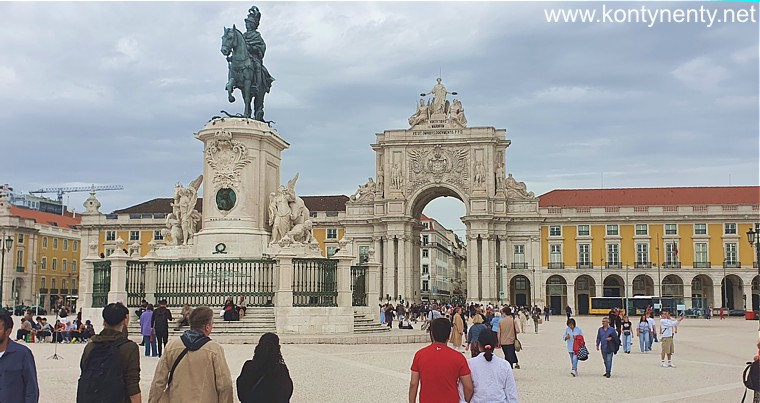 |
||
|
This vast square measures 175 by 175 meters. The streets, converted into pedestrian streets, lead from this square to other monuments. I headed from here to Alfama Hill - to the Castle of São Jorge. Castelo Do São Jorge was built in the 12th century: |
Ten rozległy plac ma rozmiary 175 na 175 metrów. Zamienione na deptaki ulice prowadzą z tego placu w kierunku innych zabytków. Ja skierowałem się stąd na wzgórze Alfamy - do Zamku Świętego Jerzego. Castelo Do São Jorge został wzniesiony w XII wieku: |
|
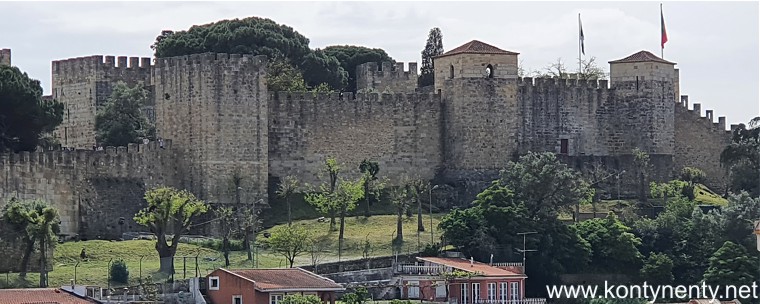 |
||
|
The mascot of Old Lisbon are the small, archaic trams that climb the narrow streets that dominate this part of the city. At the end stops of these trams, long lines of tourists form. Those who (like me) don't want to wait in lines have to climb steep stairs. But it has its charm: |
Maskotką Starej Lizbony są małe, archaiczne tramwaje wspinające się wąskimi uliczkami dominującymi w tej części miasta. Na końcowych przystankach tych tramwajów tworzą się długie kolejki turystów. Ci, którzy (jak ja) nie chcą czekać w kolejkach musza wspinać się stromymi schodkami. Ale ma to swój urok: |
|
|
|
|
|
|
From the Sao Vicente viewing terrace in the old town, the view opens up to the red-tiled roofs of Alfama and our ship moored at the modern terminal. Notice how wide the Tagus River is here: |
Z tarasu widokowego Sao Vincente na starym mieście otwiera się widok na kryte czerwoną dachówką dachy Alfamy i nasz statek zacumowany przy terminalu. Zwróćcie uwagę jak szeroko rozlana jest w tym miejscu jest rzeka Tag: |
|
|
|
||
|
After leaving Lisbon, our ship headed for the Strait of Gibraltar. We sailed past Gibraltar in darkness. Then we had a day at sea for fun and relaxation. At noon, we were invited to a buffet lunch where I met the masters of our cuisine. They cooked brilliantly! And especially for me, the kitchen prepared my favorite salad dressing "1000 Islands": |
Po wyjściu z Lizbony nasz statek skierował się do Cieśniny Gibraltarskiej. Koło Gibraltaru przepłynęliśmy w ciemnościach. A potem mieliśmy dzień w morzu na rozrywki i wypoczynek. W południe zaproszono na bufetowy lunch na którym poznałem mistrzów naszej kuchni. Gotowali znakomicie! A specjalnie dla mnie kuchnia przygotowywała mój ulubiony sos do sałaty "1000 wysp" : |
|
|
|
||
|
In the evening, gymnasts showed off at the theater. I admired their performances. Because what an extraordinary sense of balance one must have to perform something like this: |
Wieczorem w teatrze popisywali się gimnastycy. Podziwiałem ich popisy. Bo jakież niezwykłe poczucie równowagi trzeba mieć, aby zaprezentować coś takiego: |
|
|
|
||
|
The next port on our route was Alicante, Spain. It was my first visit to this city. Unfortunately, the day was foggy and it rained intermittently. Our ship was moored far away on a long and narrow quay (see the photo below). I was offered a ride on a toy train to the city for 5 euros. I went on foot under an umbrella because it was raining: |
Następnym portem na naszym szlaku było hiszpańskie Alicante. To była moja pierwsza wizyta w tym mieście. Niestety dzień był mglisty i co chwilę popadywał deszcz. Nasz statek zacumował daleko na długiej i wąskiej kei. Proponowano mi przejazd zabawkowym pociągiem do miasta za 5 euro. Poszedłem pieszo pod parasolem, bo padało: |
|
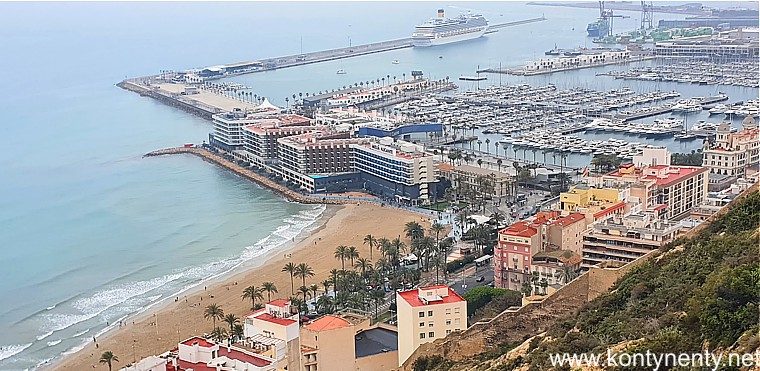 |
||
|
The biggest attraction in Alicante is the Castle of Santa Barbara, built in the 10th century on a lofty hill that is 166 meters high (photo below). There are two ways to get to the castle: by the street leading to the gate on the opposite side of the hill (it's about a 40-minute walk) or by a lift running in a vertical shaft cut into the rock. The entrance to the shaft is from the coastal street. The fee is 2.75 euros, but senior citizens from EU countries enter for free :) |
Największą atrakcją Alicante jest Zamek Św. Barbary, zbudowany w X wieku na wyniosłym wzgórzu, które ma 166 metrów (zdjęcie poniżej) Do zamku można się dostać na dwa sposoby: ulicą poprowadzoną do bramy z przeciwnej strony wzgórza (to jakieś 40 minut spaceru) lub windą kursującą w pionowym szybie wykutym w skale. Wejście do szybu jest z nadbrzeżnej ulicy. Opłata 2.75 euro, ale seniorzy z krajów UE wjeżdżają za darmo :) |
|
 |
||
|
The castle buildings are spread over several levels. Entry to the castle is free. In several places in the rooms there are small exhibitions. The place is interesting and frequently visited. The only thing I missed that day was the sun. Maybe next time... |
Zamkowe budowle rozłożone są na kilku poziomach. Wstęp do zamku jest bezpłatny. W kilku miejscach w pomieszczeniach są niewielkie wystawy. Miejsce jest ciekawe i licznie odwiedzane. Tylko słońca mi tego dnia brakowało. Może następnym razem... |
|
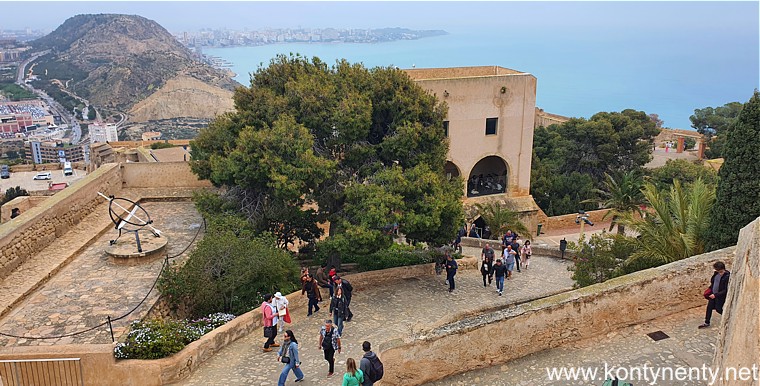 |
||
|
On the highest bastion, several old cannons are set up and a tattered flag flutters. The view is beautiful, but it is unfortunately spoiled by the installed mobile phone antenna masts. |
Na najwyższym bastionie ustawionych jest kilka starych armat i trzepocze postrzępiona flaga. Widok jest piękny, ale psują go niestety zainstalowane maszty antenowe telefonii komórkowej. |
|
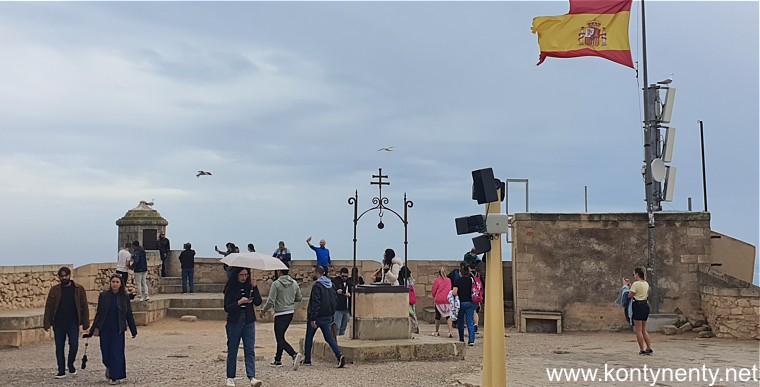 |
||
|
Then I went down to the old town, where hundreds of restaurant tables are spread out in the narrow streets. There is also a cathedral squeezed into the tight line of buildings and other churches (closed in the middle of the day!). I liked most the town hall and the beautiful palm-lined boulevard by the port the : |
Zszedłem potem na stare miasto, gdzie w wąskich uliczkach rozstawione są setki restauracyjnych stolików. Jest też wciśnięta w ciasną zabudowę katedra i inne kościoły (w środku dnia zamknięte!). Najbardziej podobał mi się ratusz i piękny przyportowy bulwar wysadzany palmami: |
|
 |
||
|
The very next day I said goodbye to my ship in Barcelona and marched all over the way from the port to Christopher Columbus’s column to joyfully welcome my son Adam and his two sons (my grandsons). We were to continue the rest of this journey together: |
Już następnego dnia pożegnałem mój statek w Barcelonie i pomaszerowałem pod kolumnę Krzysztofa Kolumba, by z radością powitać mojego syna Adama i jego dwóch synów (moich wnuków). Dalszą część tej podróży mieliśmy odbyć razem: |
|
|
|
||
|
For my family, this was their first encounter with Barcelona. I had been to the city many times, so I could act as a guide for my family. First, we took a ride on the old cable car (Telefèric), which soars above the port, ending at Montjuïc Mountain. We paid 12.50 euros each for a one-way ride. No discounts! This was the first time I had photographed the city and port of Barcelona from such a interesting perspective: |
Dla mojej rodziny było to pierwsze spotkanie z Barceloną. Ja byłem w tym mieście wielokrotnie, więc mogłem być dla moich bliskich przewodnikiem. Na początek wybraliśmy się na przejażdżkę starą kolejką linową (Telefèric), która szybuje ponad portem na wysokości 76 metrów, kończąc jazdę na górze Montjuïc. Zapłaciliśmy po 12,50 euro za przejazd w jedną stronę. Po raz pierwszy fotografowałem miasto z takiej perspektywy: |
|
|
|
||
| From the cable car, we could also see the passenger port with a row of cruise ships. We were supposed to board one of these ships after a three-day stay in Barcelona to sail to other Mediterranean ports: |
Z wagonika kolejki widać było także port pasażerski z rzędem statków wycieczkowych. Na jeden z takich statków mieliśmy wsiąść po trzech dniach pobytu w Barcelonie, aby popłynąć do innych portów Morza Śródziemnego: |
|
 |
||
|
In the meantime, however, we visited Barcelona's flagship monuments: Rambla, the Espanya and Catalunya squares, the Barrio Gotico, and of course the famous Sagrada Familia, under construction since 1882. The work is expected to be completed in 2026. Even before the construction was completed, UNESCO placed the basilica on the World Heritage List. Thousands of tourists take souvenir photos here every day. We also: |
Tymczasem jednak zwiedzaliśmy flagowe zabytki Barcelony: Ramblę, place Espanya i Catalunya, Barrio Gotico no i oczywiście słynną bazylikę Sagrada Familia, budowaną od 1882 roku. Ukończenie prac przewiduje się w 2026 roku. Jeszcze przed ukończeniem budowy UNESCO umieściło bazylikę na liście Światowego Dziedzictwa. Tysiące turystów każdego dnia robią tu pamiątkowe zdjęcia. My też: |
|
|
|
||
|
We took the metro to the famous Guell Park. I didn't expect that the park, which contains many works by Gaudi, is so popular that tickets have to be bought well in advance on the internet. We could only see the main entrance, built, in Gaudi's style, of course: |
Metrem dojechaliśmy do słynnego Parku Guell. Nie przewidziałem jednak, że park, zawierający wiele dzieł Gaudiego cieszy się takim powodzeniem, że bilety trzeba kupować z dużym wyprzedzeniem w internecie. Mogliśmy obejrzeć jedynie główne wejście, zbudowane oczywiście w stylu Gaudiego: |
|
|
|
||
|
When the time came, we walked to the port. Our big ship was already waiting (photo below). Unfortunately, we couldn't guess which of those hundreds of windows would be ours. Because our cheapest cabin was an inside cabin - it had no window at all... Thanks to my frequent passenger status, we didn't have to wait in line to check in at all. |
Gdy przyszedł czas pomaszerowaliśmy do portu pieszo. Nasz wielki statek już czekał (zdjęcie poniżej). Niestety nie mogliśmy zgadywać, które z tych setek okien będzie nasze. Bo nasza najtańsza kabina była to kabina wewnętrzna - nie miała wcale okna... Dzięki mojemu statusowi częstego pasażera nie musieliśmy wcale czekać w kolejce do odprawy. |
|
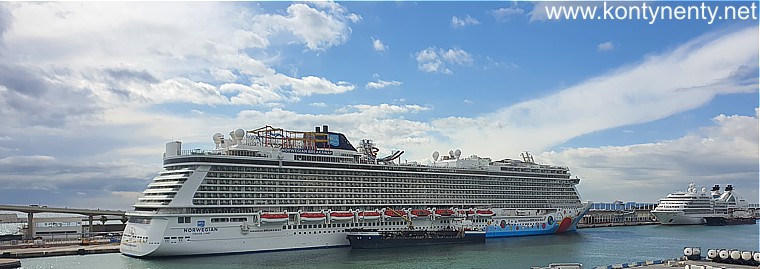 |
||
|
The ship sailed all night. The next morning I saw Ibiza for the first time in my life. It had so happened that my travels had avoided that island. It was a beautiful, sunny day, but a strong wind was blowing: |
Statek płynął całą noc. Następnego poranka po raz pierwszy w życiu zobaczyłem Ibizę. Tak się dotąd układało, że szlaki moich podróży omijały tę wyspę. Był piękny, słoneczny dzień, ale wiał silny wiatr: |
|
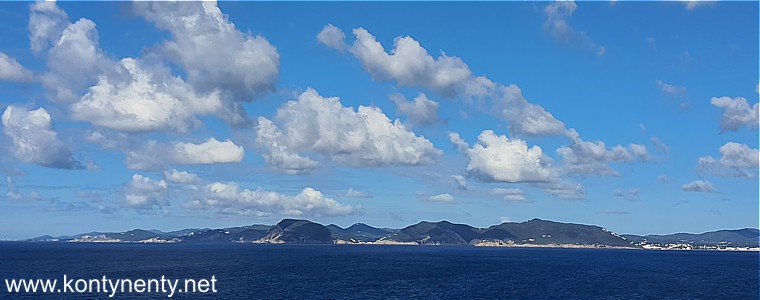 |
||
|
On the rock at the entrance to the port I saw the picturesque castle of Eivissa, the construction of which began in the 12th century, at a time when Islam ruled here. In the following years the castle was rebuilt several times. Today it is open to visitors: |
Na skale u wejścia do portu stoi malowniczy zamek Eivissa, którego budowę rozpoczęto w XII wieku, jeszczew czasach, gdy panował tu islam. W następnych latach zamek kilkakrotnie przebudowywano. Dziś udostępniony jest do zwiedzania: |
|
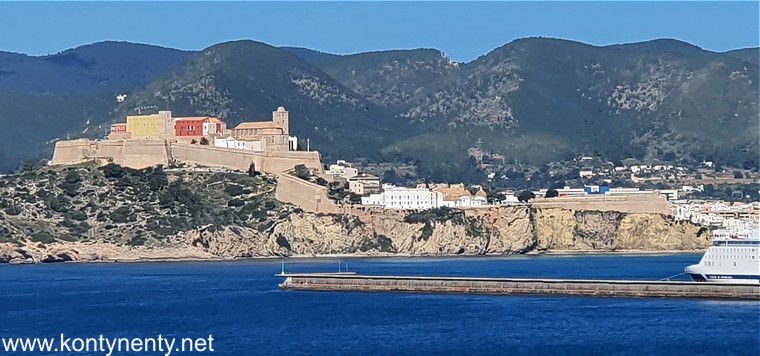 |
||
|
Right next to the passenger pier I saw a passenger ferry port, which regularly runs to Spain. To get to the city you have to walk past these ports. Right behind them is a small pier from which a small city-boat (water tram) runs to the old town, which is spread out on the other side of the bay - at the foot of the castle: |
Tuż obok mola pasażerskiego zobaczyłem przystań pasażerskich promów, kursujących regularnie do Hiszpanii. Aby dojść do miasta trzeba przejść obok tych przystani. Zaraz za nimi jest niewielkie molo z którego kursuje niewielki city-boat (tramwaj wodny) do starego miasta, które rozłożyło się po drugiej stronie zatoki - u stóp zamku: |
|
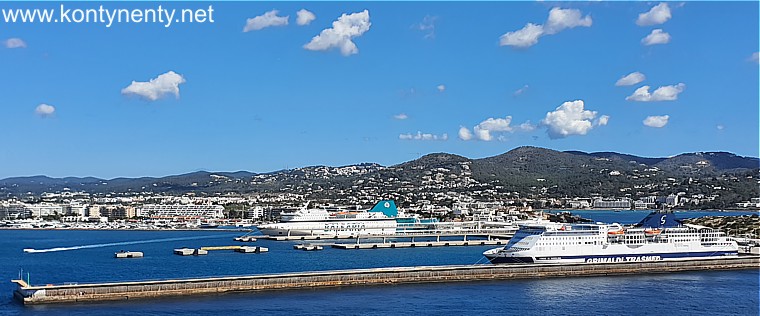 |
||
|
Not knowing the island and having little time, I signed up for a cheap tour. It was advertised that the route would take us to the most picturesque corners of the island. First, we were shown salt pans - pools where salt has been extracted from seawater for hundreds of years: |
Nie znając wyspy i mając niewiele czasu zapisałem się na tanią wycieczkę. Reklamowano, że jej trasa prowadzi do najbardziej malowniczych zakątków wyspy. Na początek pokazano nam saliny - baseny w których od setek lat pozyskuje się sól przez odparowywanie wody morskiej: |
|
|
|
||
|
Near the salt pans we stopped for a short while at the "wild" beach of Las Salinas. The beach is clean, narrow, but very long. Tourists bring blankets and supplies - just like here, in Gdansk. Only the color of the water in the sea is more varied here: |
W pobliżu salin zatrzymaliśmy się na krótko na "dzikiej" plaży Las Salinas. Plaża jest czysta, wąska, ale za to bardzo długa. Turyści przynoszą ze sobą kocyki i zaopatrzenie - zupełnie jak u nas w Gdańsku. Tylko kolor wody w morzu jest tu bardziej urozmaicony: |
|
|
|
||
|
From the salt flats we went to the parish of St Josef (Ibiza is divided into parishes) where on the colorful cliff shore there are excavations to see (Phoenicians once founded the first settlement on the island here). The excavations are not very interesting, but the cliff is very picturesque. At its foot there is a small beach: |
Z rejonu salin pojechaliśmy do parafii St Josef (Ibiza podzielona jest na parafie) gdzie na kolorowym klifowym brzegu są do zobaczenia wykopaliska (Fenicjanie założyli tu kiedyś pierwszą osadę na wyspie). Wykopaliska są niezbyt ciekawe, ale klif jest bardzo malowniczy. U jego stóp jest niewielka plaża: |
|
|
|
||
|
The coast of Ibiza is dotted with numerous coves, in the local language they are called "Cala" (the equivalent of the English word "cove"). On the western side of the island we visited Cala Comte with two beaches and a noisy restaurant. Opposite the beach lies a picturesque, flat islet. Unfortunately, it is protected and swimming is not allowed there: |
Wybrzeże Ibizy usiane jest licznymi zatoczkami, w miejscowym języku określa się je jako "Cala" (to odpowiednik angielskiego słowa "cove". Po zachodniej stronie wyspy odwiedziliśmy Cala Comte z dwiema plażami i hałaśliwą restauracją. Naprzeciwko plaży leży malownicza, płaska wysepka. Niestety pozostaje ona pod ochroną i nie można tam pływać: |
|
 |
||
|
A short stopover in Ibiza allowed me to see the most characteristic landscapes of this island. I didn't care about seeing the discos and hotels in the noisy resorts of Ibiza. We sailed at night. The next morning we were already in Palma, Majorca. I had been to this port before, but it was a long time ago and it was nice to look once again at the monuments of this city with an interesting history. Crowds of tourists fill the city's promenades: |
Krótki postój na Ibizie pozwolił mi zobaczyć najbardziej charakterystyczne krajobrazy tej wyspy. Nie zależało mi na oglądaniu dyskotek i hoteli w gwarnych kurortach Ibizy. Płynęliśmy nocą. Następnego poranka byliśmy już w Palmie na Majorce. Byłem już kiedyś w tym porcie, było to jednak dawno i miło było raz jeszcze popatrzeć na zabytki tego mającego ciekawą historię miasta. Tłum turystów wypełnia tu miejskie deptaki: |
|
 |
||
|
The most important monument and icon of Palma is the Catholic cathedral of La Seu, which was built on the site of a mosque in the 13th century. A visit to the interior (the main nave is an impressive 44 meters high) of the church is subject to a fee - a ticket for 10 euros can be purchased online. Of course, you have to take a photo in front of the cathedral :) |
Najważniejszym zabytkiem i ikoną Palmy jest katolicka katedra La Seu, którą zbudowano na miejscu meczetu w XIII wieku. Zwiedzanie wnętrza kościoła (główna jego nawa ma imponującą wysokość 44 metrów) jest płatne - bilet za 10 euro można kupić w internecie. No i trzeba oczywiście sfotografować się przed katedrą :) |
|
|
|
||
|
Poles know Majorca primarily thanks to the stay of our greatest composer - Fryderyk Chopin. Chopin lived and composed in an old monastery in Valdemossa, 17 kilometers from the capital of the island. How could I - a lover of Chopin's music - miss the opportunity to see this place? I determined that you can get to Valdemossa by bus 203, paying 4.50 euros for a ticket. But first you have to get to the underground bus station at Plaza Espanya - it's a 5-kilometer walk from the ship. |
Polakom Majorka znana jest przede wszystkim dzięki pobytowi naszego największego kompozytora - Fryderyka Chopina. Chopin mieszkał i tworzył w starym klasztorze w Valdemossa, 17 kilometrów od stolicy wyspy. Jakże ja - miłośnik muzyki Chopina mógłbym pominąć okazję zobaczenia tego miejsca? Ustaliłem, że do Valdemossa można dojechać autobusem 203, płacąc za bilet 4,50 euro. Ale najpierw trzeba dotrzeć do podziemnego dworca autobusowego przy Plaza Espanya - to ze statku aż 5 kilometrów marszu! |
|
|
|
||
|
After about 50 minutes of driving, I saw Valdemossa through the tinted window of the bus (photo above). It is a small but picturesque town in the Serra de Tramuntana mountains. The Carthusian monastery visible on the left side of the photo currently serves exclusively as a museum. An entrance ticket to this museum, which also includes a short concert of Chopin's music, costs 12.50 euros. Those entering the former monastery are greeted by a bust of Chopin - the one who unwittingly made Valdemossa famous: |
Po około 50 minutach jazdy zobaczyłem Valdemossę przez przyciemnioną szybę autobusu (zdjęcie powyżej). To niewielkie, ale malownicze miasteczko w górach Serra de Tramuntana. Klasztor kartuzów widoczny po lewej stronie zdjęcia pełni w tej chwili wyłącznie funkcje muzealne. Bilet wstępu do tego muzeum, obejmujący także krótki koncert muzyki Chopina kosztuje 12,50 euro. Wchodzących na teren dawnego klasztoru wita popiersie Chopina - tego, który zupełnie nieświadomie rozsławił Valdemossę: |
|
|
|
||
|
The small monastery courtyard, enclosed by a quadrangle of cloisters, is rather neglected. The historical pharmacy and rooms filled with furniture, paintings and 19th-century trinkets are interesting. The large interior of the church is impressive. At the entrance to the church, two not very successful effigies of Chopin and George Sand were placed. |
Niewielki klasztorny dziedziniec, zamknięty czworobokiem krużganków jest raczej zaniedbany. Ciekawa jest historyczna apteka i pomieszczenia wypełnione meblami, obrazami i XIX-wiecznymi bibelotami. Robi wrażenie wielkie wnętrze kościoła. Przy wejściu do kościoła ustawiono dwie niezbyt udane kukły przedstawiające Chopina i George Sand. |
|
|
|
||
|
Quite unexpectedly, it turned out that there is a museum in the monastery. From the monastery corridors, you enter the rooms where the composer lived at the turn of 1838 and 1839. To see "Cell No. 4" where Chopin lived (there are 3 rooms and a small terrace with a garden) you have to pay an additional 6 euros. Judge for yourself if it is worth it: |
Zupełnie niespodziewanie okazało się, że w klasztorze jest muzeum w muzeum. Z klasztornych korytarzy wchodzi się do pomieszczeń w których na przełomie roku 1838 i 1839 mieszkał kompozytor. Za obejrzenie "Celi nr 4" w której mieszkał Chopin (to 3 pomieszczenia i niewielki taras z ogródkiem) trzeba dodatkowo zapłacić 6 euro. Sami oceńcie czy warto: |
|
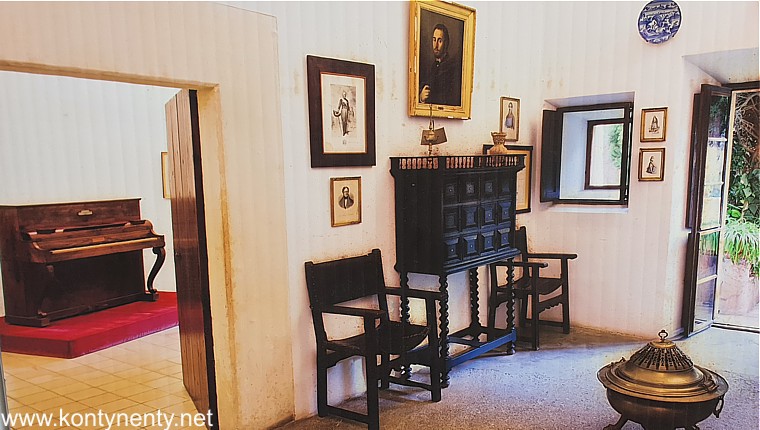 |
||
|
Several of the museum halls open onto small terraces. They offer views of the surrounding mountains. The monks had ideal conditions for contemplation and prayer here: |
Z kilku muzealnych sal wychodzi się na niewielkie tarasy. Otwierają się z nich widoki na okoliczne góry. Zakonnicy mieli tu idealne warunki do kontemplacji i modlitwy: |
|
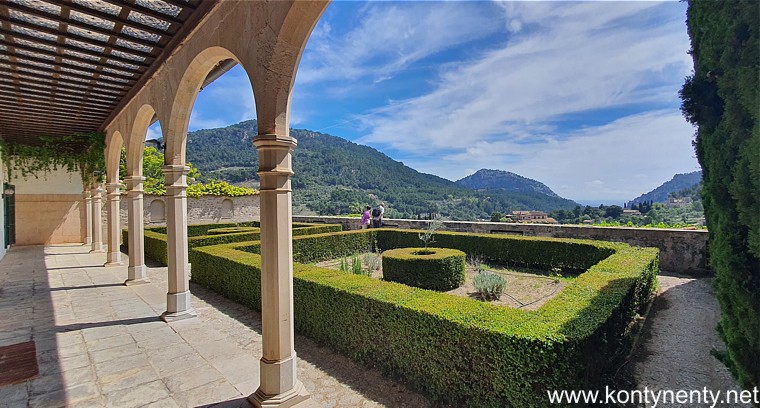 |
||
|
In a small room, which can hold perhaps 120 people, several times a day an old man plays 2 nocturnes and two lesser-known waltzes by Chopin. The whole thing lasts only 15 minutes and it is hard to call it a concert. But for tourists in shorts it gives some idea of the music of the Polish composer: |
W niewielkiej salce, mieszczącej może ze 120 osób kilka razy w ciągu dnia starszy pan gra 2 nokturny i dwa mniej znane walce Chopina. Wszystko trwa zaledwie 15 minut i trudno to nazwać koncertem. Ale turystom w szortach daje to jakieś wyobrażenie o muzyce polskiego kompozytora: |
|
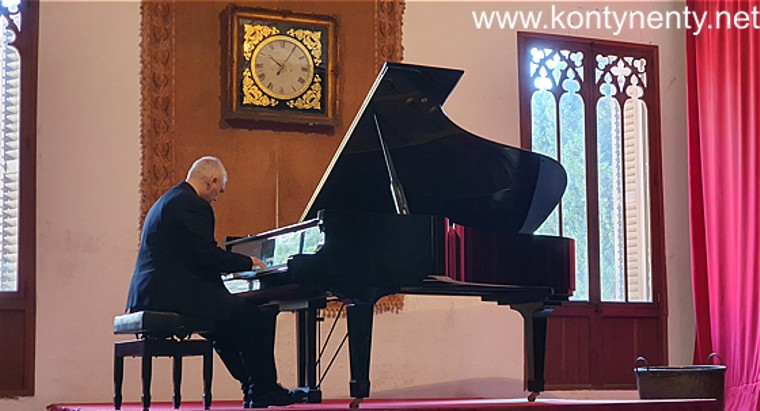 |
||
|
The return journey from Valdemossa to Palma took a little less time - perhaps because there were fewer cyclists on the winding mountain road. In the evening we sailed away from Palma to spend the whole next day at sea. We watched revue performances in the theatre. I also had the opportunity to meet my 46th captain - he was the nice captain Asen from Bulgaria. By chance, I had sailed with him a few years earlier, but on a different ship. He remembered my face and my travel achievements. It was a nice meeting: |
Powrotna podróż z Valdemossy do Palmy trwała nieco krócej - być może dlatego, że na krętej górskiej drodze mniej było rowerzystów. Wieczorem odpłynęliśmy z Palmy, by cały następny dzień spędzić w morzu. Oglądaliśmy rewiowe przedstawienia w teatrze. Miałem też okazję poznać mojego 46-go kapitana - To sympatyczny kapitan Asen z Bułgarii. Przypadek sprawił, że kilka lat wcześniej płynąłem już z nim, ale na innym statku. Pamiętał moją twarz i mój podróżniczy dorobek. To było miłe spotkanie: |
|
|
|
|
|
|
On Easter Day I woke up under Vesuvius! We had been moored in Naples since morning. After substantial breakfast with a view of the volcano my family went to visit Pompeii, and I set off alone to remember Naples, where (I remember it to this day!) in 1974 I ate my first Italian pizza. |
W dzień Wielkanocy obudziłem się pod Wezuwiuszem! Od rana cumowaliśmy w Neapolu. Moja rodzinka pojechała zwiedzać Pompeje, a ja ruszyłem samotnie przypomnieć sobie Neapol, w którym (pamiętam to do dziś!) w 1974 roku jadłem po raz pierwszy w życiu włoską pizzę. |
|
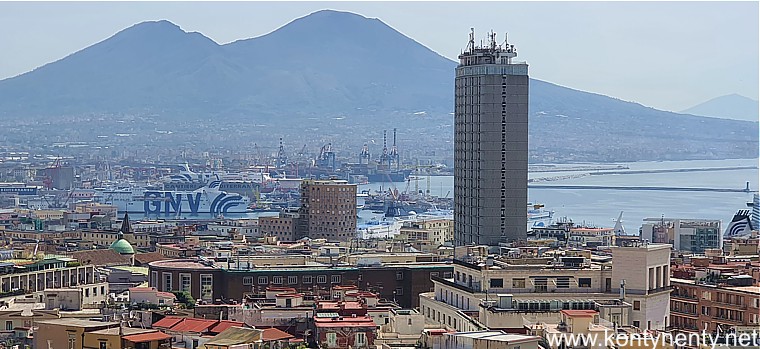 |
||
|
The passenger terminal in Naples is conveniently located in the city center - next to the Castel Nuovo. Straight from the terminal, after crossing the street, you enter the large Piazza Municipio, where you can recently take a photo next to the large "Napoli" sign: |
Przystań pasażerska w Neapolu jest dogodnie zlokalizowana w centrum miasta - obok zamku Castel Nuovo. Prosto z terminalu, po przejściu ulicy wchodzi się na duży plac Piazza Municipio, gdzie od niedawna można się sfotografować przy dużym napisie "Napoli": |
|
|
|
||
|
From this square I was hiking up, through narrow and atmospheric streets, which have their own specific atmosphere. Look at the photos below - despite the ongoing Easter Sunday, normal life was going on there. I climbed higher and higher in such a landscape, looking for a place from which the view of the city opens: |
Z tego placu pomaszerowałem w górę, wąskimi i nastrojowymi uliczkami, które mają swój specyficzny nastrój. Popatrzcie na zdjęcia poniżej - mimo trwającej wielkanocnej niedzieli toczyło się w nich normalne życie. Wspinałem się w takim krajobrazie wyżej i wyżej, szukając miejsca z którego otwiera się widok na miasto: |
|
|
|
|
|
|
I found a viewpoint only on the Vittorio Emanuele II street, which runs horizontally along the slope. From here I could photograph the roofs and domes of the countless churches of Old Naples. Many of these churches are now neglected and closed: |
Punkt widokowy znalazłem dopiero na przebiegającej po stoku horyzontalnie ulicy Vittorio Emanuele II. Mogłem stąd sfotografować dachy i kopuły niezliczonych kościołów Starego Neapolu. Wiele tych kościołów jest dziś zaniedbanych i zamkniętych: |
|
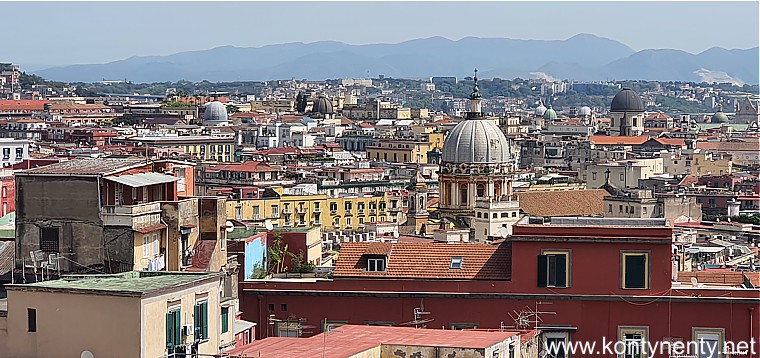 |
||
|
After descending the hill, I headed for the cathedral, hidden among the dense buildings of the old part of the city. The cathedral in Naples is definitely worth a visit. Inside, attention is drawn to the richly decorated vault and the interesting main altar: |
Po zejściu ze wzgórza skierowałem się do katedry, schowanej wśród gęstej zabudowy starej części miasta . Katedrę w Neapolu na pewno warto odwiedzić. We wnętrzu zwraca uwagę bogato dekorowane sklepienie i ciekawy główny ołtarz: |
|
|
|
||
|
It's not far from Naples to Rome. We departed on sunset. On Easter Monday, we docked in Civitavecchia, the port of Rome, early in the morning. I knew very well that the easiest and cheapest (9 euros both ways) way to get to the capital of Italy is by train. It's worth getting off at the Roma San Pietro station when you get to Rome. From this station, it's only a 10-minute walk to St. Peter's Square: |
Z Neapolu do Rzymu nie jest daleko. Odpłynęliśmy z Neapolu o zachodzie słońca. W Poniedziałek Wielkanocny już wczesnym rankiem zacumowaliśmy w Civitavecchia, w porcie Rzymu. Dobrze wiedziałem, że najprościej i najtaniej (9 euro w obie strony) jest dojechać do stolicy Włoch pociągiem. Warto przy tym dojeżdżając do Rzymu wysiąść na stacji Roma San Pietro. Z tej stacji tylko 10 minut idzie się na Plac Świętego Piotra: |
|
|
|
||
|
I have been to this square many times - the first time was under Pope Paul VI. But for my son and grandchildren it was an experience! The queue at an early hour was not long. We quickly managed to get through the security check and head for the entrance. On the occasion of Easter, the steps leading to the basilica were decorated with a carpet of spring flowers: |
Byłem na tym placu wielokrotnie - pierwszy raz za papieża Pawła VI. Ale dla syna i wnuków było to przeżycie! Kolejka o wczesnej porze nie była długa. Szybko udało się nam przejść przez kontrolę bezpieczeństwa i skierować się do wejścia. Z okazji Wielkanocy schody prowadzące do bazyliki udekorowane były dywanem z wiosennych kwiatów: |
|
|
|
||
|
Despite the early hour, the great interior of the basilica was full of visitors. I showed my son and grandchildren the tomb of John Paul II, Michelangelo's Pieta. And then the news came that Pope Francis had died in the morning. I was saddened and surprised that there were no signs of mourning in the basilica, that many tourists had no idea what had happened: |
Mimo wczesnej pory wielkie wnętrze bazyliki pełne było zwiedzających. Pokazałem synowi i wnukom grób Jana Pawła II, pietę Michała Anioła. I wtedy przyszła wiadomość, że rano zmarł papież Franciszek. Zasmuciłem się i zdziwiłem, że w bazylice nie ma żadnych oznak żałoby, że wielu turystów nie ma pojęcia o tym, co się wydarzyło: |
|
|
|
||
|
We took a souvenir photo with the basilica in the background. You can see that the entire center of the square was filled with chairs, prepared for pilgrims who came for Easter hoping to see the Pope during the special Easter service. They had to be satisfied with the sight of the papal Swiss guards (photo on the left column) |
Zrobiliśmy sobie pamiątkowe zdjęcie na tle bazyliki. Widać na nim, że cały środek placu zastawiony był krzesełkami, przygotowanych dla pielgrzymów, którzy przybyli na Wielkanoc mając nadzieję, że podczas odprawianego nabożeństwa zobaczą papieża. Musiał im niestety wystarczyć widok papieskich gwardzistów (zdjęcie na lewej kolumnie) |
|
|
|
|
|
|
From St. Peter's Square I then led my family along the trail of the most important monuments in Rome. Past Castel Sant'Angelo, across the bridge over the Tiber, we walked through narrow streets to the famous Trevi Fountain. There were so many tourists on the small square that it was hard to squeeze into the fountain. The city guards did not let visitors from all over the world onto the lower terrace, over the water. The fountain jets were not working anyway: |
Z Placu Świętego Piotra poprowadziłem potem moją rodzinkę szlakiem najważniejszych zabytków Rzymu. Obok Zamku Św. Anioła, przez most na Tybrze doszliśmy wąskimi uliczkami do słynnej Fontanny di Trevi. Turystów na niewielkim placyku było tyle, że do fontanny trudno się było docisnąć. Strażnicy miejscy nie wpuszczali przybyłych tu gości z całego świata na dolny taras, nad wodę. Być może ze względów bezpieczeństwa. Strugi fontanny zresztą nie działały: |
|
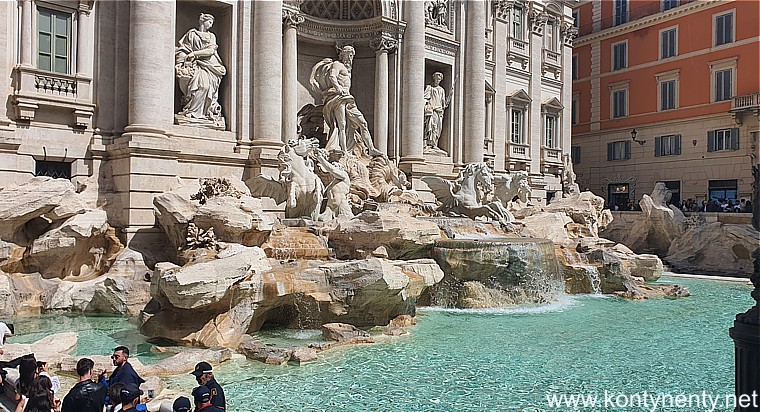 |
||
|
From the fountain that has appeared in many films, it is not far to the famous Spanish Steps. They lead from another, smaller fountain to the church of Trinita del Monti (Holy Trinity on the Hill), located on a hill. The artistic bohemians of Rome used to sit on the steps. The middle part of the steps is beautifully decorated with flowers - it is a picturesque corner! |
Od fontanny, która wystąpiła w wielu filmach jest już niedaleko do słynnych Hiszpańskich Schodów. Prowadzą one od innej, mniejszej fontanny do położonego na wzgórzu kościoła Trinita del Monti (Św. Trójcy na Wzgórzu). Na schodach przesiadywała kiedyś artystyczna cyganeria Rzymu. Środkowa część schodów jest pięknie ukwiecona - to bardzo malowniczy zakątek! |
|
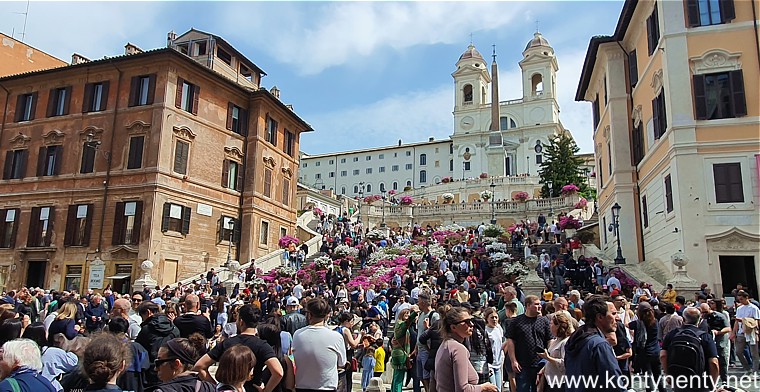 |
||
|
Then we had to walk more than a kilometer to get to the square in front of the Colosseum. I was pleased to note that after several years, the work on the square in front of the building had finally been completed. The Arch of Constantine, built in the 4th century, is particularly impressive: |
Potem musieliśmy przejść ponad kilometr, aby znaleźć się na placu przed Koloseum. Z przyjemnością odnotowałem, że po kilku latach zakończono nareszcie prace wykonywane na placu przed budowlą. Szczególnie okazale prezentuje się Łuk Konstantyna, wzniesiony w IV wieku: |
|
|
|
||
|
There is always a large group of Africans hanging around the Coliseum, trying to force primitive leather bracelets on tourists in every possible way, expecting money, of course. They are pushy. One such Kenyan set our group as a target, handed out bracelets and waited for money. When I introduced myself and started telling about my impressions of various regions of his country (including the hard-to-reach Lamu), he forgot about his goal - the bracelets stayed with us, and he waved goodbye for a long time :) |
Przy Koloseum kręci się zawsze spora grupa Afrykanów, próbujących na wszelkie sposoby wcisnąć turystom prymitywne bransoletki ze skóry, oczekując oczywiście pieniędzy. Są natarczywi. Jeden taki Kenijczyk wyznaczył sobie naszą grupkę jako cel, rozdał bransoletki i czekał na pieniądze. Gdy przedstawiłem się i zacząłem opowiadać o moich wrażeniach z różnych regionów jego kraju (włącznie z trudno dostępnym Lamu) zapomniał o swoim celu - bransoletki zostały u nas, a on długo machał na pożegnanie :) |
|
|
|
||
|
Tired from the walk, but happy because the weather was good, we returned by train from Termini station to the port. And the next morning we were already in the port of Livorno. I don't like this port. The port gate is far from the passenger pier, you can't walk to the gate. The port provides shuttle buses from the ship to the city (in other ports in such a situation they are free). And in Livorno they charge 7 euros for a return ticket! |
Zmęczeni pieszą wędrówką, ale szczęśliwi, bo dopisała nam pogoda wróciliśmy pociągiem ze stacji Roma Termini do portu. A następnego dnia rano byliśmy już w porcie Livorno. Nie lubię tego portu. Brama portu jest daleko od pasażerskiego molo, nie wolno do bramy iść pieszo. Port podstawia shuttle busy od statku do miasta (w innych portach w takiej sytuacji są one bezpłatne). A w Livorno każą sobie płacić 7 euro za powrotny bilet! |
|
|
|
||
|
From the town hall square, where we were dropped off, we had to walk another 2 kilometres to the station (there are city buses there, but we preferred walking through an unknown Italian city). Our destination was nearby Pisa, famous for its Leaning Tower. A 20-minute train ride from Livorno to Pisa costs €2.80 each way. In Pisa, you walk from the station to the tower, crossing a bridge over the Arno River on the way: |
Z ratuszowego placu, gdzie nas wysadzili trzeba do stacji iść jeszcze jakieś 2 kilometry (jeżdżą tam miejskie autobusy, ale woleliśmy spacer przez nieznane włoskie miasto). Naszym celem była pobliska Piza, słynna ze swojej Krzywej Wieży. 20-minutowy przejazd pociągiem z Livorno do Pizy kosztuje 2,80 euro w każdą stronę. W Pizie ze stacji do wieży idzie się pieszo, przekraczając po drodze most na rzece Arno: |
|
|
|
||
|
The Leaning Tower (it's not really crooked, as Poles call it, just leaning) is part of a larger complex of monuments called Campo dei Miracoli (Field of Miracles), which also includes a cathedral and a magnificent baptistery. It was built in the 12th century. In 1987, the entire complex was added to the UNESCO World Heritage List: |
Krzywa Wieża (tak naprawdę to nie jest ona krzywa, tylko pochylona) jest częścią większego zespołu zabytków nazywanego Campo dei Miracoli (Pole Cudów) w skład którego wchodzą także katedra i okazałe baptysterium. Budowano ją w XII wieku. W 1987 roku cały zespół wpisano na listę World Heritage UNESCO: |
|
|
|
||
|
Supposedly, more than 10 million tourists visit Pisa every year. You can see this in the area around the tower. Entry to the square is free, but you have to pay to enter the tower, the cathedral and the baptistery (pictured below). Tickets are sold in advance online: |
Podobno rocznie odwiedza Pizę ponad 10 milionów turystów. To widać w okolicach wieży. Wstęp na plac jest bezpłatny, ale za wstęp na wieżę, do katedry i baptysterium (na zdjęciu poniżej) trzeba płacić. Bilety sprzedają z wyprzedzeniem w internecie: |
|
|
|
||
|
From Pisa we returned to Livorno to sail to the next port - it was the French port on the Cote d'Azur - Cannes. I had never been to Cannes, which is well known for its film festival. The port does not have a long enough pier to accept our ship - they took us to land in large motorboats - tenders. To awoid waiting in the long queue to the tender they distributed free tender tickets. |
Z Pizy wróciliśmy do Livorno, by popłynąć do kolejnego portu - był nim francuski port na Lazurowym Wybrzeżu - Cannes. Nigdy nie byłem w Cannes, które znane jest z festiwalu filmowego. W porcie nie ma tu dostatecznie długiego nabrzeża, by przyjąć nasz statek - na ląd wozili nas dużymi motorówkami - tenderami, wysadzając koło mariny: |
|
|
|
||
|
There are no skyscrapers in the old centre of Cannes. The city has the feel of an elegant resort. Palm trees have been planted along many streets. There are public beaches. and a nice promenade runs along the coast: |
W starym centrum Cannes nie ma wieżowców. Miasto ma klimat eleganckiego kurortu. Wzdłuż wielu ulic posadzono palmy. Są tu ogólnodostępne plaże. a wzdłuż wybrzeża przebiega ładna promenada: |
|
|
|
||
|
At the end of this promenade you can see "a palace" where film festivals and conventions are held. It turned out to be a completely modern building, around which on the sidewalks there is a promenade of fame made in the style of Hollywood - with prints of hands and feet of film actresses and actors: |
Na krańcu tej promenady można zobaczyć "pałac", w którym odbywają się festiwale filmowe i kongresy. Okazało się, że to zupełnie współczesny budynek, wokół którego na chodnikach jest zrobiona na wzór Hollywood promenada sławy - z odciskami rąk i stóp aktorek i aktorów filmowych: |
|
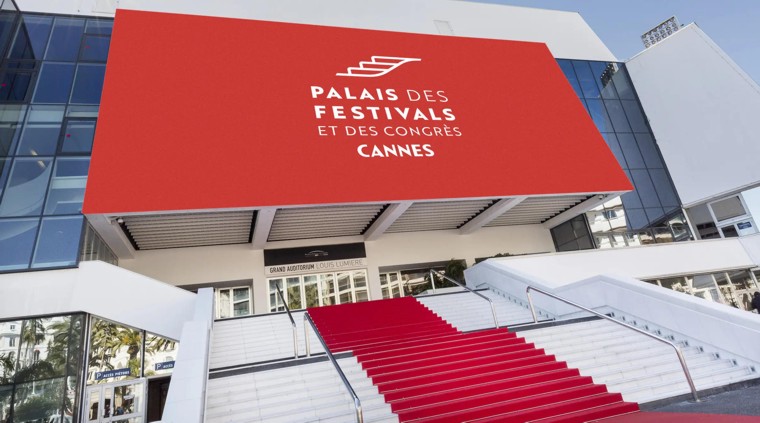 |
||
|
We walked past the Cannes town hall, heading for the train station. I suggested to my family that we use the rest of the day to go to the capital of the Principality of Monaco - Monte Carlo. The lady selling tickets advised us to buy the most affordable all-day "regional" ticket for just 9 euros. Trains run every half hour! |
Przeszliśmy obok ratusza w Cannes, kierując się do stacji kolejowej. Zaproponowałem mojej rodzince, aby wykorzystać resztę dnia na wycieczkę do stolicy Księstwa Monaco - Monte Carlo. Pani sprzedająca bilety doradziła, aby kupić najkorzystniejszy cenowo całodzienny bilet "regionalny" za zaledwie 9 euro. Pociągi jeżdżą co pół godziny! |
|
|
|
||
|
The train from Cannes to Monte Carlo takes just over an hour (with a ticket like ours you can stopover in Nice). There are many tunnels along the way, but also the landscapes of the Alpes-Maritimes open up (as in the photo above). Finally, we got off at the underground station in Monte Carlo, took the lift up to the street level and saw the principality's red and white flags hanging out: |
Pociąg z Cannes do Monte Carlo jedzie nieco ponad godzinę (z takim biletem jak nasz można zrobić sobie stopover w Nicei). Po drodze jest wiele tuneli, ale otwierają się także krajobrazy Alp Nadmorskich (jak na zdjęciu powyżej). W końcu wysiedliśmy na podziemnej stacji w Monte Carlo, wyjechaliśmy windą na poziom ulicy i zobaczyliśmy wywieszone czerwono-białe flagi księstwa: |
|
|
|
|
|
|
In the clean, not too wide streets of the capital, signposts with the word "palais" point the way to Monte Carlo's most important monument: the princely palace. After a few hundred meters, the walkers say goodbye to the street, entering a comfortable, concrete path climbing the hillside. On the way, we are greeted by a statue of Prince Rainier III - the father of the current reigning prince Albert II: |
W czystych, niezbyt szerokich ulicach stolicy drogowskazy z napisem "palais" pokazują drogę do najważniejszego zabytku Monte Carlo: książęcego pałacu. Po kilkuset metrach wędrówki piechurzy żegnają ulicę, wchodząc na wygodną, betonowaną ścieżkę wspinającą się po zboczu wzgórza. Po drodze wita nas posąg księcia Rainiera III (panował tu 56 lat!) - ojca obecnie panującego Alberta II: |
|
|
|
|
|
|
The prince palace (pictured below) was built in the 13th century. Apparently the royal family does not live here at all, which is probably why the palace is open for guided tours on selected days. Tickets for 10 euros can be purchased in advance online. To visit the palace interiors you must be dressed appropriately! |
Pałac książęcy (na zdjęciu poniżej) został wzniesiony w XIII wieku. Podobno rodzina książęca wcale tu nie mieszka i pewnie dlatego pałac udostępniony jest w wybrane dni do zwiedzania z przewodnikiem. Bilet za 10 euro można kupić z wyprzedzeniem w internecie. Aby zwiedzać pałacowe wnętrza trzeba być stosownie ubranym! |
|
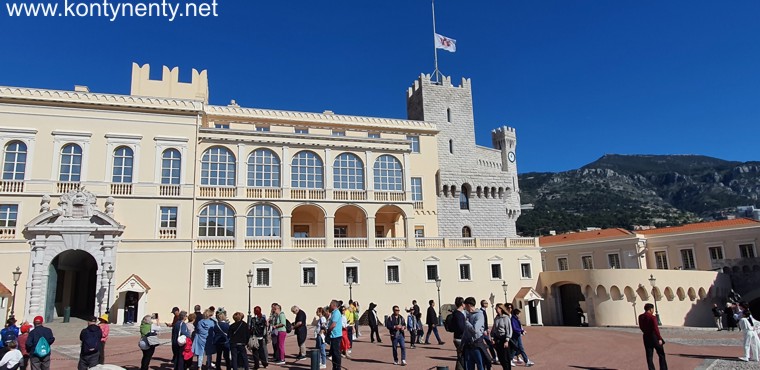 |
||
|
In front of the entrance to the palace, there are guards in ceremonial attire. We happened to be there just in time for the changing of the guard. The spectacle was nice, but looking at these gentlemen, I thought to myself that this was a very boring job. But if there are people willing to do this kind of work, then the working conditions and pay must be very favorable! |
Przed wejściem do pałacu stoją paradnie ubrani gwardziści. Mają nawet białe rękawiczki! Trafiliśmy akurat na moment zmiany warty. Widowisko było ładne, ale patrząc na tych panów pomyślałem sobie, że to bardzo nudne zajęcie. Ale skoro są chętni na taką pracę to zapewne warunki pracy i płacy muszą być bardzo korzystne! |
|
|
|
||
|
From the terrace in front of the palace, a magnificent view opens up over Monte Carlo, the bay filled with the yachts of wealthy people and the coastal mountains. I remember admiring this panorama during my first visit to Monaco. It was in 1974 - 51 years ago. How the time flies! |
Z tarasu przed pałacem otwiera się wspaniały widok na Monte Carlo, zatokę wypełnioną jachtami bogatych ludzi i na nadmorskie góry. Pamiętam, jak podziwiałem tę panoramę podczas mojej pierwszej wizyty w Monaco. Było to w 1974 roku - 51 lat temu. Jak ten czas leci! |
|
|
|
||
|
The second famous monument of the principality is the casino, located on the other side of the bay. To get there, you have to go down the same road to the city, go around the marina and climb the slope again. The casino was opened in 1879, when the royal family found themselves in a difficult financial situation. Since then, more than one gambler has lost a fortune here! That's probably why citizens of Monaco can't play in the casino - it's a casino for the foreigners only! |
Drugim słynnym zabytkiem księstwa jest kasyno, położone po drugiej stronie zatoki. Aby się tam dostać trzeba zejść tą samą drogą do miasta, okrążyć marinę i ponownie wspiąć się na zbocze. Po drodze zwracają uwagę krążące ulicami luksusowe samochody. Kasyno otwarto w 1879 roku, gdy rodzina książęca znalazła się w trudnej sytuacji finansowej. Od tego czasu nie jeden hazardzista stracił tu fortunę! Pewnie dlatego obywatele Monaco grać w kasynie nie mogą - to kasyno wyłącznie dla cudzoziemców! |
|
|
|
||
|
After passing through security, you can enter the ornate casino foyer for free. The gaming rooms open only at 2:00 p.m. It is worth recalling that several popular films have been shot at the casino, including one about James Bond - Agent 007: |
Po przejściu przez kontrolę bezpieczeństwa można wejść bez opłat do bogato zdobionego foyer kasyna. Sale gry otwierają dopiero o 14.00. Warto przypomnieć, że w kasynie nakręcono kilka popularnych filmów, między innymi o agencie 007: |
|
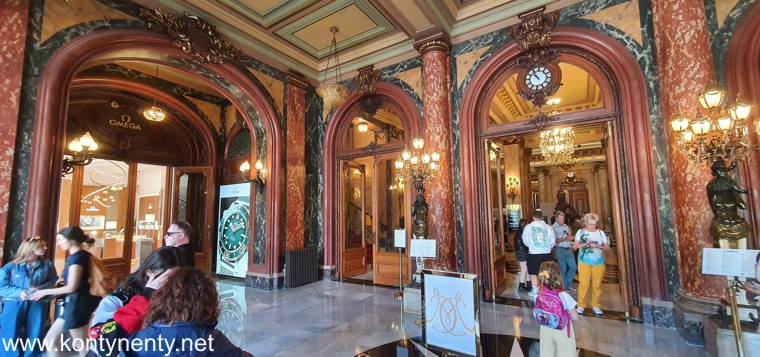 |
||
|
From Monte Carlo we returned to Cannes, where our ship took us back to Barcelona. It was another sunny day. From the port in Barcelona we took an Uber to the airport and there I said goodbye to my boys - they flew to their Oslo, and I - to Warsaw and then to Gdansk. This is how another interesting journey ended... |
Z Monte Carlo wróciliśmy do Cannes, skąd nasz statek zabrał nas na powrót do Barcelony. Z portu w Barcelonie samochodem Ubera dojechaliśmy na lotnisko i tam pożegnałem moich chłopaków - oni odlecieli do swojego Oslo, a ja - do Warszawy i dalej do Gdańska. Tak zakończyła się kolejna ciekawa podróż... |
|
|
You can see the map of this transatlantic part of this voyage here |
Mapkę transatlantyckiej części tej podróży możecie zobaczyć tutaj |
|
|
|
||
|
Two days after the successful end of my Caribbean voyage in February '25, a three-person team from Polish Television showed up at my modest apartment. They found me on the internet and asked me to tell them about my life's passion. The recording lasted almost 2 hours. Then we went to Nowy Port to see what was left of Wąska Street, where I was born and where as a little boy I dreamed of traveling. A very short material came out of it. You can watch it (after watching the obligatory commercial) here. |
Dwa dni po szczęśliwym zakończeniu karaibskiej podróży w lutym 2025 w moim skromnym mieszkaniu zjawiła się trzyosobowa ekipa Telewizji Polskiej. Znaleźli mnie w internecie i poprosili o opowieść o mojej życiowej pasji. Nagrywanie trwało blisko 2 godziny. Potem pojechaliśmy jeszcze do Nowego Portu, aby zobaczyć, co pozostało z ulicy Wąskiej, gdzie się urodziłem i gdzie jako mały chłopiec marzyłem o podróżach. Wyszedł z tego bardzo krótki materiał. Możecie go zobaczyć (po obowiązkowym obejrzeniu reklamy) tutaj. |
|
|
|
||
|
In mid-February I set off once again to the hot and sunny Caribbean. This time not alone, but together with my grandson Kuba, who turns 18 in March. Kuba is interested in the world and travel. He has been with me to Mediterranean ports and Stockholm before, but never overseas... America was still waiting for him. I managed to find a two-week cruise that fits in perfectly with his winter school vacations. And so we flew! First via Amsterdam to Madrid. KLM airline gave me a lot of stress: they didn’t want to check us in online, keeping our (lowest paid) seats blocked in the hope that they would find passengers willing to pay much more for them. Fortunately, they didn’t find any and only at the airport our seats were unblocked. The way to the world was open... But KLM lost its good opinion... The next day we already took pictures at the Plaza Mayor in Madrid: |
W połowie lutego wyruszyłem raz jeszcze na gorące i słoneczne Karaiby. Tym razem nie sam, ale razem z moim wnukiem Kubą, który w marcu kończy 18 lat. Kuba interesuje się światem i podróżami. Był już ze mną wcześniej w portach Morza Śródziemnego i w Sztokholmie, ale nigdy jeszcze za oceanem... Udało mi się znaleźć taki dwutygodniowy rejs, który idealnie wpasowuje się w jego zimowe szkolne wakacje. No i polecieliśmy! Najpierw przez Amsterdam do Madrytu. Linia KLM zafundowała mi niezły stres: nie chcieli nas odprawić online, trzymając nasze (najniżej opłacone) miejsca zablokowane w nadziei, że znajdą pasażerów gotowych zapłacić za nie znacznie więcej. Na szczęście nie znaleźli i na lotnisku nasze miejsca odblokowano. Następnego dnia fotografowaliśmy się na Plaza Mayor w Madrycie: |
|
 |
||
|
We had the whole day to explore the capital of Spain. Kuba is a football fan, so for him the biggest attraction in Madrid was visiting the famous Santiago Bernabeu stadium, often called the capital of world football. We found out that there were many people willing to visit. And the entrance ticket costs 35 euros and it is best to buy it online: |
Na zwiedzanie stolicy Hiszpanii mieliśmy cały dzień. Kuba jest fanem piłki nożnej więc dla niego największą atrakcją Madrytu było zwiedzenie słynnego stadionu Santiago Bernabeu, nazywanego często stolicą światowego futbolu. Przekonaliśmy się, że chętnych do zwiedzania jest wielu. A bilet wstępu kosztuje aż 35 euro i najlepiej kupić go w internecie: |
|
 |
||
|
We bought a 15 euro all-day public transport ticket, including transport to the airport where we were staying. This allowed us to visit many places. In addition to the stadium, we visited the huge Retiro Park, the cathedral and the royal palace in Madrid. Finally, I took Kuba to the bullring (Plaza del Toros) where, in the days of black-and-white photography, I had watched a real bullfight in 1971. Bullfights still take place here. But that day there was only the possibility of visiting the venue with an audio guide. Kuba paid 13 euro for a discounted ticket: |
Wykupiliśmy z Kubą za 15 euro całodzienny bilet na komunikację, z wliczonym dojazdem na lotnisko, gdzie mieszkaliśmy. Pozwalało to odwiedzić wiele miejsc. Poza stadionem oglądaliśmy w Madrycie wielki Park Retiro, katedrę i pałac królewski. Na koniec zawiozłem Kubę do areny (Plaza del Toros) gdzie, w czasach czarno-białej fotografii, w 1971 roku oglądałem prawdziwą corridę. Walki byków wciąż się tu odbywają. Ale tego dnia była tylko możliwość odwiedzenia obiektu z audio-przewodnikiem. Za ulgowy bilet Kuba zapłacił 13 euro: |
|
 |
||
|
The next day the guesthouse staff took us to the airport where we flew to Santo Domingo in the Dominican Republic. It was a 9 hour flight and a 5 hour delay. During the flight we were given 2 meals and drinks. Check-in on arrival went quickly. I was a bit worried about how we would get from the airport to the port of La Romana, about 100 kilometers away, where our ship was waiting, but I easily found representatives of the shipping line behind the baggage hall, who were organizing transport for other passengers - they took us too for a fee of about 20 euros. It took us 1,5 hour to reach the destination. Just before sunset we found ourselves on our beautiful ship, on which I had already sailed before: |
Następnego dnia obsługa pensjonatu odwiozła nas na lotnisku skąd odlecieliśmy do Santo Domingo na Dominikanie. to było 9 godzin lotu i przesunięcie czasu do tyłu o 5 godzin. Podczas lotu dostaliśmy 2 posiłki i drinki. Odprawa po przylocie poszła szybko. Trochę obawiałem się, jak z lotniska dostaniemy się do odległego o około 100 kilometrów portu La Romana, gdzie czekał nasz statek, ale bez trudu znalazłem za salą bagażu przedstawicieli linii żeglugowej, którzy organizowali przejazd dla innych pasażerów - zabrali także i nas za opłatą około 20 euro. Jeszcze przed zachodem słońca znaleźliśmy sie na naszym pięknym statku, na którym pływałem już wcześniej: |
|
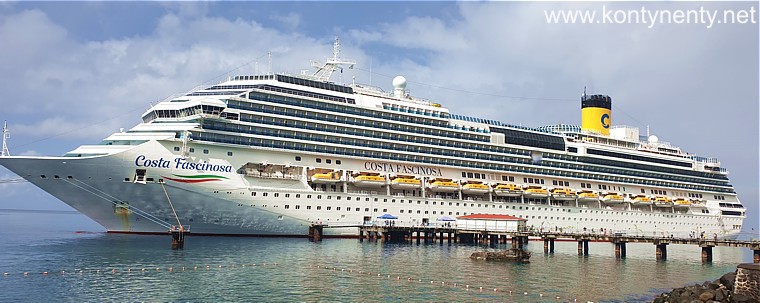 |
||
|
Late in the evening the ship set sail, and the next morning we woke up on the Dutch-French island of St Maarten. Kuba wanted to see Maho Beach there, he had read that landing planes flew very low over it. So we went there by public minibus, paying 2 dollars each way per person (local guilders are also accepted, but they prefere USD). The beach has a truly fabulous water color. And when a large jet plane descends over it, it is a rare spectacle indeed: |
Późnym wieczorem statek wyszedł w morze, a następnego poranka obudziliśmy się na holendersko-francuskiej wyspie St Maarten. Kuba zapragnął zobaczyć tu plażę Maho, czytał, że bardzo nisko nad nią przelatują lądujące samoloty. No i pojechaliśmy tam publicznym mikrobusem, płacąc za przejazd 2 dolary w każdą stronę. Plaża ma naprawdę bajeczny koloryt wody. A gdy obniża się nad nią wielki odrzutowiec to jest to rzeczywiście rzadkie widowisko: |
|
|
|
||
|
Our ship docked in Philipsburg, the capital of a country consisting of one small island. The town is well-kept, full of palm trees and flowers. It also has its own, clean beach and two main streets parallel to the coast, where bars, restaurants and souvenir shops are nestled: |
Nasz statek cumował w Philipsburgu - stolicy kraju składającego się z jednej niewielkiej wyspy. Miasteczko jest zadbane, pełne palm i kwiatów. Ma też własną, czystą plażę i dwie główne ulice równoległe do wybrzeża, w których przycupnęły bary, restauracje i sklepiki z pamiątkami: |
|
 |
||
|
After returning to the ship I could appreciate the beautiful location of this city, the oldest and most beautiful part of which lies at the foot of green hills - on a spit between a bay and a small lagoon. The color of the water in the bay is like on postcards sent from the Caribbean: |
Po powrocie na statek mogłem docenić piękne położenie tego miasta, którego najstarsza i najładniejsza część leży u stóp zielonych wzgórz - na mierzei pomiędzy zatoką i niewielką laguną. Kolor wody w zatoce jest taki jak na pocztówkach wysyłanych z Karaibów: |
|
|
|
||
|
|
Po wyjściu z St Maarten mieliśmy dzień wypoczynku w morzu. Kapitan zaprosił najbardziej lojalnych pasażerów linii Costa na cocktail. Miałem okazję przedstawić się kapitanowi i porozmawiać z nim o podróżach i o planach linii. Była to także okazja do zrobienia nieformalnego zdjęcia. Kapitan di Nunzio, Włoch, był moim 45-tym kapitanem !
After leaving St. Maarten we had a day of relaxation at sea. The captain invited the most loyal Costa passengers for a cocktail. I had the opportunity to introduce myself to the captain and talk to him about the voyages and the company's plans. It was also an opportunity to take an informal photo. Captain di Nunzio, Italian, was my 45th captain! |
|
|
The next destination on our cruise route was the island of Dominica (please do not confuse it with the Dominican Republic). It is probably the poorest island in the Caribbean Sea, but it is called the Garden of the Caribbean. It owes this nickname to its lush, unspoiled nature and limited human interference in the island's landscape attractions: |
Kolejnym celem na trasie naszego rejsu była wyspa Dominika (proszę nie mylić z Dominikaną). To bodaj najbiedniejsza wyspa Morza Karaibskiego, ale za to nazywana jest Ogrodem Karaibów. Ten przydomek zawdzięcza bujnej, nieskażonej przyrodzie i ograniczonej ingerencji człowieka w krajobrazowe atrakcje wyspy: |
|
 |
||
|
Dominica has beautiful waterfalls hidden in the tropical jungle, hot springs and mountain paths leading to volcanic fumaroles, but Kuba wanted to try snorkeling for the first time in his life in a bay poetically named Champagne Bay. You can get there from the island's capital by a road leading along the coast. Along the way we saw the seat of government of this small country, which is a member of the British Commonwealth of Nations: |
Na Dominice są ładne wodospady ukryte w tropikalnej dżungli, gorące źródła i górskie ścieżki prowadzacie do wulkanicznych fumarol ale Kuba chciał po raz pierwszy w życiu spróbować snorkelingu w zatoce nazwanej poetycznie Champagne Bay. Idzie się tam ze stolicy wyspy drogą prowadzącą wzdłuż wybrzeża. Przy trasie obejrzeliśmy siedzibę rządu tego niewielkiego kraju, który jest członkiem Brytyjskiej Wspólnoty Narodów: |
|
|
|
||
|
A local minibus caught on the way took us to the fishing village of Pointe Michel for 3 Caribbean dollars, from where we walked the remaining 2 kilometers. The descent to the small rocky-sandy beach from where you go down to the water with a snorkel is clearly marked. Because it is a nature reserve, they charge a small entry fee of 2 USD per person. A lovely young lady (pictured below) sells shells and seed necklaces nearby, and at the primitive beach bar you can rent a mask, snorkel and fins for just 5 USD. |
Lokalny mikrobus złapany po drodze podwiózł nas za 3 karaibskie dolary do rybackiej wioski Pointe Michel, skąd pozostałe 2 kilometry przeszliśmy pieszo. Zejście na niewielką kamienisto - piaszczystą plażę skąd schodzi się do wody ze snorkelem jest wyraźnie oznakowane. Ponieważ jest to rezerwat przyrody pobierają opłatę po 2 USD. Urocza panienka (na zdjęciu poniżej) sprzedaje obok muszle i naszyjniki z nasion, a w skromnym barze na plaży można za 5 USD wypożyczyć maskę, snorkel i płetwy. |
|
|
|
||
|
Then came the big moment: I showed Kuba how to use the snorkel and... he went into the water! He had to swim about 150 meters to get to where the Champagne Reef begins - the name of this place comes from the visible volcanic springs under the water, from which bubbles of gas rise, like in a champagne bottle. There were a dozen or so people swimming on the reef with an instructor, so I was not worried about my grandson's safety. He came back after more than an hour, happy, because he saw corals, colorful fish, and even turtles: |
Potem nadeszła ta wielka chwila: pokazałem Kubie jak posługiwać się snorkelem i... poszedł do wody! Musiał przepłynąć jakieś 150 metrów, aby znaleźć się tam, gdzie zaczyna sie Szampańska Rafa - nazwa tego miejsca bierze się stąd, że pod wodą są tam widoczne wulkaniczne wywierzyska, z których podrywają się bąbelki gazu, jak w butelce szampana. Na rafie pływało kilkanaście osób z instruktorem, wiec nie obawiałem sie o bezpieczeństwo wnuka. Wrócił po ponad godzinie zadowolony, bo widzał korale, barwne ryby, a nawet żółwie: |
|
 |
||
|
The next day we were already in French Guadeloupe. It had been raining warmly since morning. Nevertheless, we set off to explore. Because fifteen minutes of bright sun were enough to dry our shirts :) We started by looking at the stalls of old Marche, where vanilla and cinnamon stand out among the spices: |
Kolejnego dnia byliśmy już na francuskiej Gwadelupie. Od rana padał ciepły deszcz. Mimo to wyruszyliśmy na zwiedzanie. Bo wystarczył potem kwadrans ostrego słońca, by wysuszyć nasze koszule :) Rozpoczęliśmy od oglądania kramów starego Marche, gdzie wśród przypraw wyróżniają się wanilia i cynamon: |
|
 |
||
|
Then somewhere behind the old port I found a bus to St Anne, where one of the most beautiful beaches in Guadeloupe beckons. We got there for 3 euros (the black driver didn't give tickets, as if he expected the bus to break down halfway. They gave us a new one... Eventually, however, we found ourselves on this beautiful, palm-shaded beach. There were no crowds of tourists. And that's good, because the beach in Ste Anne is charming, but narrow: |
Potem gdzieś za starym portem znalazłem autobus do St Anne, gdzie kusi jedna z najpiękniejszych plaż na Gwadelupie. Dojechaliśmy tam na 3 euro (czarny kierowca nie wydawał biletów, jakby przewidując, że autobus w połowie drogi się zepsuje. Podstawili nam nowy... W końcu jednak znaleźliśmy się na tej pięknej, ocienionej palmami plaży. Tłumu turystów nie było. I dobrze, bo plaże w Ste Anne jest urokliwa, ale wąska: |
|
|
|
||
|
On the beach you can rent water sports equipment, and right next to the beach there are stalls with piles of tropical fruits and vegetables that you can bring for lunch. A kilo of papaya costs 3 euros, and a kilo of mango - 5 euros. We walked this beach to the end. At the end of it is an expensive hotel... |
Na plaży można wypożyczyć wodny sprzęt, a tuż obok plaży są kramy ze stosami tropikalnych owoców i warzyw, które można sobie przynieść na lunch. Kilogramowa papaja kosztuje 3 euro, a kilogram mango - 5 euro. Przeszliśmy tę plażę aż do końca. Na jej krańcu jest drogi hotel... |
|
|
|
||
|
It is worth knowing that the return buses to the island's capital - Point-a-Pitre - do not leave from the coastal street, but from in front of the church of Ste Anne. On our way to this stop, we accidentally came across a noisy demonstration of young people from the local school. They were moving through the center of the town, beating drums of various sizes. The children were dressed in costumes... There was much laughter and joy: |
Warto wiedzieć, że powrotne autobusy do stolicy wyspy - Point-a-Pitre odjeżdżają nie z nadbrzeżnej ulicy, ale sprzed kościoła Ste Anne. Zmierzając do tego przystanku przypadkowo natknęliśmy się na hałaśliwą manifestację młodzieży z tutejszej szkoły. Wstrzymali ruch uliczny. A oni posuwali się przez centrum miejscowości waląc w bębny różnej wielkości. Dzieci przebrane były w kostiumy... Było wiele śmiechu i radości: |
|
|
|
||
|
The next port on our cruise was St. John's on the island of Antigua, known as the island of 365 beaches. We had had enough of beaches for a while, so I decided to show my grandson some historical curiosities about the island. After leaving the port, we headed towards the city market, in front of which stands an interesting monument to the distinguished former president of this tiny country. Here we had to take a souvenir photo: |
Następnym portem na trasie naszego rejsu był St John's na wyspie Antigua, zwanej wyspa 365 plaż. Plaż mięliśmy chwilowo dość, postanowiłem pokazać mojemu wnukowi ciekawostki historyczne tej wyspy. Po wyjściu z portu skierowaliśmy się w kierunku miejskiego targowiska, przed którym stoi ciekawy pomnik zasłużonego byłego prezydenta tego maleńkiego państwa. Tu trzeba było zrobić pamiątkowe zdjęcie: |
|
|
|
||
|
Opposite the St John's Market Hall you will find the Western Bus Station. From here, for USD 1.50 you can take a local minibus to Nelson's Dockyard. This is the most important monument on Antigua. In colonial times, the British had a naval base here in a well-sheltered bay, where they repaired sailing ships that guarded their colonial possessions in the Caribbean. The stone buildings of the base have survived, creating the status of a museum today. Entry fee is USD 15: |
Naprzeciwko hali targowej w St John's znajdziecie Western Bus Station. Stąd za 1,5 dolara USA można pojechać lokalnym mikrobusem do Nelson's Dockyard - Stoczni Nelsona. To najważniejszy zabytek na Antigua. W czasach kolonialnych Brytyjczycy mieli tu w dobrze osłoniętej zatoce bazę morską, w której remontowali żaglowce strzegące ich kolonialnych posiadłości na Karaibach. Kamienne budowle bazy przetrwały, tworzą dziś status muzeum. Za wstęp trzeba zapłacić 15 USD: |
|
|
|
||
|
At the entrance to the bay, where the historic shipyard is located, the Shirley Heights mountain rises. I remembered from previous visits to Antigua that it opens up a magnificent view of several neighboring bays. I think it is one of the most beautiful views in the Caribbean! I wanted to show this view to Cuba. The problem is that you can only get there by a less-traveled road - it is 3.5 kilometers up... Taxi drivers - monopolists charge a lot. I decided to try hitchhiking. And it worked! Me in the cab with a nice Italian, and Kuba in the back of the truck, we quickly reached an extraordinary viewpoint: |
U wejścia do zatoki, w której znajduje sie historyczna stocznia wznosi się góra Shirley Heights. Pamiętałem z poprzednich pobytów na Antigua, że otwiera sie z niej wspaniały widok na kilka sąsiadujących ze sobą zatok. Uważam, że to jeden z najpiękniejszych widoków na Karaibach! Chciałem pokazać ten widok Kubie. Problem w tym, że dostać się tam można tylko mało uczęszczaną drogą - to 3,5 kilometra w górę... Taksówkarze-monopoliści biorą bardzo dużo. Postanowiłem spróbować autostopu. I udało się! Ja w szoferce z sympatycznym Włochem, a Kuba na pace szubko dotarliśmy do niezwykłego punktu widokowego: |
|
 |
||
|
|
Z powrotem z Shirley Heights także zjechaliśmy autostopem - tym razem z młodą amerykańską parą w podróży poślubnej. Po powrocie do stolicy wyspy mieliśmy dość czasu by przejść się po mieście i zrobić kilka ciekawych zdjęć, szczególnie na przylegającym do portu Redcliffe Quay, gdzie czeka pirat - całkiem "jak żywy".
We hitchhiked back from Shirley Heights again - this time with a young American couple on their honeymoon. Back in the island's capital we had plenty of time to wander around the town and take some interesting photos, especially at Redcliffe Quay, adjacent to the harbour, where a pirate - quite "real" - awaits. |
|
|
The next morning we woke up in the British Virgin Islands. The ship docked at Tortola, where I had been many times. It is a very picturesque, touristy island. The port here is surrounded by green hills, which I have climbed many times for extraordinary views. This time the ship's stay lasted only a few hours. I decided that Kuba and I would buy a trip around the island for $30 on board an open safari bus. With an hour's stop on the beach, it lasts a little over 3 hours. The ship offers the same trip for $65: |
Następnego poranka obudziliśmy się na Brytyjskich Wyspach Dziewiczych. Statek zawinął na Tortolę, gdzie byłem już wielokrotnie. To bardzo malownicza, turystyczna wyspa. Port otoczony jest tu zielonymi wzgórzami, na które wiele razy wspinałem się dla niezwykłych widoków. Tym razem postój statku trwał tylko kilka godzin. Zdecydowałem, że razem z Kubą wykupimy sobie za 30 dolarów wycieczkę dookoła wyspy na pokładzie otwartego safari - busa. Z godzinnym postojem na plaży trwa ona nieco ponad 3 godziny. Statek oferuje taką samą wycieczkę za 65 USD: |
|
|
|
||
|
Our vehicle filled up very quickly - after only fifteen minutes we were climbing the winding road to these green hills. Along the way, the driver stopped at places offering beautiful views. We took pictures without getting out of the car, which allowed us to speed up the pace of exploring the island. The lush nature here was very impressive. In the distance, we could see the American Virgin Islands: |
Nasz pojazd wypełnił się bardzo szybko - już po kwadransie wspinaliśmy sie krętą drogą na te zielone wzgórza. Po drodze kierowca przystawał w miejscach oferujących piękne widoki. Robiliśmy zdjęcia bez wysiadania z wozu, co pozwalało przyspieszyć tempo zwiedzania wyspy. Tutejsza bujna przyroda robiła duże wrażenie. W dali widać było Amerykańskie Wyspy Dziewicze: |
|
|
|
||
|
The most spectacular view on the entire route was of the island's capital - Road Town and two cruise ships moored in the bay. The colors of the water were incredible! Postcards like the photo below would definitely find buyers. Except that at the moment, few people buy paper postcards. Tourists snap photos and immediately send them to their loved ones by e-mail: |
Najbardziej efektowny na całej trasie był widok na stolicę wyspy - Road Town i dwa wycieczkowe statki zacumowane w zatoce. Takie pocztówki jak zdjęcie poniżej na pewno by znalazły nabywców. Tylko, że w tej chwili już mało kto kupuje papierowe pocztówki. Turyści pstrykają zdjęcia i niezwłocznie wysyłają je do swoich bliskich pocztą elektroniczną: |
|
|
|
||
|
From the mountain ridge we went down to Cane Garden Bay, to visit a small settlement, first a rum distillery (it costs a dollar to try this local product) and then spend an hour on a very nice beach. Unfortunately, you have to pay extra for sunbeds here: |
Z górskiego grzbietu zjechaliśmy do zatoki Cane Garden, by w niewielkiej osadzie najpierw odwiedzić destylarnie rumu (próbowanie tego miejscowego produktu kosztuje dolara) a potem spędzić godzine na bardzo ładnej plaży. Niestety za leżaki trzeba tu płacić dodatkowo: |
|
|
|
||
|
|
Tu wypada może przypomnieć, że wieczorami, gdy statek wychodził z portu czekały na nas liczne rozrywki. Nie tylko muzyka na żywo w kilku różnych miejscach i przedstawienia w teatrze, ale także imprezy na otwartym pokładzie: wspólne tańce i śpiewy, inspirowane przez animatorów. Byliśmy przecież w tropiku, gdzie temperatury nocne przekraczały nawet 25 stopni. Po kilku dniach rejsu poznałem liczną grupę Polaków z Wielkiej Brytanii, którzy podróżowali na tym samym statku. Miło było porozmawiać po Polsku o wrażeniach i wymienić doświadczenia. Oto nasze zbiorowe zdjęcie podczas tzw. białej nocy: It is perhaps worth mentioning here that in the evenings, when the ship left port, we were treated to a variety of entertainment. Not only live music in several different places and performances in the theatre, but also events on the open deck: joint dancing and singing, inspired by the animators. After all, we were in the tropics, where night temperatures exceeded even 25 degrees. After a few days of the cruise, I met a large group of Poles from Great Britain who were travelling on the same ship. It was nice to talk in Polish about our impressions and exchange experiences. Above is our group photo during the so-called white night. |
|
|
|
||
|
From Tortola in the Virgin Islands, our ship returned to La Romana. The first loop of our Caribbean sea voyage had closed. The "Costa Fascinosa" had been docking in this port all day, disembarking groups of passengers and embarking new ones. And we had all day to explore. La Romana is a small town. There are few monuments here. In the main square stands the town hall, and in front of it are metal sculptures of bulls: |
Z Tortoli na Wyspach Dziewiczych nasz statek zawrócił do La Romana. Zamknęła się pierwsza pętla naszej morskiej podróży po Karaibach. "Costa Fascinosa" stała w tym porcie cały dzień, wysadzając grupy pasażerów i okrętując nowych. A my mieliśmy cały dzień na zwiedzanie. La Romana jest małym miasteczkiem. Niewiele tu zabytków. Przy głównym placu stoi ratusz, a przed nim rzeźby z metaloplastyki, przedstawiające byki: |
|
|
Little port in La Romana |
|
|
|
The Dominican Republic's national holiday, celebrated on February 27, was approaching. The city was decorated with flags in advance. Kuba took the opportunity to take a picture of me with the country's colors: |
Zbliżał się dzień święta narodowego Dominikany, obchodzony 27 lutego. Miasto było z wyprzedzeniem udekorowane flagami. Kuba zrobił mi przy tej okazji zdjęcie z barwami tego kraju: |
|
 |
||
|
I suggested to my grandson that we take a public bus to the capital, Santo Domingo. There is a small port in Santo Domingo, but it was not on our cruise itinerary. I found the Espresso Romana bus station, more than 4 kilometers from the port. Air-conditioned buses to the capital leave every hour, and a ticket costs 225 pesos. At the ticket office, they are happy to exchange dollars for pesos, but they charge 50 pesos, while the official rate is 60 pesos to the dollar. Soon we were driving through sugar cane plantations: |
Zaproponowałem wnukowi, abyśmy pojechali publicznym autobusem do stolicy kraju - Santo Domingo. W Santo Domingo jest wprawdzie mały port, ale nie było go w programie naszego rejsu. Odnalazłem stację autobusów Espresso Romana, odległą od portu o ponad 4 kilometry. Klimatyzowane autobusy do stolicy odjeżdżają co godzinę, a bilet kosztuje 225 pesos. W kasie chętnie wymieniają dolary na pesos, ale płacą po 50 peso podczas gdy oficjalny kurs to 60 pesos za dolara. wkrótce jechaliśmy już wśród plantacji trzciny cukrowej: |
|
 |
||
|
I had been to Santo Domingo few times before, so I easily found my way to the old part of town called Zona Colonial. It has its own atmosphere, it is clean and safe. Many of the narrow streets have been transformed into pedestrian promenades. The hosts paint their houses in pastel colors and take care of the tropical flowers planted in the lawns and on the balconies: |
W Santo Domingo byłem wcześniej kilka razy więc bez trudu znalazłem drogę do starej części miasta nazywanej Zona Colonial. Ma ona swój nastrój, jest tu czysto i bezpiecznie. Wiele wąskich uliczek zamienionych jest na piesze deptaki. Gospodarze malują domy w pastelowe kolory i dbają o posadzone w gazonach i na balkonach tropikalne kwiaty: |
|
 |
||
|
The former wealth and splendor of the city are also evidenced by the ruins of historic buildings - for example, the impressive walls of the former monastery of San Francisco: |
O dawnym bogactwie i świetności miasta świadczą także pozostawione ruiny historycznych budowli - na przykład imponujące mury dawnego klasztoru San Francisco: |
|
 |
||
|
At the main square of the old town, the elegant town hall draws attention. In the shade of the spreading trees on this square, free lessons on playing various instruments are held on Sunday mornings, I once came here at such a time and I really liked the training! One side of the square is occupied by a low cathedral. Unfortunately, they only let people into the carefully rebuilt interior of the cathedral during services - it's a strange custom! : |
Przy głównym placu starego miasta zwraca uwagę elegancki ratusz. w cieniu rozłożystych drzew na tym placu w niedzielne poranki odbywają się bezpłatne lekcje gry na różnych instrumentach, kiedyś trafiłem tu w taki czas i bardzo mi sie to szkolenie podobało! Jedną pierzeje placu zajmuje niska katedra. Do starannie odbudowanego wnętrza katedry niestety wpuszczają tylko w porze nabożeństw - to dziwny obyczaj! : |
|
 |
||
|
The defensive structures of the Dominican Republic capital are represented by Fortaleza Ozama (entrance 100 pesos or 2 USD). It was built in 1502 and was the first military structure in the newly discovered America. The fort is part of the monumental complex of Santo Domingo, placed on the UNESCO World Heritage List: |
Budowle obronne stolicy Dominikany reprezentuje Fortaleza Ozama (wstęp 100 pesos lub 2 USD). Zbudowano ją w 1502 roku i była to pierwsza budowla militarna w świeżo odkrytej Ameryce. Fort jest częścią zespołu zabytkowego Santo Domingo, umieszczonego na liście world Heritage UNESCO: |
|
|
|
||
|
The main promenade of the Old Town, where painters display their works for sale, leads to the Conde city gate, and right behind it is the mausoleum of the three fathers of the nation (photo below). Although it was not yet the national holiday, inside there was the smell of flowers laid in tribute to the heroes: |
Głównym deptakiem Starego Miasta, gdzie malarze wystawiają swoje prace na sprzedaż dojść można do bramy miejskiej Conde, a tuz za nią jest mauzoleum trzech ojców narodu (zdjęcie poniżej) Mimo, że to jeszcze nie był dzień narodowego święta wewnątrz pachniały złożone w hołdzie bohaterom kwiaty: |
|
|
|
Chciałem jeszcze pokazać Kubie położony nieco na uboczu, bardzo reprezentacyjny pałac prezydencki (na zdjęciu poniżej. Pałac jest silnie strzeżony, ale żołnierze pozwalają robić zdjęcia prze misternie kutą bramę... I also wanted to show Cuba the very representative presidential palace, located a bit off the beaten track (pictured below). The palace is heavily guarded, but soldiers allow photos to be taken through the intricately forged gate... |
|
 |
||
|
XBoth of us (grandfather and grandson) have long legs, so with a little effort we made it to the return bus at 3:30 p.m. Two hours later we were in La Romana. The ship did not go out to sea until night, and the next morning we saw a small, deserted island next to it - it was Isla Catalina, which belonged to the Dominican Republic. There was no quay here - passengers were taken to the shore by shuttle tenders - large motorboats: |
Obaj (dziadek i wnuk) mamy długie nogi, wiec przy odrobinie wysiłku zdążyliśmy na powrotny autobus o 15.30. W dwie godziny później byliśmy w La Romana. Statek wyszedł w morze dopiero w nocy, a następnego poranka zobaczyliśmy obok niego małą, bezludną wyspę - to była należąca do Dominikany Isla Catalina. Tu nie było nabrzeża - pasażerów na brzeg woziły kursujące wahadłowo tendery - duże motorówki: |
|
|
|
||
|
We spent the whole day on the islet of Catalina. It is the quintessence of tropical paradise. The shipping company has a beach here with free sunbeds and umbrellas. They serve free lunch, organize dance shows and games. There is a folkloric band playing. But you can't go beyond the beach: the rest of the island is covered in dense vegetation, through which there are no paths: |
Na wysepce Catalina spędziliśmy cały dzień. To kwintesencja tropikalnego raju. Kompania żeglugowa ma tu plażę z bezpłatnymi leżakami i parasolami. Serwuje się bezpłatny lunch, organizuje pokazy taneczne i gry. Gra folklorystyczny zespół. Ale poza plażę nie da się wyjść: pozostała część wyspy pokryta jest gęstą roślinnością, prze którą nie poprowadzono żadnych ścieżek: |
|
 |
||
|
Our ship sailed through the night to our next landing point on the sparsely developed Samana Peninsula - on the northern side of the island. We anchored opposite the small town of Samana, which lies deep in a shallow and narrow bay. Flat-bottomed tenders carried us to a small jetty (photo below). The peninsula is famous for its wildlife and beautiful beaches. For now, few tourists come here. |
Statek płynął nocą do naszego następnego punktu lądowania na słabo zagospodarowanym turystycznie Półwyspie Samana - po północnej stronie wyspy. Kotwiczyliśmy naprzeciw małego miasteczka Samana, które leży w głębi płytkiej i ciasnej zatoki. Płaskodenne tendery woziły nas do niewielkiego pomostu (zdjęcie poniżej). Półwysep słynie z dzikiej przyrody i pięknych plaż. Na razie trafia tu niewielu turystów. |
|
 |
||
|
From the jetty you go out to the street where there is a tourist information kiosk. On the other side of the street there is a good hotel, visible in the picture, where the reception provides Wi-Fi. Just don't come there in a herd! :) There are no beaches in the settlement of Samana. But if you turn left, you can reach the Estacion Guagua (bus station) and from there go to the fishing village of Galeras, famous of the beaches, which is what we did. This is still Samana township: |
Z pomostu wychodzi się na ulicę, gdzie stoi kiosk informacji turystycznej. Po drugiej stronie ulicy stoi widoczny na zdjęciu dobry hotel, gdzie recepcja udostępnia sieć wi-fi. Tylko nie przychodźcie tam całym stadem! :) W osadzie Samana nie ma plaż. Ale skręcając ulica w lewo można dojść do Estacion Guagua (stacji autobusów) i stąd pojechać do rybackiej wioski Galeras, słynnej z plaż, co właśnie zrobiliśmy. To jeszcze Samana town: |
|
 |
||
|
We drove to Las Galeras more than half an hour. We found there a wide and empty beach. Local fishermen still go out to fish, but they also offer transport for tourists to other beautiful beaches: |
Do Las Galeras jechaliśmy mnieco ponad pół godziny. Zastaliśmy tu szeroką i pustą plażę. Miejscowi rybacy wciąż wypływają na połowy, ale oferują także transport dla turystów do innych, pięknych plaż: |
|
 |
||
|
At a distance of about a kilometer from Galeras there is the praised Playita beach. We went there and it turned out that it is indeed a beautiful place and also developed for tourism (paid sunbeds, bar, equipment rental). In addition, in the omnipresent heat, comfort in the form of shade is provided by spreading trees: |
W odległości około kilometra od Galeras jest zachwalana plaża Playita. Poszliśmy tam i okazało się, że rzeczywiście jest to piękne miejsce i do tego zagospodarowane turystycznie (odpłatne leżaki, bar, wypożyczalnia sprzętu). Ponadto we wszechobecnym upale komfort w postaci cienia zapewniają rozłożyste drzewa: |
|
|
|
||
|
On the Samana Peninsula, there are no large holiday resorts and crowds of foreign tourists, and the nature is still unspoiled. Here, too, you can see the traditional lifestyle of the inhabitants: modest, single-story houses surrounded by palm trees and banana trees, as in the photo below. This was my visit to this part of the Dominican Republic. I think it is worth a visit! |
Na Półwyspie Samana nie ma jeszcze wielkich ośrodków wczasowych i tłumów zagranicznych turystów, a przyroda jest jeszcze nieskażona. Tu także można zobaczyć tradycyjny styl życia mieszkańców: parterowe skromne domki otoczone palmami i bananowcami, jak na zdjęciu poniżej. Była to moja wizyta w tej części Dominikany. Uważam, że warto tam zajrzeć! |
|
 |
||
|
The only English-speaking island we visited on the second loop of our cruise was Grand Turk - one of the two islands of the forgotten state of "Turk and Caicos". It is former British colony - not the member of Commonwealth. I had been there before and remembered it as a run-down flat atoll that a good walker could walk around in a full day. When I went out on deck in the morning and looked at the coast, I was amazed by the extensive tourist village, which you enter directly from the marina, where two ships can dock at the same time: |
Jedyną anglojęzyczna wyspą, którą odwiedziliśmy w drugiej pętli naszego rejsu był Grand Turk - jedna z dwóch wysp zapomnianego państwa "Turk and Caicos". Kiedyś już tam byłem i zapamiętałem, że jest to zapyziały płaski atol, który dobry piechur może obejść w ciągu jednego dnia na piechotę. Kiedy rano wyszedłem na pokład i popatrzyłem na wybrzeże zdumiała mnie rozbudowana turystyczna wioska, do której wchodzi się wprost z przystani, w której mogą cumować jednocześnie dwa statki: |
|
|
|
||
|
The great and unseen advantage of this "port" is the fact that you can go straight from the port pier to a beautiful, sandy beach, where you can laze around all day. In the nearby tourist village there are not only a lot of shops, palm trees and flowers, but also swimming pools for sports: |
Wielką i nigdzie więcej nie spotykaną zaletą tego "portu" jest fakt, że prosto z portowego molo schodzi się na piękną, piaszczystą plażę, gdzie można przeleniuchować cały dzień. W turystycznej wiosce obok jest nie tylko masa sklepów, palmy i kwiaty ale także baseny do uprawiania sportów: |
|
|
|
||
|
After visiting this tourist ghetto with the dozen shops selling luxury goods, as we did years ago, we marched along the salinas - shallow ponds where salt was extracted from seawater in the old days - to the only town on Grand Turk - Cockburn. After passing a model of a space capsule that once landed with an American astronaut near the island (it was placed at the intersection near the airport), on the left is the seat of government located in the modest pink villa, and just beyond - the city center marked by a tower with a long-defunct clock: |
Po zwiedzeniu tego getta dla turystów jak przed laty pomaszerowaliśmy wzdłuż pasa salin - płytkich stawów, w których w dawnych czasach pozyskiwano sól z wody morskiej - do jedynego miasteczka na Grand Turk - Cockburn. Po minięciu modelu kosmicznej kapsuły, która z amerykańskim astronauta wylądowała kiedyś w pobliżu wyspy (ustawiono go na skrzyżowaniu koło lotniska) po lewej jest siedziba władz, a zaraz dalej - centrum miasta wyznaczone przez wieżę z nieczynnym od dawna zegarem: |
|
|
|
||
|
Years ago I visited a museum here, set up in an old prison. Today I found the place locked up and overgrown. In the coastal street, a few souvenir stalls have opened to celebrate the arrival of the ships. There is a bar next to it, and that is probably all there is to see in the capital of the island, whose narrow streets are dominated by such small, modest houses: |
Przed laty zwiedzałem tu muzeum urządzone w starym więzieniu. Dziś zastałem ten obiekt na głucho zamknięty i zarośnięty. W nadbrzeżnej ulicy z okazji przybycia statków otwarto kilka kramów z pamiątkami. obok działa bar i to już chyba wszystko, co jest do zobaczenia w stolicy wyspy, w której wąskich uliczkach dominują takie małe, skromne domki: |
|
 |
||
|
The tourist village by the marina (pictured below) looks much better than the town! And what else is worth seeing here? On the opposite end of the island stands a graceful lighthouse, but I decided it wasn't worth the long walk in the heat. Wealthy tourists rent multi-person moto rickshaws by the port to go to the town and then to the lighthouse... |
Turystyczna wioska przy przystani (na zdjęciu poniżej) prezentuje się znacznie lepiej niż miasteczko! I co jeszcze warto tu zobaczyć? Na przeciwległym krańcu wyspy stoi zgrabna latarnia morska, ale uznałem, że nie jest warta długiego marszu w upale. Zamożni turyści wynajmują przy przystani kilkuosobowe spalinowe riksze by pojechać do miasteczka i dalej - do latarni... |
|
 |
||
|
The next night, "Costa Fascinosa" sailed back to the Dominican Republic - to the Amber Cove bay. When you look at the map, it seems that Amber Cove is very close to the city of Puerto Plata. Only when you get there does it turn out that the distance is 13 kilometers. Here, too, by the pier, there is a tourist village and... a crowd of aggressive taxi drivers fighting for customers. We went out onto the expressway looking for a bus stop. No one wanted to help! Finally, I paid the taxi driver $20 for the ride to Puerto Plata... He left us in front of the Macorix Rum Distillery, praising the tour of the facility: |
Kolejnej nocy "Costa Fascinosa" płynęła z powrotem na Dominikanę - do zatoki Amber Cove. Gdy patrzy się na mapę, wydaje się, że Amber Cove leży bardzo blisko miasta Puerto Plata. Dopiero na miejscu okazuje się, że odległość ta wynosi aż 13 kilometrów. Tu też przy przystani jest turystyczna wioska i... tłum agresywnych taksówkarzy walczących o klientów. Wyszliśmy aż na przelotową drogę szybkiego ruchu szukając przystanku autobusowego. Nikt nie chciał pomóc. W końcu zapłaciłem taksówkarzowi 20 dolarów za kurs do Puerto Plata... Zostawił nas przed destylarnia rumu Macorix, zachwalając zwiedzanie obiektu: |
|
|
|
||
|
The tour with tasting cost 8 dollars, and the main point of the program was the screening of a 7-minute film about the history of the company. At the end there was a modest tasting of the drink, we did not see the rum production process at all. I think it was a typical "tourist trap" calculated to make money! Then we walked to the city center, where an Independence Day parade was taking place on the waterfront promenade: |
Za zwiedzanie z degustacją trzeba było zapłacić po 8 dolarów, a głównym punktem programu była projekcja 7-minutowego filmu o historii firmy. Na końcu była skromna degustacja trunku, nie widzieliśmy wcale procesu produkcji rumu. Uważam, że był to typowy "tourist trap" obliczony na zarobienie pieniędzy! Dalej poszliśmy już pieszo do centrum miasta, gdzie na nadbrzeżnej promenadzie trwał pochód z okazji Święta Niepodległości: |
|
|
|
||
| any women and children followed the festive manifestation in the national colors of the Dominican Republic: |
Wiele kobiet i dzieci podążało w świątecznym pochodzie w narodowych kolorach Dominikany: |
|
|
|
|
|
|
In the city's central square, the cathedral with three towers (unfortunately it was closed) and the ornate, two-story gazebo attract attention. In front of the leader's monument on the day of the celebration, wreaths were placed (we lay wreaths, and they put them on stands): |
Na centralnym placu miasta zwraca uwagę katedra z trzema wieżami (niestety była zamknięta) oraz ozdobne, piętrowe gazebo. Przed pomnikiem jakiegoś znaczącego przywódcy w dniu święta ustawiono wieńce (my składamy wieńce, a oni je ustawiają na stojakach): |
|
 |
||
|
It was my first visit in Puerto Plata and I was very curious about this city. I found it interesting in color and many places worth visiting. Tourists have their own street in Puerto Plata closed to traffic. There are bars, cafes and souvenir shops here. They call it Umbrela Street: |
Była to moja pierwsza wizyta w Puerto Plata i bardzo byłem ciekaw tego miasta. Znalazłem w nim ciekawy koloryt i wiele miejsc wartych odwiedzenia. Turyści mają w Puerto Plata swoją zamkniętą dla ruchu uliczkę. Są tu bary, kawiarnie i sklepiki z pamiątkami. Nazywają ją potocznie Umbrela Street: |
|
|
|
|
|
|
The most important monument in Puerto Plata is Fortaleza San Felipe (entrance fee: 100 pesos or $2). Fortaleza stands on a promontory protecting the port. Because Puerto Plata also has a port - two large Celebrity Cruise line passenger ships were docked there. |
Najważniejszym zabytkiem w Puerto Plata jest jednak Fortaleza San Felipe (za wstęp trzeba zapłacić 100 pesos lub 2 dolary). Fortaleza czyli obronny fort stoi na cyplu osłaniającym port. Bo w Puerto Plata też jest port - stały w nim dwa duże statki pasażerskie linii Celebrity. |
|
 |
||
|
Leaving town I found a small yard of Javilla Tours company in the exit street . They offer no tours, but a regular bus service to Santiago via Amber Cove. The return trip to Amber Cove in their minibus cost us 50 pesos per person, less than a dollar! Why they did not tell us this on the ship? That evening in our ship's theater we watched a lively show performed by artists from the Dominican Republic! |
Opuszczając miasto znalazłem w wylotowej ulicy niewielkie podwórko firmy Javilla Tours. Nie oferują oni żadnych wycieczek, ale regularne połączenie autobusowe do Santiago via Amber Cove. Za powrotną podróż do Amber Cove ich minibusem zapłaciliśmy po 50 pesos, czyli mniej niż dolara! Tego wieczoru w naszym statkowym teatrze obejrzeliśmy żywiołowy show w wykonaniu artystów z Dominikany! |
|
|
|
||
|
On this cruise I was to visit yet another unknown place: a brand new, recently built resort on the deserted coast of the Dominican Republic, Cabo Rojo. No one could say anything about it! We were there the next morning: |
W tym rejsie miałem odwiedzić jeszcze jedno nieznane miejsce: zupełnie nowy, zbudowany niedawno na pustym wybrzeżu Dominikany ośrodek Cabo Rojo. Nikt o nim nic nie mógł powiedzieć! Znaleźliśmy się tam następnego poranka: |
|
 |
||
|
From the solid, concrete pier where the ship is moored, passengers descend to a large, artificial island on which an amusement park has been built. The red earth just behind the entrance is the "Wild West" area, on whose bumps you can ride quads. To the left of it is the "gold mine area" from the mid-20th century with vintage vehicles, bars and saloons: |
Z solidnego, betonowego molo, przy którym cumuje statek pasażerowie schodzą tu na dużą, sztuczną wyspę, na której zbudowano park rozrywki. Czerwona ziemia zaraz za wejściem to obszar "Dzikiego Zachodu" po którego wertepach jeździć można quadami. Na lewo od niego jest "teren kopalni złota" z połowy XX wieku z zabytkowymi pojazdami, barami i saloonami: |
|
 |
||
|
Moving on, we reached an amusement park with a huge ferris wheel, a giant swing and other attractions. The passengers of our ship did not pay for these attractions - perhaps because the institution was newly opened and the hosts were promoting their business: |
Idąc dalej dotarliśmy do lunaparku z wielkim diabelskim kołem, gigantyczną huśtawką i innymi atrakcjami. Za te atrakcje pasażerowie naszego statku nie płacili - być może dlatego, że instytucja była świeżo otwarta i gospodarze promowali swój biznes: |
|
 |
||
|
Further on we discovered an artificial beach with young palm trees planted and white sand brought in. The beach is intersected by shallow channels where you can swim on inflatable rings. There are also pools with wooden tables under umbrellas and armchairs where you sit with your feet in the water. What people don't come up with! |
Dalej odkryliśmy sztuczną plażę z flancowanymi młodymi palmami i nawiezionym białym piaskiem. Plażę przecinają płytkie kanały, na których można pływać na nadmuchiwanych kołach. Są tu także baseny do których wstawiono drewniane stoliki pod parasolami i foteliki, na których siedzi się z nogami w wodzie. Czego to ludzie nie wymyślą! |
|
 |
||
|
Beyond the causeway that connects the artificial island to the mainland, on the left is the normal "Baby beach," where you have to pay $35 at the entrance for a lounger and unlimited drinks at the bar. When we finally crossed the gate at the end of the causeway and found ourselves on the road where the taxis were parked, we had two options: take a taxi to the left to the nearest town or walk to the right to a wild, "public" beach, on the road like this: |
Za groblą, która łączy sztuczną wyspę z lądem stałym po lewej jest normalna plaża "Baby beach", gdzie trzeba przy wejściu zapłacić 35 dolarów za leżankę i nieograniczone drinki w barze. Gdy w końcu na końcu grobli przekroczyliśmy bramę i znaleźliśmy się na szosie, gdzie stały taksówki mieliśmy dwie opcje: jechać taksówka w lewo - do najbliższego miasteczka lub iść pieszo w prawo - na dziką, "publiczną" plażę - taką oto drogą: |
|
 |
||
|
After about 500 meters of walking through the bushes on the right, the azure water was already visible. The wild, narrow beach was almost empty and encouraged free bathing. It was quiet, without music playing through megaphones and the roar of quads. In the distance, you could see the buildings of the resort: |
Po około 500 metrach marszu przez krzaki buszu po prawej widać już było lazur wody. Dzika, wąska plaża była niemal pusta i zachęcała do bezpłatnej kąpieli. Było cicho, bez muzyki płynącej przez megafony i warkotu quadów. W dali widać było zabudowania ośrodka: |
|
 |
||
|
From this wild beach I took the last photo of our ship in beautiful scenery. In the evening of that day we had a farewell party in the theater. And the next morning we got off the ship in the well-known port of La Romana in the Dominican Republic... |
Z tej dzikiej plaży ostatni raz w pięknej scenerii fotografowałem nasz statek. Wieczorem tego dnia mieliśmy pożegnalną imprezę w teatrze. A kolejnego poranka wysiedliśmy ze statku w znanym nam porcie La Romana na Dominikanie... |
|
 |
||
|
In La Romana we took a minibus organized by our ship's cruise company to the airport in Santo Domingo. From there, via Madrid and Dublin, we safely returned to Gdansk. For both of us, it was an unforgettable, fully successful winter journey in the sun and tropical scenery. As always, you will find hot notes from the journey in my travel log. |
Minibusem zorganizowanym przez biuro wycieczkowe naszego statku dojechaliśmy na lotnisko w Santo Domingo. Stąd przez Madryt i Dublin szczęśliwie wróciliśmy do Gdańska. Dla nas obu była to niezapomniana, w pełni udana zimowa podróż odbywana w słońcu i tropikalnej scenerii. Robione na gorąco zapiski z trasy podróży znajdziecie jak zawsze w moim dzienniku podróży. |
|
|
|
||
|
On January 29th, 2025, my friend, Captain Jerzy Wąsowicz, passed away to the watch in the heavens. He was a wonderful man, honest and kind to everyone!! One of those rare captains who (like me) was chasing their dreams all his life, and did not care about setting any records. In the nineties, Jurek sailed around the world on his own renovated yacht, "Antica". Jurek was coming to the meetings where I talked about the world. I was several times on his legendary yacht, where he introduced me (I don't know if deservedly) as "the greatest Polish traveler". Salute to you Captain, and see you on the eighth continent! |
29 stycznia 2025 odszedł na wieczną wachtę mój przyjaciel - kapitan Jerzy Wąsowicz. Był to wspaniały człowiek, szczery i życzliwy dla wszystkich! Jeden z tych nielicznych kapitanów, którzy (jak ja) przez całe życie gonili swoje marzenia, a nie dbali o ustanawianie rekordów. W latach dziewięćdziesiątych Jurek opłynął świat na własnoręcznie wyremontowanym jachcie "Antica". Jurek przychodził na spotkania, na których opowiadałem o świecie. Bywałem na jego legendarnym jachcie, gdzie przedstawiał mnie (nie wiem czy zasłużenie) jako "największego polskiego podróżnika". Cześć Ci Kapitanie i do spotkania na ósmym kontynencie! |
|
|
Few days after welcoming new year 2025 I packed my backpack again and set off for warmer and sunnier countries. First, by Flix bus to Vienna, and from there, for very little money, by low-cost plane to the United Arab Emirates. It was supposed to be an interesting alternative to the gray and short January days in Poland. I knew that the temperatures of the Polish summer would reign in the Persian Gulf region! I landed in Abu Dhabi: |
Kilka dni po powitaniu nowego roku 2025 ponownie spakowałem plecak i wyruszyłem do cieplejszych i bardziej słonecznych krajów. Najpierw autobusem do Wiednia, a stamtąd, za bardzo niewielkie pieniądze samolotem do Emiratów Arabskich. To miała być ciekawa alternatywa dla styczniowych szarych i krótkich dni w Polsce. Wiedziałem, że w rejonie Zatoki Perskiej będą królowały temperatury polskiego lata! Wylądowałem w Abu Dhabi: |
|
|
|
||
|
I've been to the capital of the Emirates several times, but the city is changing rapidly and there's a lot to see. So I stayed in a $25 room and spent my days walking, enjoying the sun, beautiful modern architecture and views of the seaside promenade: |
W stolicy Emiratów byłem już kilkakrotnie, ale to miasto zmienia się szybko i jest tu wiele do zobaczenia. Zamieszkałem więc w pokoju za 25 dolarów i dni upływały mi na pieszych wycieczkach podczas których cieszyłem się słońcem, piękną, nowoczesną architekturą i widokami nadmorskiej promenady: |
|
|
|
||
|
Contact with people was worse. Because those you meet on the streets here are not Arabs - citizens of this country, but almost exclusively guest workers from Pakistan and poorer Arab countries. Hunting down a local on the street with a camera is not easy here. Figures in white robes and turbans appear on the sidewalks rather rarely: |
Gorzej było z kontaktem z ludźmi. Bo ci, których spotyka się tu na ulicach to nie Arabowie - obywatele tego kraju, ale niemal wyłącznie gastarbeiterzy z Pakistanu i biedniejszych krajów arabskich. Upolować z kamerą tubylca na ulicy nie jest tu łatwo. Postacie w białych szatach i zawojach pojawiaja sie na chodnikach raczej rzadko: |
|
|
|
||
|
Back in the fifties, a small fort called Qasr al Hosn stood here in the desert, surrounded by a dozen houses. During my previous visits to Abu Dhabi, I was unable to visit this unique monument in the city, as it was being reconstructed and renovated. Now it is open, as I saw for myself. I also found out that they charge 30 dirhams to enter this small structure. I asked for a discount, showing my passport and jokingly emphasizing that it is my birthday today. Local seniors have free entry! What not the seniors from other countries? The woman in black was adamant. I decided to take only a photo of the courtyard: |
Jeszcze w latach pięćdziesiątych stał tu na pustyni otoczony tuzinem domów mały fort Qasr al Hosn. Podczas moich poprzednich pobytów w Abu Dhabi nie mogłem odwiedzić tego jedynego w mieście zabytku, gdyż był rekonstruowany i odnawiany. Teraz już jest otwarty, o czym przekonałem się osobiście. Przekonałem się także, że za wejście do niewielkiego przecież obiektu pobierają 30 dirhamów. Proszę o zniżkę, pokazując swój paszport i żartem podkreślając, że mam dziś urodziny. Miejscowi seniorzy mają wstęp bezpłatny! Kobieta w czerni była nieugięta. Poprzestałem na zdjeciu dziedzińca: |
|
|
|
||
|
A step away from the fort is a small, modernly designed mosque, and next to it, by an artificial pond - an expensive cafe where locals meet. I asked them for a photo, and then complained that they discriminated against foreigners by refusing discounts. The Saudis' reaction was unexpected: they expressed their regret, and then invited me to a table, where there was a special cake with a "Happy Birthday!" card stuck in it. |
O krok od fortu jest mały, współcześnie zaprojektowany meczet, a obok niego, nad sztucznym stawem - droga kawiarnia, w której spotykają się miejscowi. Poprosiłem ich o zdjęcie, a potem wyżaliłem się, że dyskryminują cudzoziemców, odmawiając zniżek. Reakcja Saudyjczyków była nieoczekiwana: wyrazili swój żal, a potem zaprosili do stolika, na którym pojawiło sie okolicznościowe ciasto z zatkniętą kartą "Happy Birthday!". |
|
|
|
|
|
|
I have been to Abu Dhabi several times but never had time to go to the Sultan's Al Watan Palace. And finally the day came! I knew that I would have to pay about 60 dirhams for entry, but it was a vast palace! In the glorious sunshine and a temperature of 23 degrees I got off the shuttle bus in a garden full of palm trees, fountains and flowers (I was delighted by the petunias in Polish colors). |
Byłem w Abu Dhabi już kilka razy, ale nigdy nie miałem czasu pojechać do sułtańskiego pałacu Al Watan. No i w końcu nadszedł ten dzień! Wiedziałem, że za wstęp przyjdzie mi zapłacić około 60 dirhamów, ale to był rozległy pałac! Przy wspaniałym słońcu i temp. 23 stopni wysiadłem z shhuttle busu w ogrodzie pełnym palm, fontann i kwiatów (uradowały mnie petunie w polskich barwach). |
|
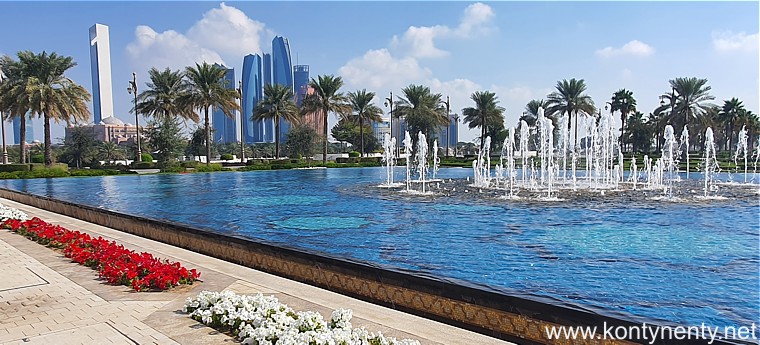 |
||
|
I stood in front of the entrance, amazed. The palace is impressive in size, its dome has a diameter of 37 meters. Officially, it is said and written that it is the Presidential Palace of the Emirates. This is where government meetings are held, foreign guests are received and official state ceremonies are held. The construction of the palace was completed only in 2017. Two years later, the palace was opened to the public. On the unofficial list of the largest palaces in the world (how to compare them?), Al Watan is in 10th place. |
Stałem przed wejściem zadziwiony. Pałac imponuje rozmiarami, jego kopuła ma średnicę 37 metrów. Oficjalnie mówi się i pisze, że to Pałac Prezydencki Emiratów. Tu odbywają się posiedzenia rządu. przyjmowanie zagranicznych gości i oficjalne uroczystości państwowe. Budowę pałacu zakończono dopiero w 2017 roku. W dwa lata później pałac został otwarty dla publiczności. Na nieoficjalnej liście największych pałaców świata (jak je porównywać?) Al Watan zajmuje 10 miejsce. I nie ma w nim rozstawionych barierek - idziesz, gdzie chcesz... |
|
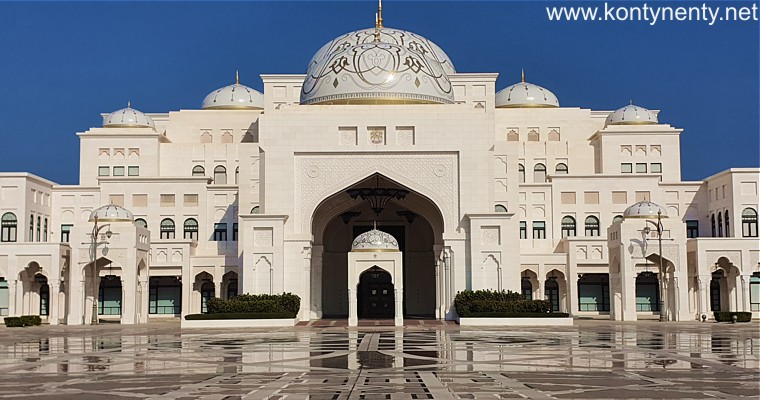 |
||
|
But that was just an overture. I entered the elaborate colonnades and finally - inside, to be amazed by the splendor of the decoration and the size of the building - comparable to the largest cathedrals... Look for yourself! And the Sultan? The Sultan does not live here at all. Apparently no one knows where! |
Ale spojrzenie z zewnątrz było tylko uwerturą. Wszedłem pod misterne kolumnady i w końcu - do środka, by zadziwić się przepychem zdobienia i rozmiarami budowli - porównywalnymi z największymi katedrami... Sami popatrzcie! A sułtan? Sułtan wcale tu nie mieszka. Podobno nikt nie wie gdzie! |
|
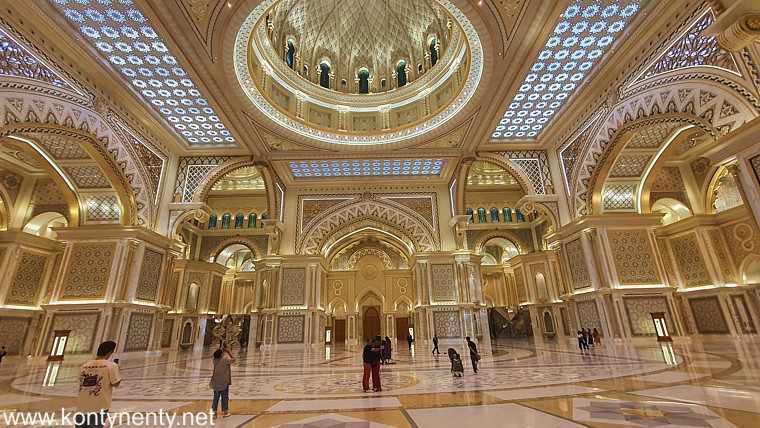 |
||
|
There are few cities to visit in the UAE, apart from the capitals of the individual emirates. The exception is the oasis of Al Ain on the border of Oman. I went there on a day trip by public bus, leaving every hour from the central bus station in Abu Dhabi. The journey without stops took 2 hours each way, a one-way ticket 40 dirhams. Today's Al Ain turned out to be a slim town, with a neat mosque on the main street: |
W UAE poza stolicami poszczególnych emiratów niewiele jest miast do zwiedzania. Wyjątkiem jest oaza Al Ain przy granicy Omanu. Pojechałem tam na całodzienną wycieczkę publicznym autobusem, odjeżdżającym co godzina z centralnej stacji autobusowej w Abu Dhabi. Podróż bez przystanków trwała 2 godziny w każdą stronę, Bilet one-way kosztował 40 dirhamów. Dzisiejsze Al Ain okazało się schludnym miasteczkiem, ze zgrabnym meczetem przy głównej ulicy: |
|
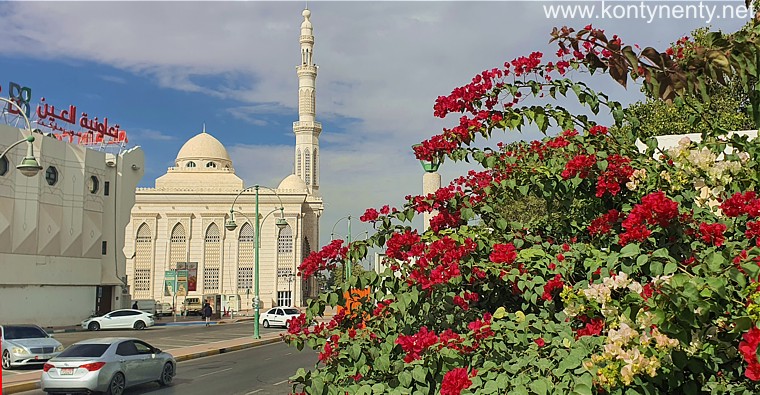 |
||
|
The main attraction that attracts tourists to Al Ain is the camel market. I had the location of this market marked on a digital map and I walked there from the bus station, photographing date palm plantations along the way. The distance was about 3 kilometers. When I got there, it turned out that the market in this place had long since disappeared - it had been moved behind the Bawadi Mall - far out of town. Bus 900 goes there. The market is huge, but civilized: There are several rows of prefabricated shelters here, housing several hundred camels: |
Główną atrakcją, która przyciąga turystów do Al Ain jest targ wielbłądów. Miałem naniesioną lokalizację tego targu na cyfrowej mapie i pomaszerowałem tam ze stacji autobusów, fotografując po drodze plantacje daktylowych palm. Odległość wynosiła jakieś 3 kilometry. Na miejscu okazało się, że w tym miejscu targu dawno już nie ma - przeniesiono go za centrum handlowe Bawadi Mall - daleko za miasto. Dojeżdża tam autobus 900. Targ jest olbrzymi, ale cywilizowany: W kilku szeregach stoją tu prefabrykowane wiaty mieszczące kilkaset wielbłądów: |
|
|
|
||
|
In the shade under the shelters, camels of various colors, sexes and temperaments await buyers. Old and tiny, just born. When a serious customer shows up, they are taken out onto the square so that he can take a closer look at them. I asked about prices - they start at $1,000 per mount: |
W cieniu pod wiatami czekają tu na nabywców wielbłądy różnych kolorów, płci i temperamentu. Leciwe i malutkie, dopiero co urodzone. Gdy pojawia się poważny klient są wyprowadzane na plac, aby mógł się im dokładnie przyjrzeć. Pytałem o ceny - zaczynają się od 1000 dolarów za wierzchowca: |
|
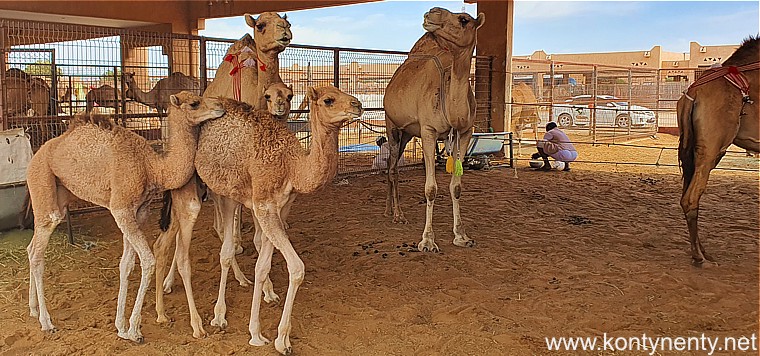 |
||
|
The primitive people who guard the camels are very happy to take a picture of you with the animals. But then they ask timidly for money. I disappointed them because I didn't have any cash with me - I bought bus tickets using a card. It is worth mentioning that opposite the shelters with the camels there are those that house smaller animals: sheep, goats and donkeys. |
Prymitywni ludzie, którzy pilnują wielbłądów bardzo chętnie zrobią wam zdjęcie ze zwierzętami. Ale potem pytają nieśmiało o pieniądze. Rozczarowałem ich, bo żadnej gotówki ze sobą nie miałem - bilety autobusowe kupowałem używając karty. Warto wspomnieć, że naprzeciwko wiat z wielbłądami stoją takie, które mieszczą drobniejsze zwierzęta: owce, kozy i osły. |
|
 |
||
|
The next day I went with a group organized by an agency from Abu Dhabi to a specially built camp in the desert to experience the attractions of Arabia in a nutshell. It is a popular entertainment offered to foreign tourists. From many options you can choose a luxury one - with transport in a private 4x4 car, with your own guide and good food or the budget one (150 dirhams) which I could afford :) Some agencies offer also overnight stay in the tents in the desert. |
Kolejnego dnia wybrałem się z grupą organizowaną przez agencję z Abu Dhabi do specjalnie zbudowanego campu na pustyni, aby doświadczyć tam atrakcji Arabii w pigułce. To popularna rozrywka, oferowana cudzoziemskim turystom. Spośród wielu wariantów można sobie wybrać luksusowy - z transportem w prywatnym samochodzie 4x4, z własnym przewodnikiem i dobrym jedzeniem lub ten budżetowy (150 dirhamów) na który mnie było stać :) |
|
|
|
||
|
The good thing about such an event is that the client is picked up from a chosen hotel in Abu Dhabi and dropped off in the evening at the same place. We set off at 3:00 PM and after an hour's drive towards Al Ain we turned onto an off-road road heading into the desert. They soon dropped us off at the camp fence, where the off-road vehicles were waiting. They packed us 4 people into the car and the Arab driver set off hard towards the dune. It was supposed to be a driving show in a large sandbox. Breakneck descents and ascents in clouds of sand... After 15 minutes the squealing girls in the back seat had had enough and the driver pulled over for another shift. And we were offered sandboarding - sliding on a board on the sand! :) |
Dobrą stroną takiej imprezy jest odbieranie klienta z wybranego hotelu w Abu Dhabi i odstawianie go wieczorem w to samo miejsce. Wyruszyliśmy o 15.00 i po godzinie jazdy w kierunku Al Ain skręciliśmy na terenową drogę, kierująca się w pustynię. Wysadzili nas wkrótce przy płocie campu, gdzie czekały terenowe samochody. Zapakowali ns po 4 osoby do wozu i kierowca-Arab ruszył ostro na diunę. To miał być pokaz jazdy w wielkiej piaskownicy. Karkołomne zjazdy i podjazdy w tumanach piasku.... Po 15 minutach piszczące dziewczyny na tylnym siedzeniu miały już dość i kierowca zjechał po następną zmianę. A nam zaproponowano sandboarding - zjeżdżanie na desce po piasku! :) |
|
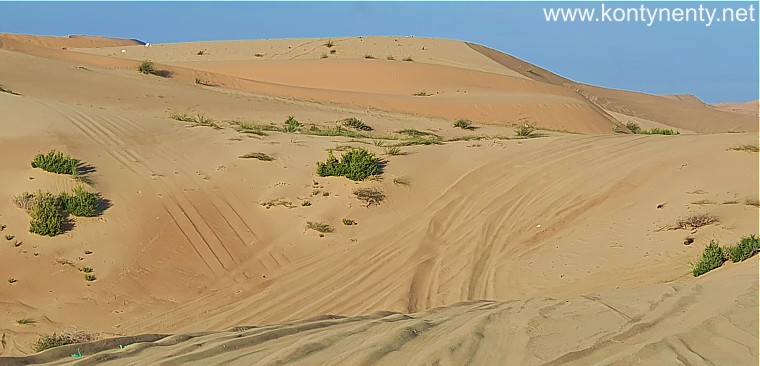 |
||
|
Above is the best photo I managed to take while riding a jeep through the dunes. In our group, no one wanted to try sandboarding, so they suggested we ride a quad bike through the sand. Two by two, changing after a few minutes. The back seat is not the best choice, so it's better to wait until your partner does his round and gives you the wheel: |
Powyżej pokazuję najlepsze zdjęcie, jakie udało mi sie zrobić podczas jazdy jeepem po diunach. W naszej grupce nikt nie zamierzał próbować sandboardingu, więc zaproponowali nam jazdę quadem po piasku. Dwójkami, ze zmianą po kilku minutach. Tylne siedzenie nie jest najlepszym wyborem, więc lepiej odczekać aż partner zrobi swoją rundę i odda nam kierownicę: |
|
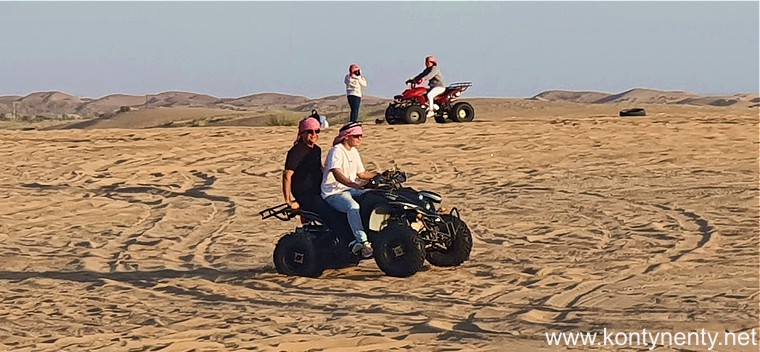 |
||
|
The organizers try to milk tourists for extra money at every turn: you pay extra for extra minutes of riding, and also for a head scarf, because how can you take a picture of yourself on a camel without one? Tying a dirty camel scarf on your head costs 35 dirhams. Don't you have the cash? They have a terminal and here, in the desert, you can pay by card (picture on the right column): |
Organizatorzy próbują wydoić z turystów dodatkowe pieniądze na kazdym kroku: płaci się extra za dodatkowe minuty jazdy, a także za zawój na głowę, bo jakże to fotografować się na wielbłądzie bez zawoju? Zawiązanie na głowie brudnej arafatki kosztuje 35 dirhamów. Nie masz gotówki? Oni mają terminal i tu, na pustyni możesz zapłacić kartą: |
|
|
|
|
|
|
The price of the event includes a small henna tattoo, but you have to pay extra for a bigger one (photo on the left, above). A short camel ride is also included, but if you want to ride on a small dune, you have to pay extra. The camels used here have two-person saddles. For safety reasons, they have colorful muzzles on their mouth. Unfortunately, this does not make them look any better: |
W cenę imprezy wliczone jest wykonanie małego tatuażu z henny, ale za większy trzeba zapłacić dodatkowo (zdjęcie po lewej, powyżej). Krótka przejażdżka na wielbłądzie jest też wliczona, ale jeśli chcesz wjechać na niewielką diunę to trzeba już dopłacić. Używane tu wielbłądy mają dwuosobowe siodła. Ze względu bezpieczeństwa mają założone na pyski kolorowe kagańce. Niestety nie dodaje to im urody: |
|
 |
||
|
The camp staff doesn't hesitate to take pictures of them. They look very attractive in the setting sun! They point out where you can get free drinking water, tea and finally the included dinner, served on plastic, disposable plates. We line up with them to get the meal. They serve everyone the same - these are no delicacies, but you can satisfy your hunger. |
Obsługa campu nie wzbrania się przed robieniem im zdjęć. W zachodzącym słońcu wyglądają bardzo atrakcyjnie! Wskazują, gdzie można brać bezpłatną wodę do picia, herbatę i wreszcie wliczony dinner, serwowany na plastykowych, jednorazowych talerzach. Ustawiamy się z nimi w kolejce. Nakładają wszystkim to samo - nie sa to żadne delicje, ale głód można zaspokoić. |
|
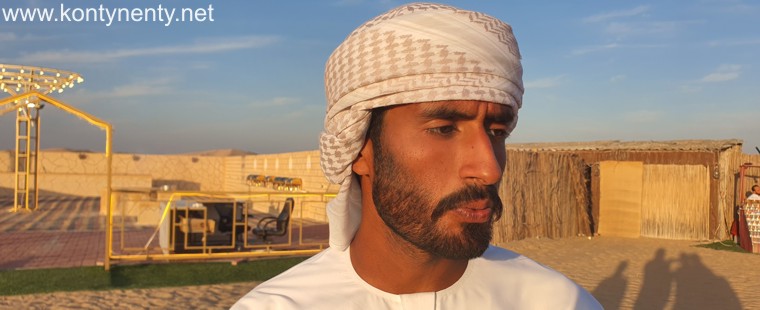 |
||
|
After dark, strong lights come on around the camp stage and the promised artistic program begins. First, we have the dance of the whirling dervish. His skirt is decorated with glowing diodes, which at a certain moment light up, making a big impression on the audience. How many minutes can you spin like that without stopping?... |
Po zmroku wokół estrady campu zapałają się silne światła i zaczyna się obiecany program artystyczny. Na początek mamy taniec wirującego derwisza. Jego spódnica zdobiona jest świecącymi diodami, które w pewnym momencie zapalają się, robiąc duże wrażenie na widowni. Ile minut można tak bez przerwy się kręcić?... |
|
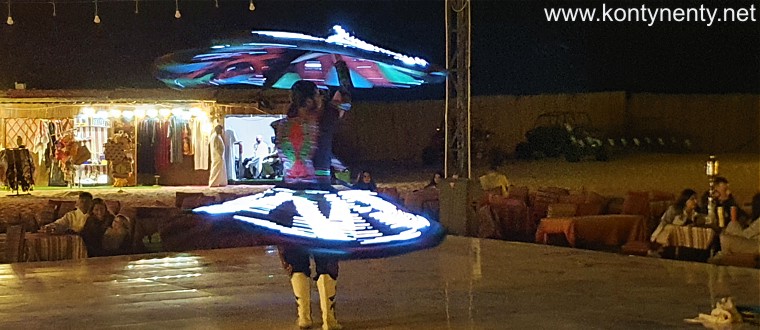 |
||
|
After the dancing dervish we watched the "fire dance" - a specialist in dancing with torches and poles that burn at both ends. Someone who had not seen similar performances on the Pacific islands before could be delighted. Some 30 years ago I was delighted on Samoa: |
Po tańczącym derwiszu oglądaliśmy "taniec ognia" - występował specjalista od tańca z pochodniami i drągami, które płoną na obu końcach. Ktoś, kto nie widział wcześniej podobnych widowisk na wyspach Pacyfiku mógł być zachwycony: |
|
|
|
||
|
The third and final performance was belly dancing. It was the first time I had seen this dance enhanced with torches held by a corpulent dancer. I know that Arabs like such round ladies, but in general it was a triumph of style over substance. The first time I saw such a dance was in 1973 in Baghdad. There were no torches, but the dancers really captivated the audience. The rules of dance are changing, as you can see... It's a pity... |
Trzecim i ostatnim występem był taniec brzucha. Po raz pierwszy widziałem ten taniec wzbogacony pochodniami, trzymanymi przez korpulentną tancerkę. Wiem, że Arabowie lubią takie okrąglutkie panie, ale generalnie był to przerost formy nad treścią. Po raz pierwszy widziałem taki taniec w 1973 roku w Bagdadzie. Nie było pochodni, za to tancerki naprawę porywały widzów. Reguły tańca jak widać się zmieniają... Szkoda... |
|
|
|
||
|
On Friday, my cruise ship appeared in the port of Abu Dhabi. It was the flagship of the "Costa" shipowner - the large and modern "Costa Smeralda", which could take 6,300 passengers on board. Fortunately, not everyone boarded at this port. You can get to the terminal in Abu Dhabi by city bus number 9. As a distinguished passenger of this line, I did not have to wait in a long queue to check-in. |
W piątek w porcie Abu Dhabi pojawił się mój wycieczkowiec. Był to flagowy statek armatora "Costa" - wielka i nowoczesna "Costa Smeralda", mogąca zabrać na pokład 6300 pasażerów. Na szczęście nie wszyscy wsiadali w tym porcie. Pod sam terminal w Abu Dhabi dojechać można miejskim autobusem numer 9. Jako zasłużony pasażer tej linii nie musiałem czekać w długiej kolejce do rejestracji. |
|
|
|
||
|
From Abu Dhabi we sailed to Dubai. This modern city has two passenger terminals located far apart from each other. During my last three stays, my ship was docked at Port Rashid. It was not the most advantageous location. This time I was luckier: "The Smeralda docked at the Palm Jumeira terminal. From the stern of our ship, the following view opened up of a wall of skyscrapers: |
Z Abu Dhabi popłynęliśmy do Dubaju. To nowoczesne miasto ma dwa oddalone od siebie terminale pasażerskie. Podczas trzech ostatnich pobytów mój statek był zacumowany w Port Rashid. Nie była to najkorzystniejsza lokalizacja. Tym razem miałem więcej szczęścia: "Smeralda zacumowała przy terminalu Palm Jumeira. Z rufy naszego statku otwierał sie taki oto widok na ścianę drapaczy chmur: |
|
 |
||
|
In the opposite direction, a view opened up of a "palm tree" made of sand with the residences of the rich on its "leaves" and the original silhouette of the Atlantis hotel. The shape of the palm tree can only be seen in aerial photos. The channel visible in the photo below is one of the water arms separating the leaves of the "palm tree": |
W przeciwnym kierunku otwierał się widok na usypaną z piasku "palmę" z rezydencjami bogaczy na jej "liściach" i oryginalną sylwetką hotelu Atlantis. Kształt palmy widać niestety tylko na lotniczych zdjęciach. Kanał widoczny na zdjęciu poniżej to jedno w wodnych ramion oddzielających od siebie liście "palmy": |
|
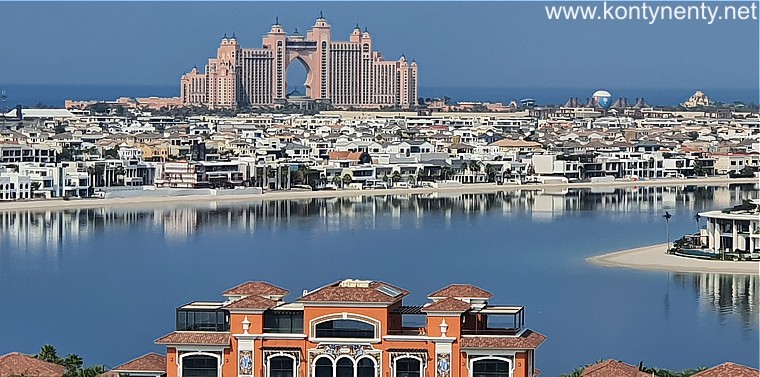 |
||
|
Dubai's tourist attractions are scattered. You can get to them by taxi from the port terminal, but that's expensive. It's much better to use the hop-on, hop-off buses. A full-day ticket (or a 2-day ticket if the ship is docks for longer time) allows you to travel from attraction to attraction, using commentary through headphones. There are three competing companies to choose from, and you can negotiate discounts. This time I paid 27 euros and went with them to the Burj Khalifa - the world's tallest building (828 m). Next to the building, dancing fountains are installed in an artificial pond, which are turned on several times a day. I watched an very impressive show at 1 p.m.: |
Turystyczne atrakcje Dubaju są rozrzucone. Z portowego terminalu można do nich dotrzeć taksówką, ale to jest kosztowne. Znacznie lepiej skorzystać z autobusów hop-on, hop-off. Całodzienny bilet (lub 2-dniowy, gdy statek stoi dłużej) pozwala jeździć od atrakcji do atrakcji, korzystając z komentarza płynącego przez słuchawki. Do wyboru są trzy konkurujące ze sobą firmy i można wynegocjować zniżki. Ja tym razem zapłaciłem 27 euro i dojechałem z nimi na początek do Burj Khalifa - najwyższego budynku świata (828 m). Obok budowli w sztucznym stawie zamontowane są tańczące fontanny, uruchamiane kilka razy dziennie. Ja ogladałem efektowny pokaz o godz 13.00: |
|
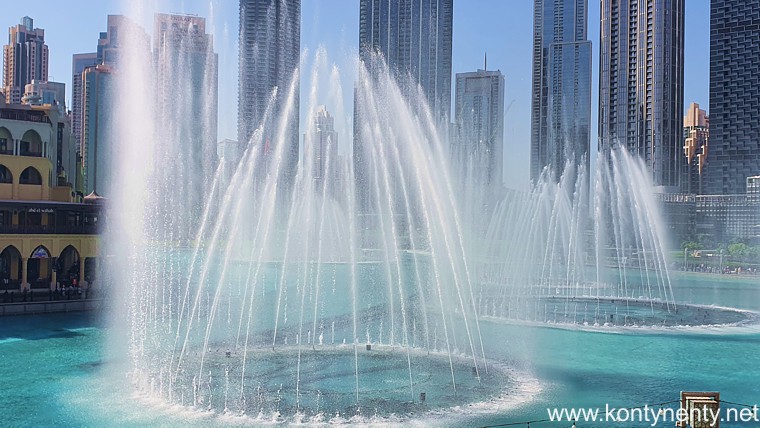 |
||
|
In modern Dubai, it is difficult to find Arabic folklore. But one night of sailing was enough to find myself in Muscat, the capital of Oman, where people dress traditionally and prefer an Arabic lifestyle. Right at the port gate, there is a market hall where you can take pictures of scenes like these: |
W nowoczesnym Dubaju trudno znaleźć arabski folklor. Ale wystarczyła jedna noc żeglugi, aby znaleźć się w Maskacie - stolicy Omanu, gdzie ludzie ubierają się tradycyjnie i preferują arabski styl życia. Tuż przy portowej bramie jest tam hala targowa, gdzie można fotografować takie sceny: |
|
|
|
||
|
From the market hall I set off along the well-known route through the seaside promenade to the bazaar and further on towards the Sultan's palace, about 3 kilometres away. I had arrived on a special day - the city was decorated with the flags of Oman and Bahrain. The Emir of Bahrain was due to visit in the afternoon. Preparations were underway in the palace area for a ceremonial welcome for the foreign guest. A funny-dressed brass band was having its last rehearsal: |
Z hali targowej wyruszyłem dobrze znanym szlakiem przez nadmorską promenadę na bazar i dalej - w kierunku odległego o około 3 kilometry sułtańskiego pałacu. Trafiłem na wyjątkowy dzień - miasto było udekorowane flagami Omanu i Bahrajnu. Po południu miał przybyć z wizytą emir Bahrajnu. w okolicach pałacu trwały przygotowania do paradnego powitania zagranicznego gościa. Zabawnie ubrana orkiestra dęta miała ostatnią próbę: |
|
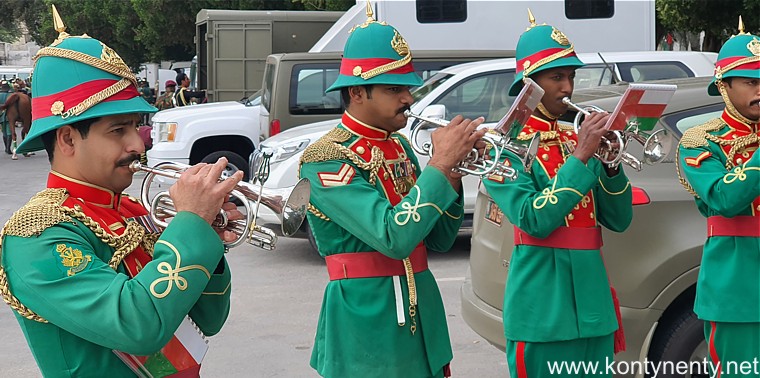 |
||
|
The Emir was to be escorted by the Omani mounted guard. I didn't know that such a military formation existed in Oman! The horses were dressed in embroidered saddle cloths with the Sultan's coat of arms. I was surprised to see armed soldiers stationed about every 50 meters along the Emir's entire route. That was several kilometers! What do you think; what were they afraid of? |
Emira miała eskortować omańska konna gwardia. Nawet nie wiedziałem, że Omanie istnieje taka formacja wojskowa! Konie były przybrane w wyszywane czapraki z sułtańskim herbem, zachowywały się spokojnie. Zaskoczeniem dla mnie byli uzbrojeni żołnierze rozstawieni mniej więcej co 50 metrów wzdłuż całej trasy przejazdu emira. To było kilka kilometrów! Jak myślicie; czego się obawiano? |
|
|
|
||
|
Then I met a caravan of 40 beautifully dressed camels also waiting for the emir. The uniformly dressed drivers were unarmed, but they did not want to be photographed... And where are the photos of Muscat's monuments? - you ask. Well, you will find them in the report from last year's trip - here. Just click! |
Potem spotkałem karawanę 40 pięknie przybranych wielbłądów także czekających na emira. Jednolicie ubrani poganiacze nie byli uzbrojeni, ale nie chcieli się fotografować... A gdzie zdjęcia zabytków Maskatu? - zapytacie. Ano znajdziecie je w sprawozdaniu z ubiegłorocznej podrózy - o tutaj. Wystarczy kliknąć! |
|
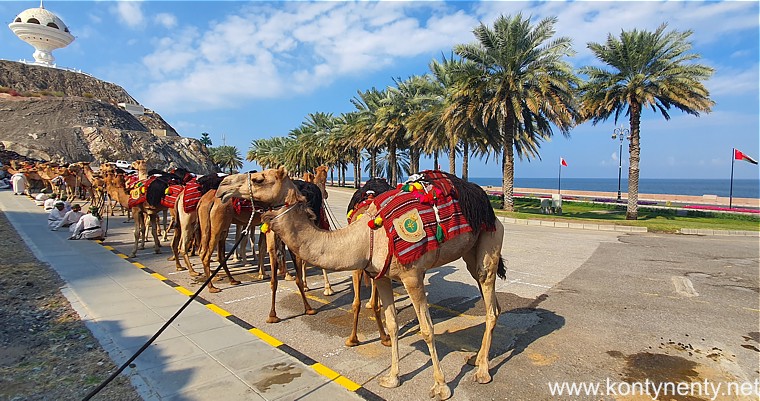 |
||
|
That evening we said goodbye to Oman, taking a course north. The next day was spent at sea. It was a day of respite from running around on land, with time for sunbathing and numerous entertainments. A grand spectacle was shown in the amphitheater at the stern, enriched by lighting effects: |
Wieczorem tego dnia pożegnaliśmy Oman, biorąc kurs na północ. Następny dzień spędziliśmy w morzu. Był to dzień wytchnienia od biegania po lądzie, z czasem na kąpiele słoneczne i liczne rozrywki. W amfiteatrze na rufie pokazano wielkie widowisko, wzbogacone efektami świetlnymi: |
|
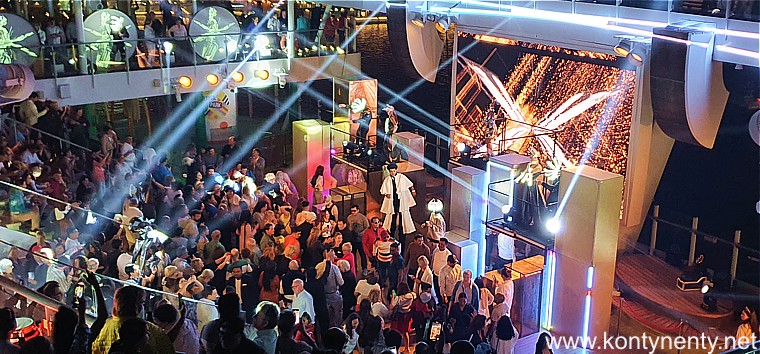 |
||
|
I also had the opportunity to meet new friends: the nice Kadinski family from Macedonia. They also travel a lot. During the conversation about our plans it turned out that they are also going to the Far East next year. I will be happy to see you again in Hong Kong on board "Costa Serena" dear friends! |
Miałem też okazję poznać nowych przyjaciół: to sympatyczna rodzina Kadinski z Macedonii. Oni też dużo podróżują. w trakcie rozmowy o naszych planach okazało się, że oni też wybierają się za rok na Daleki Wschód. Do miłego zobaczenia w Hongkongu, na pokładzie "Costa Serena" drodzy przyjaciele! |
|
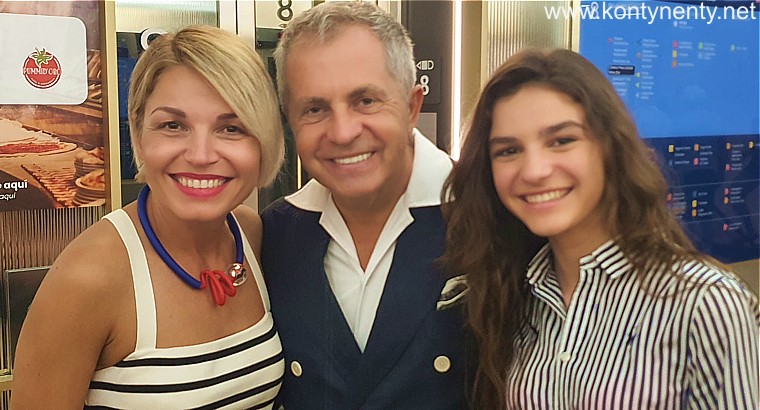 |
||
|
I also had finally the opportunity to meet our captain GianFranco. He was my forty-fourth captain... He was impressed by my travel achievements. -You've been to the legendary Pitcairn Island twice? You probably know all 50 inhabitants of this remote island? |
Miałem też okazję, by poznać w końcu naszego kapitana GianFranco. To był mój czterdziesty czwarty kapitan... Był pod wrażeniem mojego dorobku podróżniczego. -Był pan dwa razy na legendarnej wyspie Pitcairn? To zna Pan chyba wszystkich 50 mieszkańców tej odległej wyspy? |
|
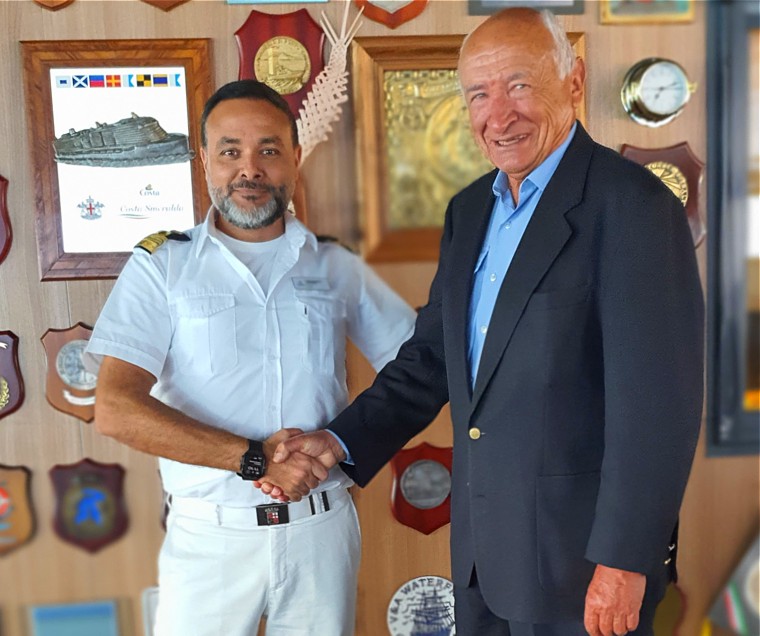 |
||
|
The last port on our cruise route was Doha - the capital of Qatar. I had only been to Qatar once before - in 1996 - almost 30 years had passed! No wonder I was eagerly awaiting the confrontation of the past with the present. Doha welcomed us with... fog, through which the new downtown skyscrapers were very hard to see. |
Ostatnim portem na trasie naszego rejsu była Doha - stolica Kataru. W Katarze byłem dotychczas tylko raz - w 1996 roku - upłynęło prawie 30 lat! Nic dziwnego, że z ciekawością oczekiwałem konfrontacji przeszłości z teraźniejszością. Doha powitała nas... mgłą, przez którą bardzo słabo było widać nowe wieżowce downtown. |
|
|
|
||
|
On the way to the city centre there is the cubic Museum of Islamic Art and – further on – the old port, where a row of dhows – wooden Arab boats used today to carry tourists – are moored. At the entrance to this old port stands a monument showing a pearl in an open shell. It is a reminder that before oil and gas were exploited, the only industry that operated here was pearl fishing. I remember this monument from my first visit to Qatar. Only then there were no skyscrapers: |
Po drodze do centrum miasta jest kubiczne Muzeum Sztuki Islamskiej i - dalej - stary port, gdzie cumują rzędem dhows - drewniane arabskie łodzie, wykorzystywane dziś do wożenia turystów. U wjazdu do tego starego portu stoi pomnik pokazujący perłę w otwartej muszli. Przypomina, że zanim zaczęto eksploatować ropę i gaz jedynym przemysłem, który tu funkcjonował były połowy pereł. Pamiętam ten pomnik z mojej pierwszej wizyty w Katarze. Tylko że wtedy nie było tych wieżowców: |
|
|
|
||
|
There is a residential area in Doha called Pearl Island, which is proudly shown to tourists, but I preferred to see the Emir's palace, which stands on a small hill next to the bazaar part of the city. The building is low but wide. Next to it stand a clock tower and a mosque: |
Jest w Doha dzielnica rezydencyjna Pearl Island, którą pokazuje się z dumą turystom, ale ja wolałem zobaczyć raczej pałac emira, stojący na niewielkim pagórku obok bazarowej części miasta. Budowla jest niska, ale szeroka. Obok niej stoą zegarowa wieża i meczet: |
|
|
|
||
|
It is forbidden to approach the palace, but no one forbids taking pictures from a distance. When I got there, a column of camels was passing on the lawns in front of the palace. I don't know. whether the unit is deliberately patrolling the palace area, whether it is a show of wealth and power, or maybe the camels are walking on the lawn just to stretch their legs :) |
Do pałacu nie wolno się zbliżać, ale nikt nie zabrania robienia zdjęć z odległości. W chwili, gdy się tam znalazłem po trawnikach przed pałacem przechodziła kolumna wielbłądów. Nie wiem. czy oddział celowo patroluje okolice pałacu, czy jest to demonstracja bogactwa i siły, czy też może wielbłądy spacerują po trawniku, aby rozprostować nogi :) |
|
|
|
||
|
The old souk in Doha (pictured below) is clean and has a nice atmosphere. On the edge of it is a small camel market and stables where you can see Arabian horses. The square in front of the souk is where buses bring tourists from cruise ships and others. This is also where the Hop-on, hop-off bus stop is located. For a full day of riding they charge $55: |
Stary suk w Doha (na zdjęciu poniżej) jest czysty i ma swój ciekawy klimat. Na jego skraju jest niewielki targ wielbłądów i stajnie, w których można zobaczyć arabskie konie. Plac przed sukiem to miejsce, gdzie autobusy przywożą turystów ze statków wycieczkowych i nie tylko. Tu jest także zlokalizowany przystanek autobusów Hop-on, hop-off. Za cały dzień jeżdżenia żądają 55 USD: |
|
|
|
||
|
Doha’s bazaar was not created for tourists, although they are becoming more common. The narrow streets still sell more household goods than souvenirs. |
Bazar w Doha nie został stworzony dla turystów, choć widać ich tu coraz więcej. W wąskich uliczkach sprzedaje się wciąż więcej artykułów gospodarstwa domowego niż pamiątek. |
|
|
|
||
|
There are cafes and teahouses in the bazaar. If you need a clean toilet, you can easily find one. There are also craft shops. I managed to catch a glimpse of a scene from a tailor's shop. It may be interesting to us that women's clothes are sewn here exclusively by men: |
W obrębie bazaru działają kawiarnie i herbaciarnie. W razie potrzeby łatwo można odnaleźć czystą toaletę. Są tu także zakłady rzemieślnicze. Udało mi sie podpatrzyć scenę z zakładu krawieckiego. Ciekawe dla nas może być to, że damskie stroje szyją tu wyłącznie mężczyźni: |
|
|
|
||
|
Souk is the Arabic word for Bazaar. The souk in Doha has something that other Arab bazaars do not have: falcons - the favorite birds of the Arabs, used for playing and hunting. Here they are sold, and also treated in a mini-hospital if they require it. The fate of these beautiful birds is sad, however: they sit on poles in hoods that cover their eyes: |
Bazar to po arabsku suk. Suk w Doha ma coś, czego nie maja inne arabskie bazary: sokoły - ulubione ptaki Arabów, używane do zabawy i polowania. Tu się je sprzedaje, a także leczy w mini-szpitalu, jeśli tego wymagają. Los tych pięknych ptaków jest jednak smutny: siedzą na drążkach w kapturach, zasłaniających im oczy: |
|
|
|
||
|
This strange fog hung over Doha until the evening. Only when we were leaving the port after dark could I take a picture of the line of illuminated skyscrapers on the coast. It was a farewell to Qatar - I don't know if it will last long... |
Ta dziwna mgła nad Dohą wisiała aż do wieczora. Dopiero, gdy po zmroku wychodziliśmy z portu mogłem zrobić zdjęcie linii podświetlonych wieżowców na wybrzeżu. To było pożegnanie Kataru - nie wiem czy na długo... |
|
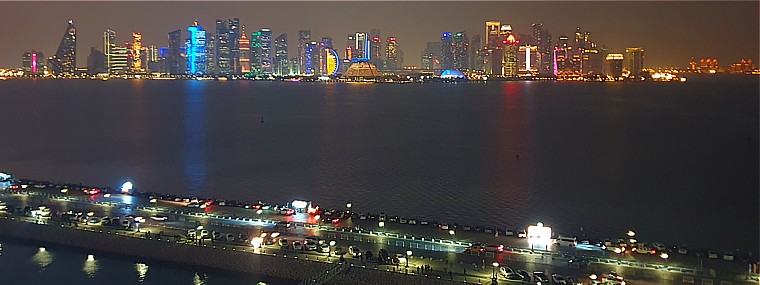 |
||
|
After disembarking in Abu Dhabi (don't forget that there is a one-hour time difference between Qatar and the Emirates), I had one free day before my flight. I decided to use it to visit recently opened the Louvre Abu Dhabi. Yes! The wealthy Emirates have given themselves a large, modern gallery and named it the Louvre - after the famous Parisian museum. The Louvre Abu Dhabi surprises with its extraordinary architecture from the outside: it is covered entirely with a huge, flattened dome with an unusual texture: |
Po zejściu ze statku w Abu Dhabi (nie zapomnijcie, że między Katarem i Emiratami jest jedna godzina różnicy czasu) miałem jeszcze przed odlotem jeden wolny dzień. Postanowiłem wykorzystać go na odwiedzenie niedawno otwartego Luwru Abu Dhabi. Tak! Bogate Emiraty zafundowały sobie wielką, nowoczesną galerię i nazwały ją Luwrem - na wzór słynnego paryskiego muzeum. Luwr Abu Dhabi już z zewnątrz zaskakuje niezwykłą architekturą: cały nakryty jest olbrzymią, spłaszczoną kopułą o niezwykłej fakturze: |
|
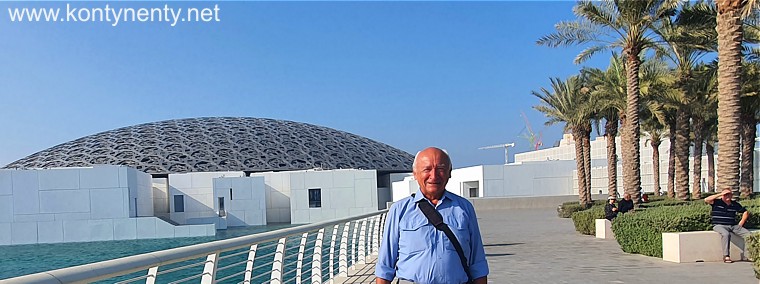 |
||
|
Only inside can one fully appreciate the extraordinary nature of this dome. From this side, it looks like a tangled thicket of branches, in the cracks of which one can see patches of blue sky. I have never seen such a structure anywhere else in the world: |
Dopiero we wnętrzu można w pełni docenić niezwykłość tej kopuły. Z tej strony wygląda jak splątany gąszcz gałęzi w którego szczelinach widać skrawki błękitnego nieba. Nigdzie w świecie nie widziałem takiej oryginalnej konstrukcji: |
|
|
|
||
|
The entrance fee to the museum is 65 dirhams. This is quite a lot for me. Luckily, there was a resident who managed to reduce this amount by half. My openness to people from other countries sometimes pays off in this way. The exhibition halls house an impressive collection of art from different countries and different periods of history. And in the central hall for temporary exhibitions, the paintings of French post-impressionists were a feast for the eyes. It was worth coming there! |
Za wstęp do muzeum trzeba zapłacić 65 dirhamów. To dla mnie spora kwota. Na szczęście znalazł się rezydent, dzięki któremu udało się zredukować tę kwotę o połowę. Moje otwarcie na ludzi innych krajów czasem procentuje w ten sposób. W salach wystawowych zgromadzono imponującą kolekcję sztuki różnych krajów i różnych okresów historii. A w centralnej sali przeznaczonej dla wystaw czasowych cieszyły oczy obrazy francuskich postimpresjonistów. Warto było tam przyjechać! |
|
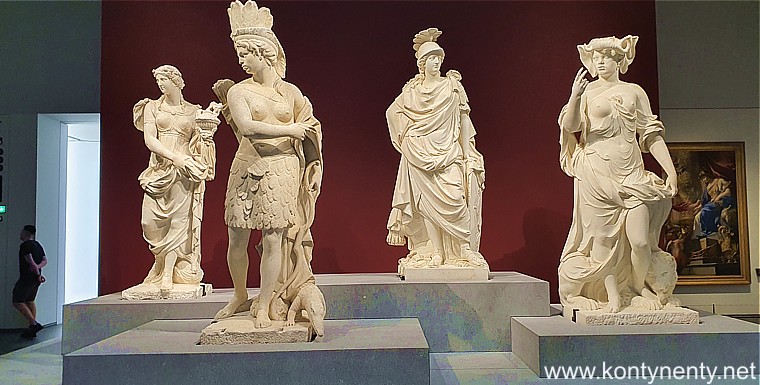 |
||
|
|
Po wyjściu z "Luwru" spotkałem w parku, pod palmami ciekawą parę z Kenii. Przylecieli tu z Nairobi. Gdy dowiedzieli się, że byłem kilka razy w ich kraju nawiązała się ciekawa rozmowa. Mile ich wspominam... Z Abu Dhabi z jedną tylko przesiadką w Larnace poleciałem prosto do zimnego Gdańska. I to był już konie kolejnej ciekawej podróży! After leaving the Louvre, I met an interesting couple from Kenya in the park under the palm trees. They had flown here from Nairobi. When they learned that I had been to their country a few times, an interesting conversation began. I remember them fondly... From Abu Dhabi, with only one stopover in Larnaca, I flew straight to cold Gdansk. And that was the end of another interesting journey! |
|
|
As always, you will find the "hot" news from the route of this trip in English in my travel log. Draft of the route map is here |
Zapisane "na gorąco" wiadomości z trasy tej podróży znajdziecie jak zawsze w moim dzienniku podróży. Jej szkicowa mapka jest tutaj. |
|
|
Between the voyages I am giving lectures and slide-shows in the clubs and public libraries around Poland. The money I earn on this way is always converted into the new air tickets. In the International Sailor's Club "Zejman" I was talking about the Far North of Russia, and recently - about my 12th Voyage around the world:
"Zejman" has a very special atmosphere. It is the meeting place of the sailors and travelers located in the heart of the Old Town in Gdansk. Recently I had there a lecture about Tonga - the last kingdom in the Pacific. |
Okresy między podróżami wykorzystuję także na prelekcje i spotkania autorskie w klubach i bibliotekach. Zazwyczaj takie imprezy połączone są z promocją mojej książki "Na siedem kontynentów". Mile do dziś wspominam właśnie takie perfekcyjnie zorganizowane spotkanie w Wojewódzkiej Bibliotece Pedagogicznej w Słupsku:
W gdańskim klubie "Zejman" opowiadałem kiedyś o arktycznej Rosji (fot. obok), a ostatnio także o Tonga - ostatnim królestwie na Pacyfiku. |
|
|
My website is winning more and more fans... At the beginning of the year 2003 the counter installed on my web pages took down 90 thousands calls. In June 2006 I had the celebration - it reached a million! In January, 2023 counter showed 5,000,000 page views. I think it is quite a lot concerning such a private website. The statistics are also interesting: most of the calls (about 70%) come from Poland. From abroad most guests comes from Great Britain and France. At the end of the rank unexpectedly appeared residents of very strange countries like Taiwan, Mexico and Saudi Arabia... In my own country most visitors come from Warsaw, Cracow, Wroclaw and from my home Gdansk. It is real problem for me when to translate my www pages to English. So far only about 15 percent of them are translated, I have not enough time and nobody wants to help me. Pity! I would like to share my travel knowledge also with the people from abroad. Regarding pages not translated to English: there is still a lot of pictures to see. I was working hard to complete my web pages: you can spend many hours in front of the screen... I hope that many people will take the advantage of my experience... And they do... Unfortunately there are also journalists who copy parts of my pages, then they add something and publish the whole story as their text... Shame, ladies and gentlemen... I am also receiving a lot of e-mails with questions related to travel - not only from Poland but also from the world... I try to response every letter but unfortunately I cannot spend to much time for this - a lot of other activities is waiting for me... I fall behind with publishing reports from my consecutive journeys. I recorded the radio program, talking about my recent travels and I gave also an interview for the Polish site in Vilnius - Lithuania - you can read it here. After years "Poznaj Świat" ("Discover the world") magazine published again my article - about Ogasawara Islands. There were also my articles about Egyptian Sahara in "Rzeczpospolita" ("The Republic") and my "Terres Australes" piece (Crozet & Kerguelen Is.) published in "Podróże" magazine. More on my writing you will find on the web page "my publications" and full listing of recently published articles on: "ARTICLES" . I spend my life now mostly writing. Lectures and the slide-shows after the pandemic are practically suspended. Readings and preparations for the future voyages also take a lot of my time. Next targets are already defined. Love to all of you! July 29th, 2025 Wojtek |
Mój internetowy serwis zyskuje coraz więcej sympatyków... Na początku roku 2003 licznik zainstalowany na moich stronach odnotował 90 tysięcy wywołań. Na początku czerwca 2006 obchodziłem jubileusz: milionowe wywołanie mojego serwisu. W styczniu 2023 licznik pokazał 5 milionów wyświetleń mojej strony. Program statystyczny, który zainstalowałem na moich internetowych stronach pokazuje codziennie do 200 wywołań. Ciekawa jest statystyka tych wywołań: najwięcej, bo około 70% pochodzi z Polski. Spośród innych krajów najwięcej mam kolejno gości z Wielkiej Brytanii i Francji. Pod koniec listy pojawiają się ku mojemu zaskoczeniu bardzo dziwne kraje: Tajwan, Meksyk czy Arabia Saudyjska... W kraju najwięcej sympatyków mam w Warszawie, Krakowie, Wrocławiu i rodzinnym Gdańsku. Materiału w moim serwisie jest na wiele godzin oglądania - włożyłem w jego opracowanie bardzo dużo pracy z myślą o tym, by z moich doświadczeń mogli skorzystać inni globtroterzy... I korzystają... Niestety nie wszyscy korzystają z zawartości moich stron w dozwolony sposób - są tacy dziennikarze, którzy przepisują teksty z moich stron, dodają coś od siebie i... publikują całość podpisując swoim nazwiskiem... Doprawdy wstyd panie i panowie!... Dostaję e-mailem wiele pytań od podróżników, nie tylko z Polski ale i ze świata - staram się na wszystkie listy odpowiadać, ale niestety nie mogę na to poświęcić zbyt dużo czasu... Jak się zapewne domyślacie nie wszystkie listy są poważne... - czasem np. dostaję do rozwiązania zadania z geografii... Traktuję to z humorem... Nagrałem kolejną audycję radiową o moich podróżach i udzieliłem wywiadu dla polskiego portalu w Wilnie - możecie go przeczytać tutaj. Po latach miesięcznik "Poznaj Świat" znów opublikował mój artykuł - o japońskich wyspach Ogasawara. Ostatni mój artykuł w "Rzeczpospolitej" traktował o podróży przez Egipską Saharę. W "Podróżach" ukazał się mój artykuł o Francuskiej Subantarktyce - archipelagach Crozeta i Kerguelena. Więcej o moim pisaniu przeczytacie na stronie moje publikacje a pełny wykaz ostatnich artykułów na stronie ARTYKUŁY. Podróże i działalność publicystyczna wypełniają mi aż nadto mój czas. Nie nadążam z publikowaniem relacji z kolejnych wyjazdów. Kilka kolejnych ciekawych projektów nowych ekspedycji jest w opracowaniu - wiecie dobrze, że plany takich samotnych eskapad do rzadko odwiedzanych miejsc wymagają solidnego przygotowania... Są już wyznaczone następne cele. Pozdrawiam serdecznie Was wszystkich!
2025.07.29 Wojtek |
|
|
Travel snapshots from recent years --- Migawki z podróży ostatnich lat |
| 2022 | 2021 | 2020 | 2019 | 2018 | 2017 | 2016 | 2015 | 2014 | 2013 | 2010-2012 |
| 2023 | 2024 |
Back do the main directory Powrót do głównego katalogu